|
|
WILMER D. LEWIS LEASES THE DESOTO
HOTEL FROM J. H. THOMAS
In 1894,
W. D. Lewis leased
the
newly-built DeSoto
Hotel at the
corner of
Zack and
Marion
streets.
The hotel
was
completed
earlier that
year by
James Henry
Thomas, a
native of
Chillicothe,
Ohio who
came to
Tampa in
early 1893.
W. D.
achieved
great
success
and
notoriety as
the manager.**
His
lavishly
catered
events were
the talk of
Tampa, and it wasn't
long before
his
excellent
singing
voice caught
the
attention of
the local
papers,
guests, and
the people
of Tampa.
In the next
few years he
performed
yearly in
dozens of
local
concerts
with solo
numbers and
in a local
quartet, as
well as at
his church.
**In
these times,
the terms "manager,"
"proprietor,"
and "owner"
were used
interchangeably.
These
described
the owner
of the
business.
They may
have also
owned
the building
that the
business
operated
from, or
they may
have been
leasing
the building
from which
they
operated
their
business.
The latter
being the
situation
here with
W.D. Lewis,
who leased
the the
building
from J. H.
Thomas in
which the
DeSoto
operated.
Sanborn Fire
Insurance
Map
(modified)
courtesy of
Univ. of
Fla. Maps
Collection.
The 1895
Sanborn
map at
right
shows
the
original
three-story
wood
frame
hotel
with a
small
kitchen
at the
rear.
The
structure
extending
northward
may have
been an
outhouse. On the
other
corner
of the
block is
a vacant
dwelling
and an
occupied
dwelling
to the
south of
it on
Morgan
St.
On the
Northwest
corner
of the
block is
a wood
frame
two-story
building
with
shops on
the
first
floor
and
tenements
on the
2nd
floor.
The
shops
are: (L
to R)
tin
ware,
general
store,
restaurant,
milliner,
mattress
shop,
vacant,
and shoe
maker.
PRAISE FOR
THE DESOTO
HOTEL
MANAGEMENT
AND TALENT
In Jun.
1894, the
Tribune
wrote,
Why
They Flock
to the
DeSoto:
There is
a little
secret
about so
many
musical
entertainments
being
given at
the
hotel
DeSoto...Mr.
W. D.
Lewis,
the
proprietor,
is one
of the
best
bassos
in the
country,
and a
fine
performer.
Capt.
Thomas,
the
owner of
the
magnificent
building,
is a
musician
of no
mean
pretensions.
He plays
elegantly
on the
piano,
as well
as on
the
guitar
and
other
instruments.
It is no
wonder
people
find it
a
pleasant
place to
spend an
evening.
|
| |
| |
WHO
WAS W. D.
LEWIS?
Some of the
following
information
concerning
W. D.
Lewis's
early
ancestry and
education is from "Ohio's
Progressive
Sons, A
History of
the State,
Sketches of
those who
have helped
to build up
the
Commonwealth,"
pub. 1905 by
Queen City
Publishing
of
Cincinnati,
Ohio,
found
at Internet
Archive. |
Wilmer D.
Lewis lived
in Tampa for
about eight
years from
1890 to
1897. In
that time,
he became
well-known
for his
"basso
profundo"
singing
voice and
the first
and most
entertaining
manager of
the original
wood frame DeSoto
Hotel.
Afterward,
he and his
wife moved to
Louisville,
KY for a
short time
and then to
Dayton, Ohio,
where he
became one
of the
leading
vocal
musicians
and
professors
of music in
the first
decade of
the 20th
Century.
BACKGROUND
Wilmer D.
Lewis was
born in
Philadelphia
around
1846-1848.
His parents
lived for
many years
in his
native city
and occupied
a recognized
position in
the Quaker
City
society.
His father,
Lewis Lewis,
was a
native of
Scotland and member
of the
well-known
firm of
Wilmer, Cannell
& Co., and it is
from the
surname of
the senior
partner of
that firm
that
Wilmer's
given name
was
derived.
The Lewis
family was
particularly
well known
in church
circles,
with Lewis
Lewis
occupying
the position
of vestryman
of St.
Mark's
Episcopal
Church for
a period of
twenty
years. He
was a
descendant
of Sir
William
Blackstone's
brother, and
lawyers and
jurists in
his family
have been
numerous.
Wilmer's
mother, Mary
E. Dick, was
a native of
the city of
Chester,
Penn., and
a daughter
of Archibald
T. Dick,
Esq. Mary's
great-grandfather, Dr.
Elisha Dick,
was George
Washington's
physician,
and attended
that
illustrious
patriot
during his
last and
fatal
illness.
1860 Census,,
8th Ward, Philadelphia,
Penn.

The Lewis
family 1860
Census in
Philadelphia,
indicates
Wilmer was
born
c.1846-47, Lewis Lewis (b. ca. 1809-10, England) and Mary (b. ca. 1809-10, Penn.)
Lewis Lewis
was a rather
wealthy silk
merchant. Wilmer had two younger sisters: Anne (b. ca. 1852-53) and Florence (b. ca. 1855-56).
Wilmer
D. Lewis was
a gentleman
of culture
and natural
refinement,
and received
a very
careful
training and
education.
He was under
the
tutorship of
Rev. Dr. Faires, of
Philadelphia,
and also
attended the
Pennsylvania
University
in
Philadelphia.
Later, his musical
education
was obtained
under the
guidance of Enrico
Campobello,
the great
baritone,
and the
celebrated
Max Ballmann
of St. Louis, Mo.
WILMER
D. LEWIS
IN ST.
LOUIS
Wilmer
was in
St.
Louis by
the time
of the
1870
Census
in June,
probably
to study
music under
Max Ballmann. 1870 Census, St. Louis, Mo.
Wilmer D. Lewis
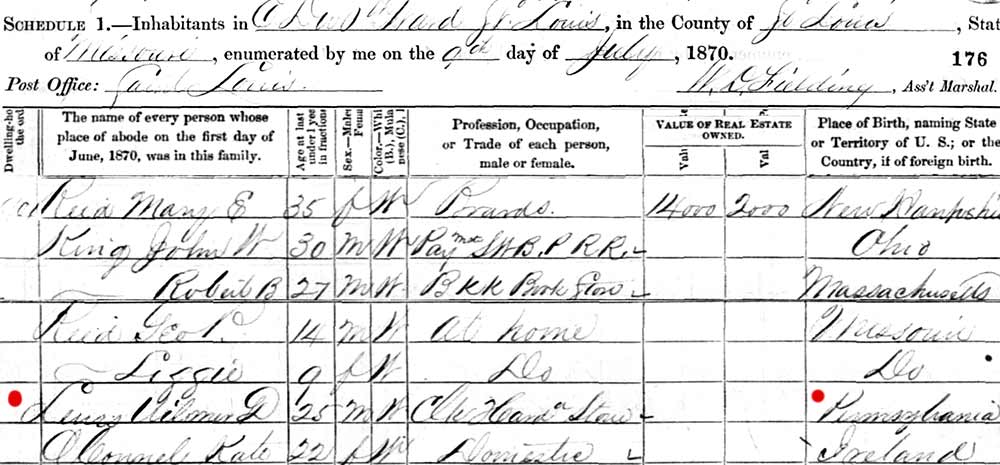
Wilmer was 25 years old, which results in a calculated birth year of 1844-45. He was working as a clerk in a
hardware store
and
living
in a
boarding
house
with
several
others
from
around
the
country
and one
female
from
Ireland.
WILMER IN THE CONCERT NEWS - ST. LOUISIt is here in St. Louis where Wilmer began his performance career.
|
|
On May 7, 1875, Wilmer appeared as a soloist with five others in a two-day series of Grand Oratorio concerts featuring works from Handel's Messiah and from Samson at the Methodist Church in St. Louis |
On the week of Nov. 22, 1875, as part of a grand two-week fundraiser for the Women's Christian Home, the Thackeray Dept. of the Pilgrim Congregational Church gave a dramatic entertainment of instrumental and vocal music. Wilmer was among the four soloists, as well as a member of the cast of characters in a two-act drama entitled "Mr. John Smith." Wilmer was the Ghost in "Hamlet." |
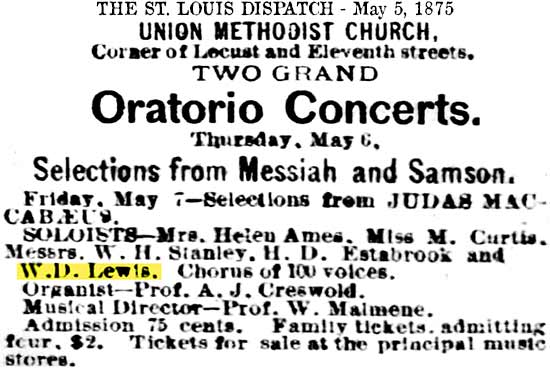 Below: This announcement on Dec. 19, 1875 was for a complimentary concert program to be held on the 23rd at the Mercantile Library Hall in honor of Mrs. Kate J. Brainard. Wilmer performed in a duet as well as two quartets and at the finale, in a chorus featuring all the voices. |
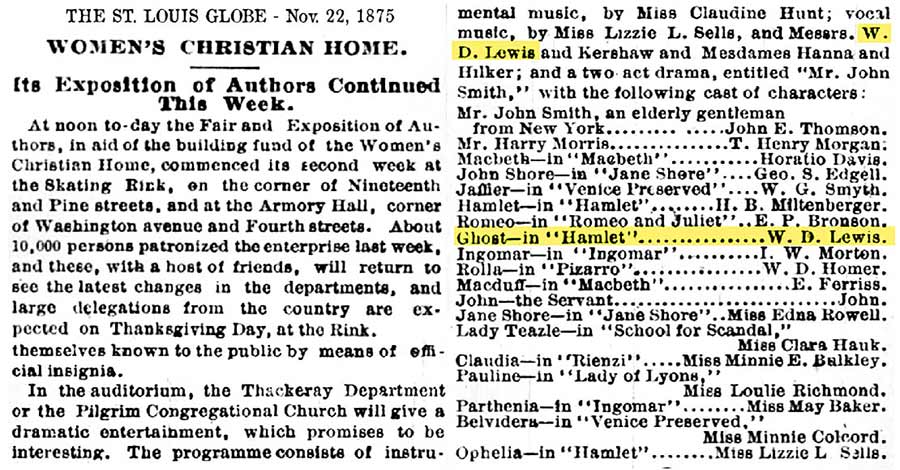
|
|
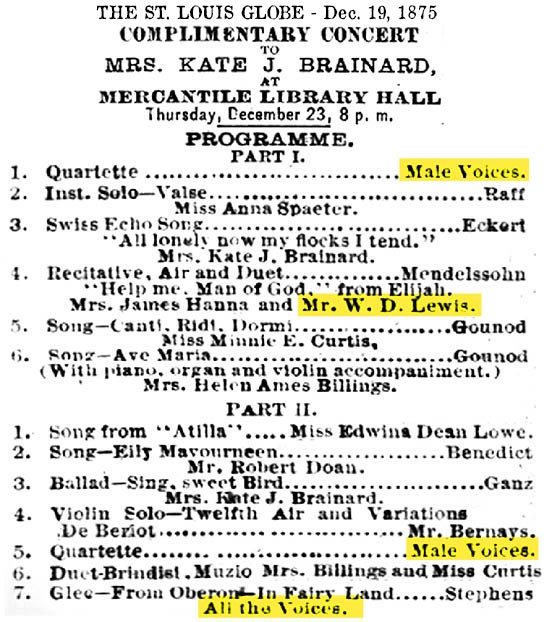
|
|
|
In a Christmas Eve article about the performance of the previous night, Wilmer was one of those described as "our best local talent." Unfortunately, attendance was small due to the weather. But the hearty reception given to all who performed compensated for the smaller audience. |
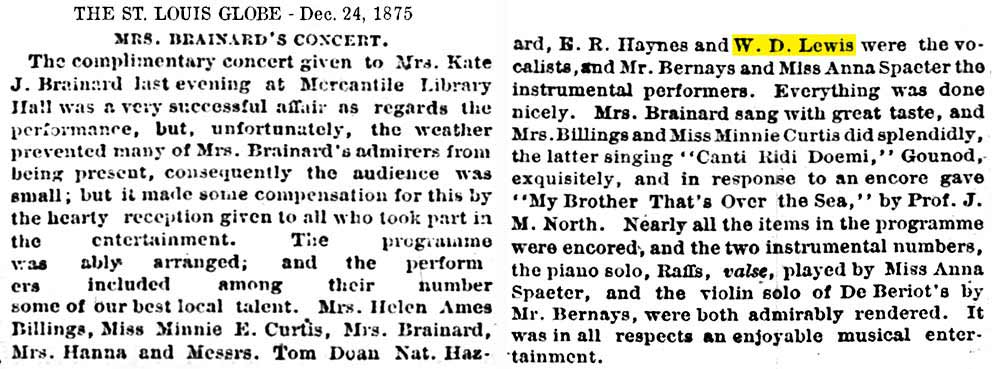 |
W. D.
LEWIS
COMES TO
FLORIDA
AND GETS
MARRIED
By 1879,
Wilmer
Lewis moved to
Florida,
probably
coming
from St.
Louis
down the
Mississippi
to New
Orleans,
then to
Cedar
Key by
steamer.
On the
22nd of
October,
1879,
W.
D.
Lewis
married in
Bronson,
Levy County,
to Miss
Annie I.
McIlvaine,
the
accomplished
daughter
of
Dr.
Robert
H.
McIlvaine
(the
leading
physician
of Cedar
Keys,
Florida)
and his
wife
Margaret
Bledsoe.
Bronson is
located
halfway
between
Cedar Key
and
Gainesville.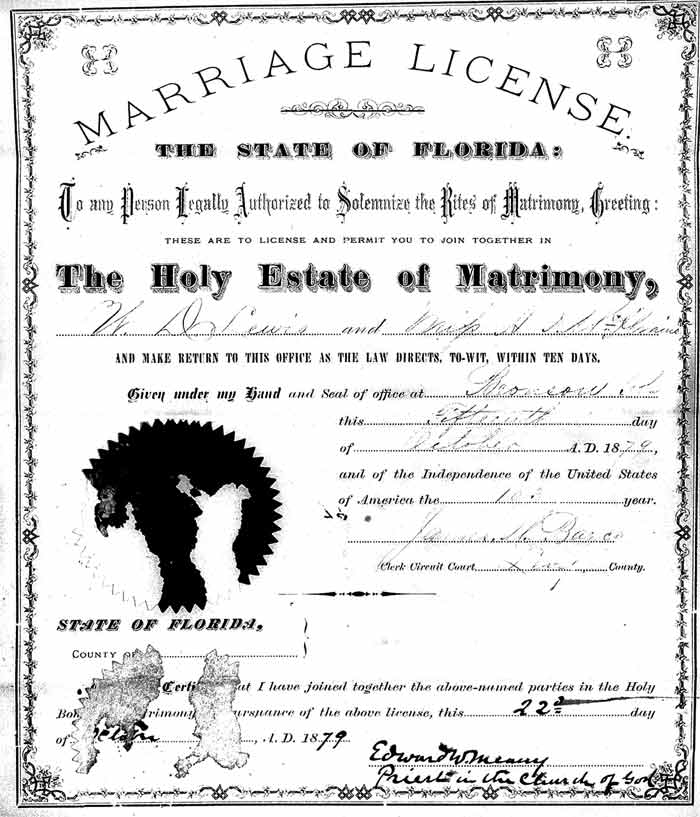
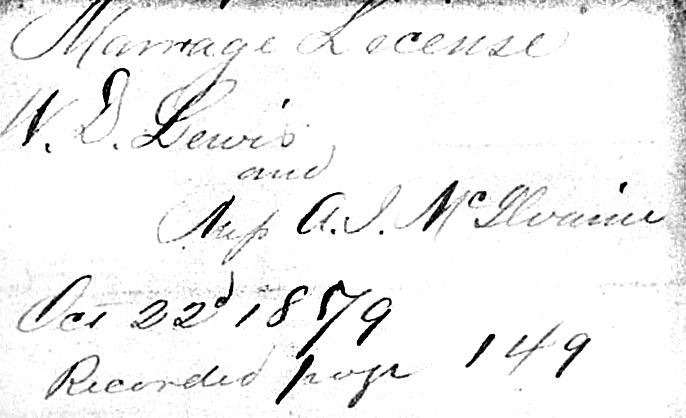 Marriage of
W. D. Lewis
to Miss A.
I. McIlvaine
as recorded
in Levy Co.
records,
Oct. 22,
1879. Marriage of
W. D. Lewis
to Miss A.
I. McIlvaine
as recorded
in Levy Co.
records,
Oct. 22,
1879.
The writing
on the
certificate
was very
faint.
Click the
image to see
it larger.
Wilmer would
spend the
next 10
years in
Lafayette
County and
Sumter
County at
Lake Panasoffkee
as a
successful
citrus
merchant and
orange grove
owner.
(Later
articles
will reveal
this.)
1880 Census,
Lafayette
Co., Fla.
Wilmer Lewis
and wife
Annie

Sloppy
writing
makes
"Lewis" look
like "Louis"
and "D."
look like
"V".
Here Wilmer
was a
merchant, it
shows he was
born in PA,
fb. England,
Mb. PA, in
agreement
with his
1860 Census.
Annie b.
Tenn, fb.
Del. mb.
Tenn is also
accurate for
her.
It appears
that there
is a "J. A.
McIlvaine"
and wife
Josephine in
their
home.
He was born
in Alabama.
There
doesn't seem
to be any
siblings of
Annie who
were born in
Alabama, nor
any with
initials J.
A.
On July
5, 1880,
a crowd
gathered
at
Miller's
Wharf in
Crystal
River to
watch
the
great
steamer
"Eva"
captained
by John
Wilson
dock at
half
tide.
Wilmer
and
"lady"
(Annie)
from
Cedar
Key were
on
board,
as well
as a
wealthy
passenger
from
Jacksonville.
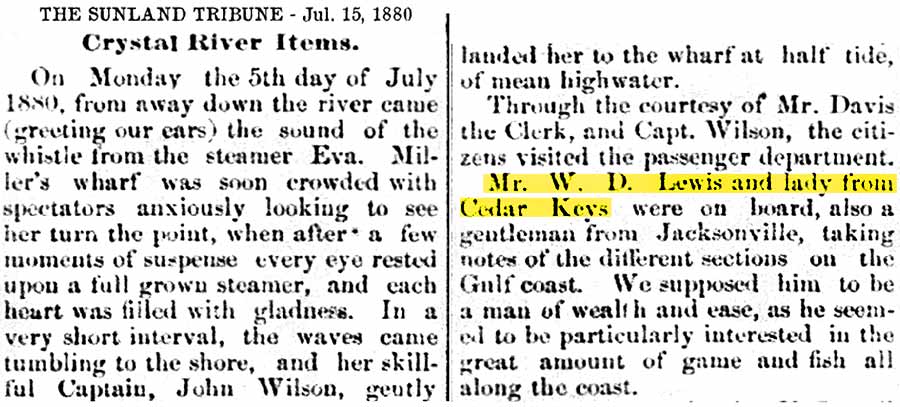
WILMER D. LEWIS LAND PATENTS
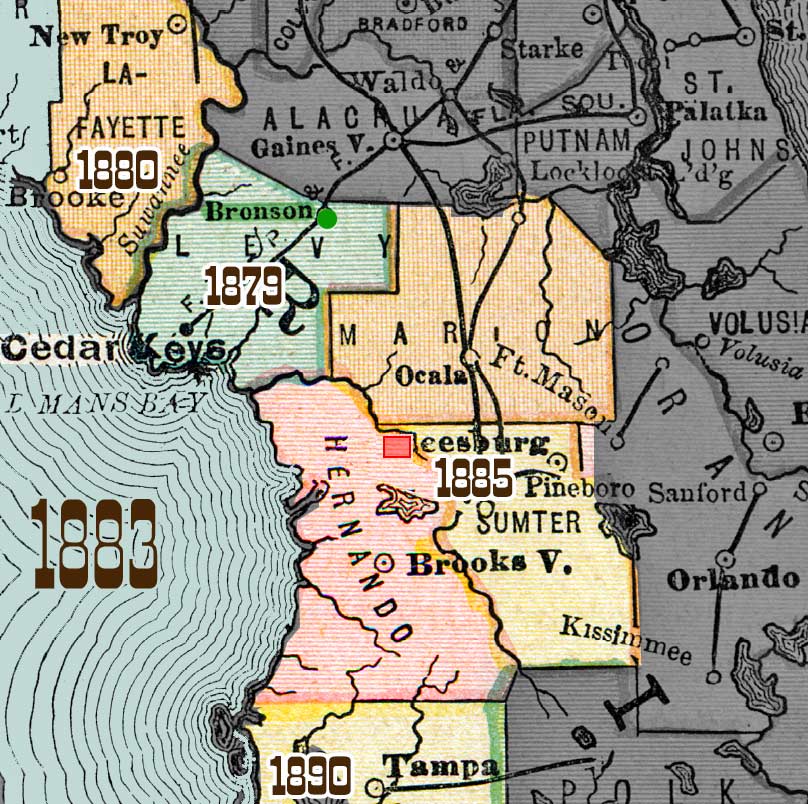
The map at
right shows
Florida's
counties as
they
appeared
around 1883.
The
locations
where Wilmer
was known to
be are
marked: His
marriage in
Bronson,
Levy Co. in
1879, his
1880 census
in Lafayette
Co, and 1885
census in
Sumter Co.
The
red square
marks the
location of
his land
patents
which were
originally
in Hernando
Co., but in
1887,
Hernando Co.
gave up it's
northern
lands to
form Citrus
Co, and its
southern
lands to
form Pasco
Co., thus
putting
Wilmer's
lands in the
new county
of Citrus.
(Sumter Co.
also gave up
its east
half to form
Lake Co.)
PLACE YOUR
CURSOR ON
THE MAP TO
SEE HOW THE
COUNTY LINES
HAVE
CHANGED.
See this map
website
which shows
how
Florida's
county lines
have changed
from 1821 to
1961.
In Oct. 1883 Wilmer and John R. Biggs bought 40 acres in section 18 of Township 18 south, Range 20 east in Citrus County** from the U.S. Government. On March 20, 1885 Wilmer bought approx. 66 acres in section 6 of the same township.
**At the time he bought these lands, they were in Hernando County. |
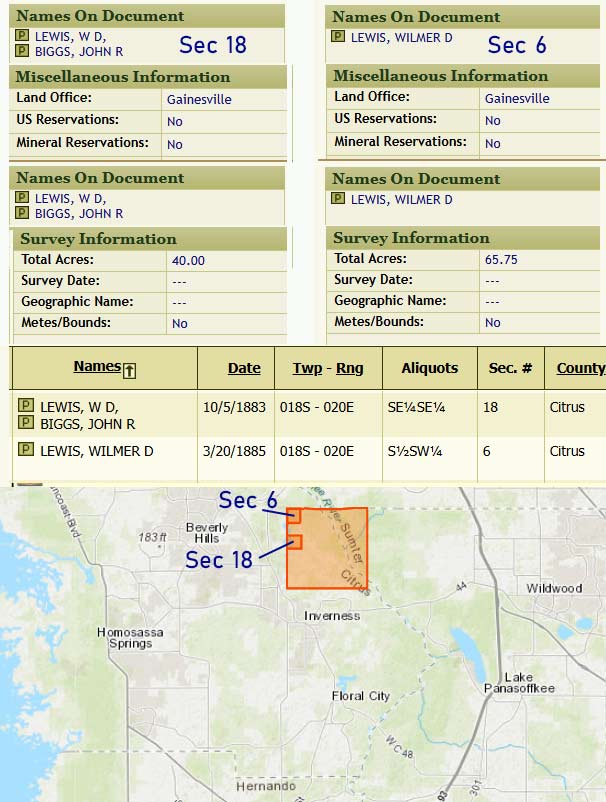 |
It's not known what Wilmer intended to do with these lands, he may have farmed them as orange groves, or intended to make one of these his homestead, or even just for use as an investment. He and Annie were living in Sumter County at the time, which is off the map in the extreme upper right corner on the east side of the Withlacoochee River. Place your cursor on the map to see a satellite view. |
|
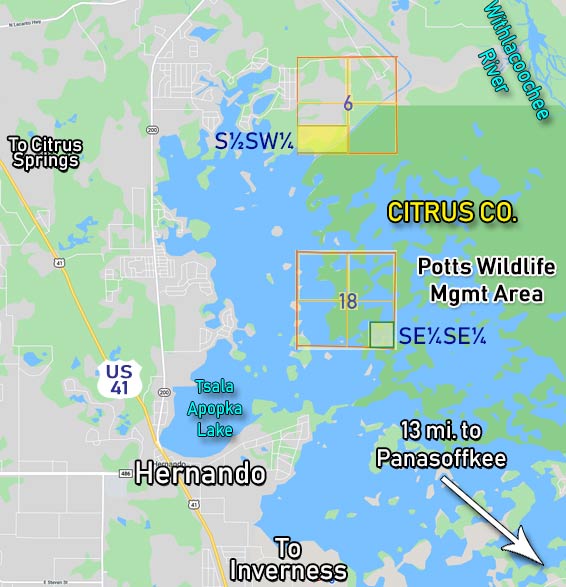
|
|
The larger orange square is Township 18S, Range 20E. Read about Cadastral surveying at the Bureau of Land Management website where the above info and images were obtained. |
"Hernando" is the name of the town, not a reference to the county which is located much further south.) |
1885 Florida
Census,
Sumter
County, FL
- W. D. Lewis
and wife
Annie
-her-sis-Florence,-Sumter-Co,-FL.jpg)
Here Wilmer
was a
farmer and Annie's
sister
Florence (Vestina)
McIlvaine is
living with
them.
She was
single but
would later
marry Harry
S. Ray.
Wilmer will
appear as W.D. Lewis
from this
point on in
Florida,
even in
newspaper
articles.
W. D.
LEWIS VISITS
TAMPA AND
GETS
IMMEDIATE
RECOGNITION
FOR HIS
SINGING
VOICE
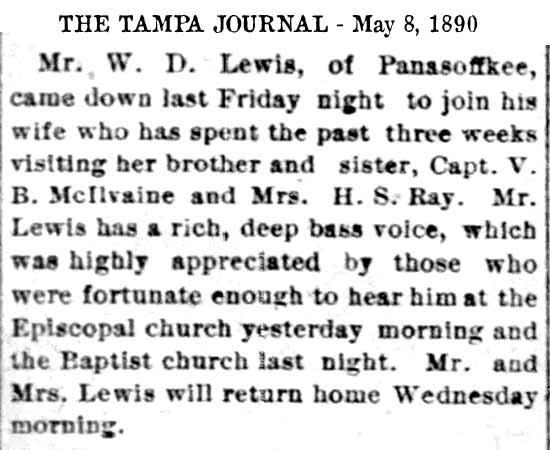
 In
early May
1890,
Wilmer
came to
Tampa for
about a week
to meet up
with his
wife (Annie)
who had been
visiting
here a few
weeks with
her brother,
V. B.
McIlvaine and sister, Mrs.
H. S.
(Florence) Ray. In
early May
1890,
Wilmer
came to
Tampa for
about a week
to meet up
with his
wife (Annie)
who had been
visiting
here a few
weeks with
her brother,
V. B.
McIlvaine and sister, Mrs.
H. S.
(Florence) Ray.
It was
immediately
noticed that
Mr. Lewis
had a
fine
singing
voice when
he sang at
the
Episcopal
and Baptist
churches
there.
While in
Tampa,
Wilmer
dropped in
on the local
Philharmonic
Society
meeting,
probably at
the
suggestion
of everyone
who heard
him Sunday
morning.
WILMER LEWIS
AND THE
COLLINS
HOUSE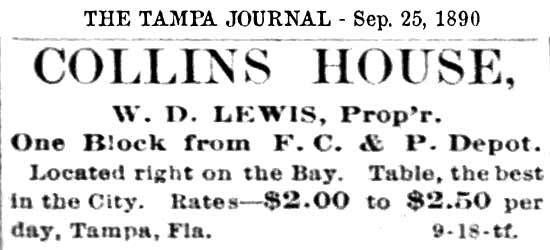
They
returned
home the
following
week, but
they would
return to
Tampa later
the same
year when
Wilmer
became
proprietor
of the
Collins
House,
previously
owned and
operated by
B. B. Cole
and family.
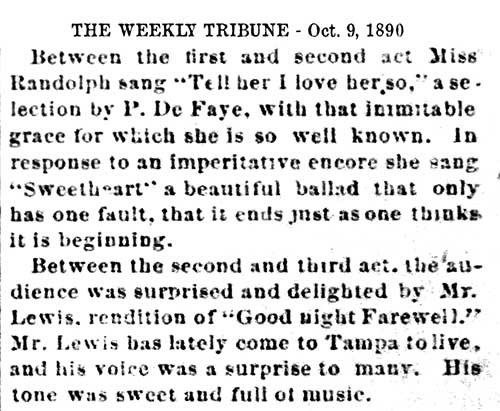
W. D. AND
ANNIE LEWIS
MOVE TO
TAMPA
By early
October,
1890, the
Lewis family
had come to
reside in
Tampa.
Wilmer
maintained
ownership of
his groves
at Panasoffkee
for about
five more
years, but
it was not
his choice
to give them
up.
(More on
this
shortly.)
At the
packed
Branch Opera
House on
Oct. 9, the
audience was
treated to
between-acts
performances
of a
children's
play,
"Mother
Goose." The second
intermission
performance caught
the audience
by surprise
and delight
when Wilmer
Lewis took
the stage
with a sweet
rendition of
"Good
Night
Farewell."

Click here
if you wish
to see the
whole
article.
Below,
H. L. Branch's
Opera House
(leftmost
3-story
bldg.)
on the 400
block of
Franklin
St., looking
west.
The photo
was taken
from the
roof of the
courthouse
around
1892-93, so
it appears
pretty much
as it looked
on the night
W. D. sang
there.
The building
in the
distance with the
steeple was
the
Knight &
Wall
Hardware Co.
at Tampa St.
and
Lafayette.
Today, the
Bank of
America
building
occupies
that corner.
In the
distance can
be seen the
newly
completed
Tampa Bay
Hotel across
the
Hillsborough
River.
|
The main
performance
was a
children's
play "Mother
Goose's
Kingdom."
The Weekly
Tribune
wrote,
"Rarely has
the Opera
House held
such an
audience as
the one that
gathered
last night
to see
Mother
Goose."
Click here
to read the
entire
article
describing
the play.
then click
the article
to see it
full size. |
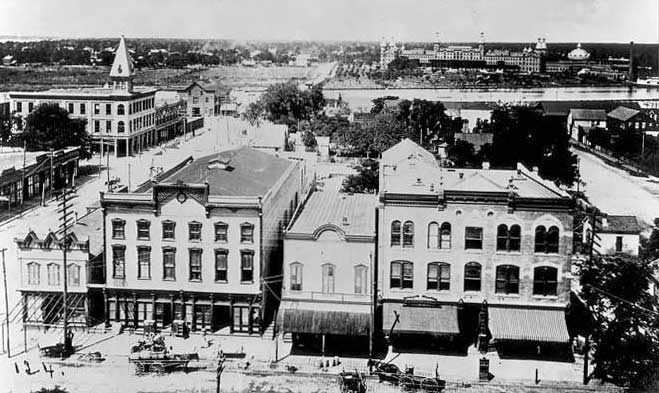 |
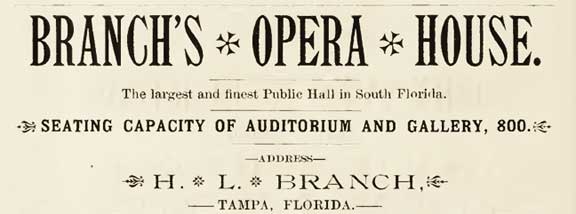 |
1885 Ad in
Tampa Board
of Trade
brochure.
This is a
Burgert
Bros. photo
from the
Tampa
-Hillsborough
Co. Public
Lib. Co-op
|
W. D. made occasional trips to check on his groves at Panasoffkee. |
A rare mention of Annie Lewis's social life. |
W. D. began his career as a teacher of voice music in Tampa when he ran this ad three times in the summer of 1892. |
|

|

|

|
|
|
|
|
WILMER D.
LEWIS ON
U.S.
TREASURY
PAYROLL
Under
President
Harrison's
administration,
W. D. was
appointed
Inspector of
Customs and
Deputy
Collector at
Tampa, which
position he
filled from
1891 to 1894.

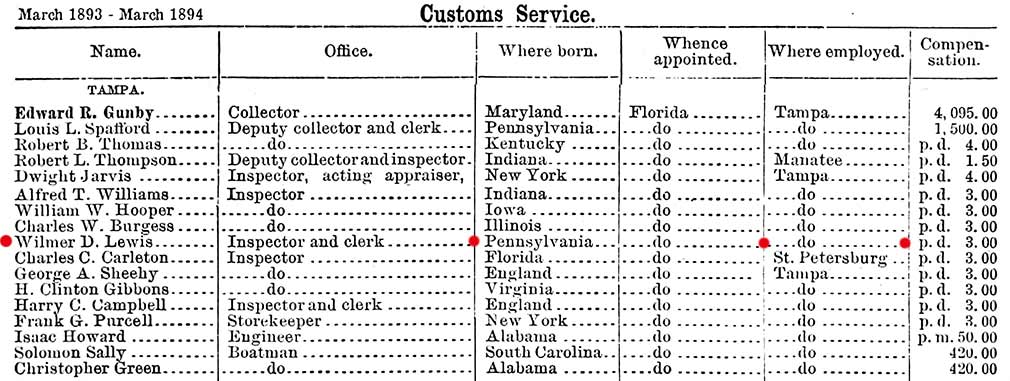
 |
|

W. D. IS NEPHEW OF
W. P.
HAISLEY
On this
August visit
of 1894, it
was
mentioned
that W.P.
Haisley
was an uncle
of W. D.
Lewis.

Was
V.B.
related to
William's
wife, Julia,
and her
mother Mary
(McIlvaine)
Simmons? |
 |
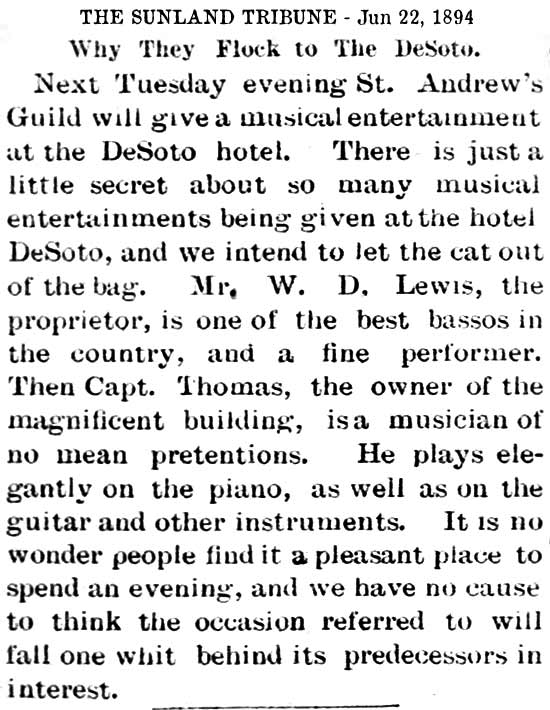 |
|
LEWIS & DUNN
PARTNERSHIP
In October
of 1894,
W. D.
was joined
in
partnership
by Charles
A. Dunn of
Ocala.
There were
frequent
articles in
the local
papers about
various
events and
festivities
held there,
each getting
great
reviews for
their
handling of
the events
and
facilities.
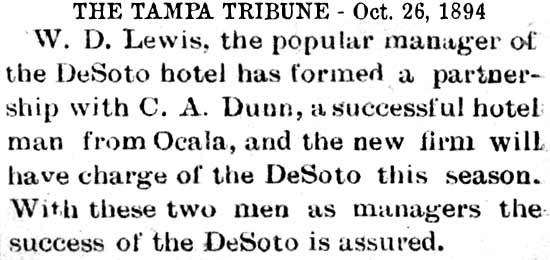 |
|
|
DESOTO FULLY
BOOKED
DESPITE
SUMMERTIME
More
accolades
for Wilmer's
management
of the
DeSoto
Hotel;
summer was
usually a
slow season
as the heat
kept
visitors in
the cooler
north, yet
the DeSoto
was booked
at full
capacity at
this time
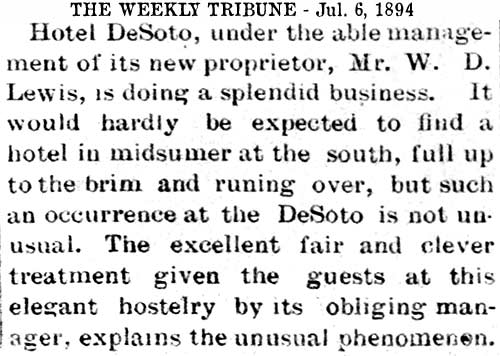 |
On Sep. 12,
1894, the
DeSoto Hotel
hosted a
grand
banquet for
fifty
members
of the Key
West Guards.
Florida
Governor
Henry L.
Mitchell
was among
the guests
at the
affair.
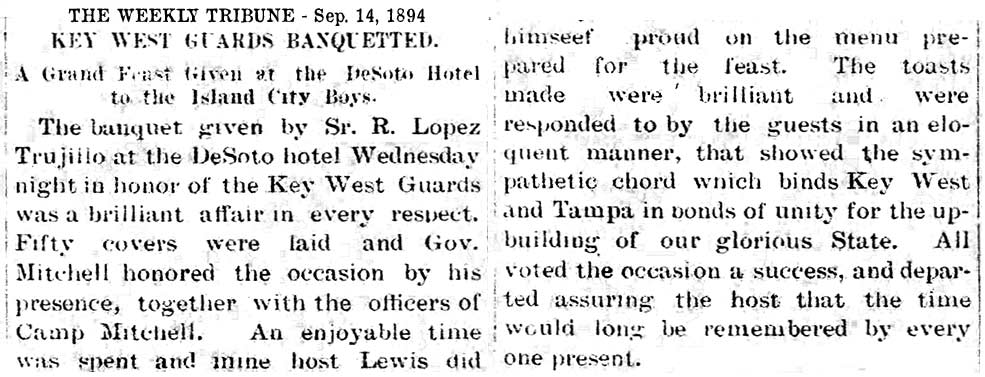
|
|
During the
winters of
1878-79, and
1879-80, the
Key West
garrison was
moved to
Fort Brooke
where it
remained
until traces
of Yellow
Fever had
disappeared
from Key
West.
Believing
that the
seasonal
move from
Key West to
Tampa would
become an
annual
event, the
quarters at
Fort Brooke
were given a
thorough
evaluation
by military
authorities.
The troops
from Key
West
remained in
Tampa from
May 1880
until 1882
when they
were
transferred
during the
"sick
season" to
St.
Augustine
and Mount
Vernon,
Alabama. The
last roll
call of
soldiers
occurred in
1882 and the
last
soldiers
were shipped
out in
December the
same year.
Fort Brooke
was
decommissioned
by the US
Army in
1883.
Read about
this at
TampaPix:
"The
Final Battle
for Fort
Brooke." |
|
Key West
troops at
Fort Brooke,
circa
1880-1882.
Photo
courtesy of
University
of S.
Florida
Digital
Library
Burgert
Bros.
collection.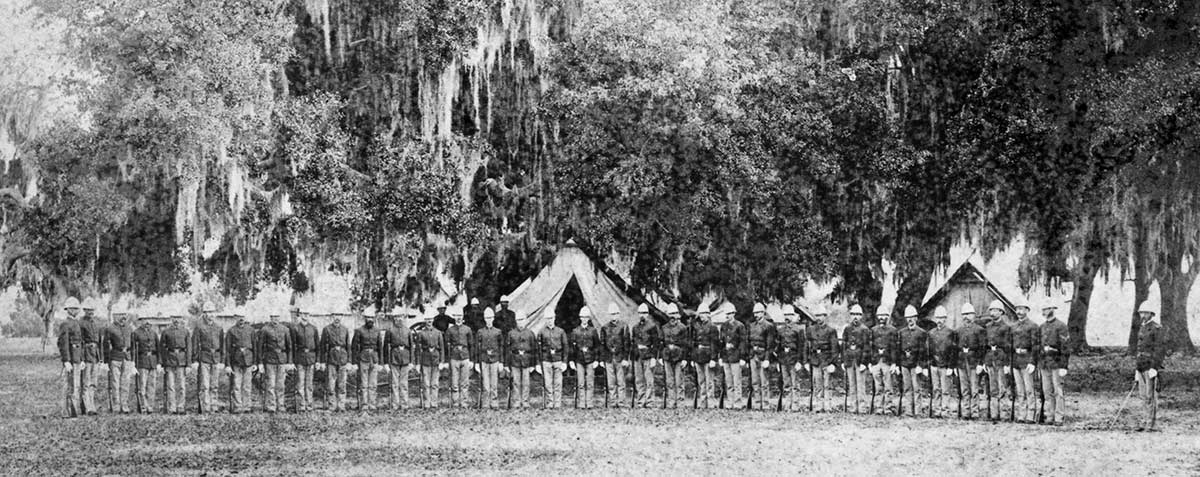
TAMPA
TROPICAL
TROUBADOURS
FORMED |
|
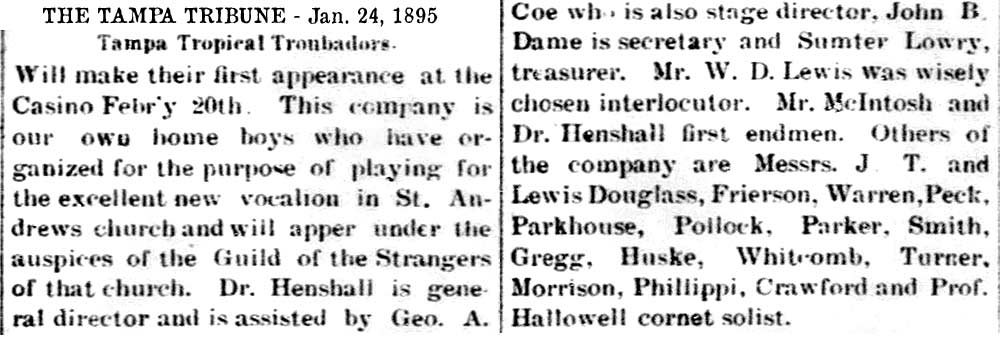 In Jan.
1895, a
musical
group
consisting
of about a
dozen men
was formed
to perform
along with a
new vocalion
obtained by
the St.
Andrews
church. (This
was a
reed-organ
which can
play sounds
similar to
the human
voice,
gradually
perfected
from
experiments
begun in
England
about 1870.)
The group
was under
the
patronage
and guidance
of the
"Guild of
the
Strangers"
of St.
Andrews. W.D.
Lewis was
chosen as
the
interlocutor.*
In addition
to a
director,
assistant,
and
secretary
being
appointed,
Sumter Lowry
was
appointed as
treasurer.
In the early
1900s, Lowry
would become
a city
commissioner
and work to
obtain a
Carnegie
grant to
build
Tampa's
first real
library.
He would
also go on
to be the
major mover
to convert
land north
of Tampa
from its
intended use
as a
cemetery to
a public
park
instead.
In the mid
1920s, the
park was
created and
named in his
honor. In Jan.
1895, a
musical
group
consisting
of about a
dozen men
was formed
to perform
along with a
new vocalion
obtained by
the St.
Andrews
church. (This
was a
reed-organ
which can
play sounds
similar to
the human
voice,
gradually
perfected
from
experiments
begun in
England
about 1870.)
The group
was under
the
patronage
and guidance
of the
"Guild of
the
Strangers"
of St.
Andrews. W.D.
Lewis was
chosen as
the
interlocutor.*
In addition
to a
director,
assistant,
and
secretary
being
appointed,
Sumter Lowry
was
appointed as
treasurer.
In the early
1900s, Lowry
would become
a city
commissioner
and work to
obtain a
Carnegie
grant to
build
Tampa's
first real
library.
He would
also go on
to be the
major mover
to convert
land north
of Tampa
from its
intended use
as a
cemetery to
a public
park
instead.
In the mid
1920s, the
park was
created and
named in his
honor.
*One who
takes part
in dialogue
or
conversation.
A man in the
middle of
the line in
a minstrel
show who
questions
the end men
and acts as
leader.
|
SNOW
IN TAMPA |
|
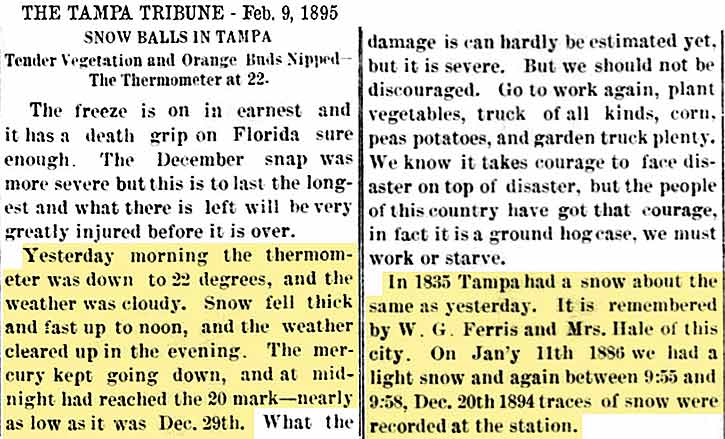 |
During this
time, Wilmer also had an
orange grove which upon
maturity was estimated
to be worth $45,000.
But unfortunately for
him, the entire grove
was ruined by the
phenomenal freeze of
1894-95, when the
temperature went down to
14 degrees F on Dec.
29th, 1894.
|
|
|
|
The Burgert
Bros. photo below,
from the
Tampa
Hillsborough
County
Public
Library
Burgert
collection,
shows a view
taken from
the highest point of
the new
county courthouse
looking NNE. |
|
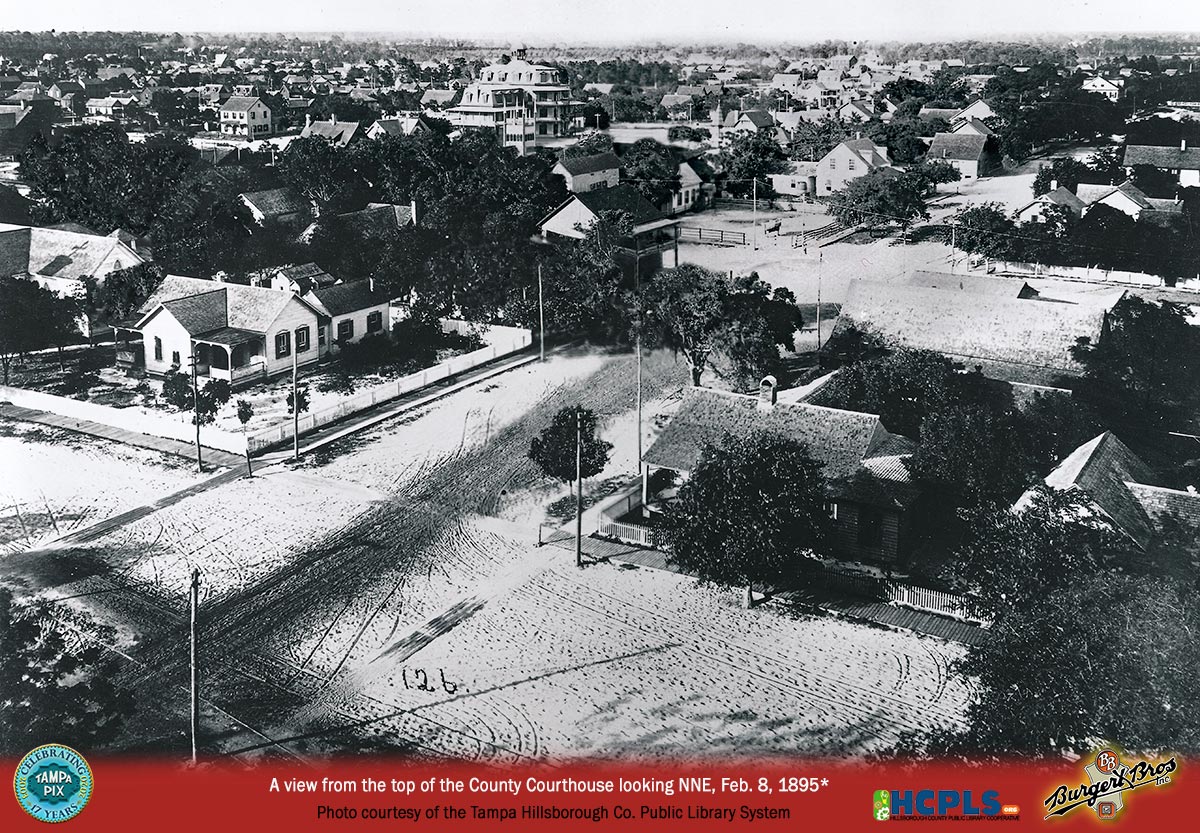 |
|
JUNE
THE STREETS ON THIS MAP HAVE BEEN
NARROWED TO ABOUT HALF THEIR ACTUAL WIDTH. TAMPA'S STREETS WERE 80
ft. WIDE.
1). St. Louis Catholic
church building (partial view.) In 1905 this became the site of the
magnificent
Sacred Heart Catholic Church.
2). The original YMCA
club house. In 1910 a new $100k brick structure was built at the
northwest corner of Florida Ave. & Zack St. It occupied one-fourth
the total area of the square block, with the gym comprising half of
the building's area.
3). St. Andrew's Episcopal Church,
built here in 1883. A new concrete-cement block structure was
built in 1907 on the vacant lot seen here just south of it at Marion
& Madison streets. |
By 1903 this church had
been moved to
the north side of Zack at Marion.
This
house was moved
and in 1903 construc-
tion began on this entire
block for the new Federal
Courthouse / Post Office. |
|
| |
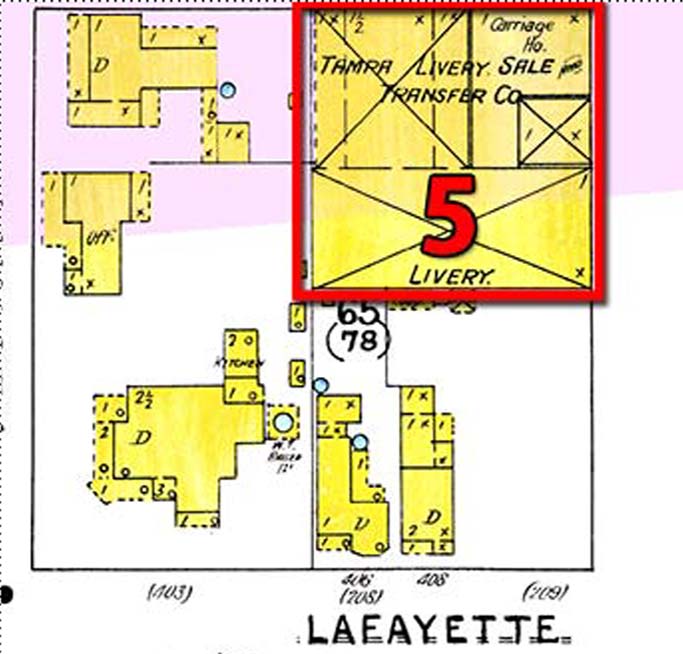 |
4). A key structure in this photo,
the Convent of the Holy Names, a three-story brick with wood frame
balconies and stairs structure completed in 1892 and occupying the whole block between
Zack & Twiggs, and Morgan & Pierce St. It's completion date
determines the earliest this photo could have been taken.
5). Tampa Livery Sale &
Transfer - stables. This June 1895 map shows the newly
expanded facility. This facility is also a key component of
the photo because it is the only rooftop in the photo covered in
white like the streets. Evidence that this is snow and not
just sand in the streets. Why only this roof? Being a
large stable, it probably did not have heating inside. Place
your cursor on this block to see it in 1892, before the expansion.
Compare the two maps to what is seen in the photo.
6). The other key structure is NOT
seen in the photo, but is obviously there--it is the new brick
Hillsborough County Courthouse, from where the photo was taken. The
highest point would have been in the minaret at the top of the dome
which was over four stories high.
|
|
THE DEATH
OF DR. JOHN
P. WALL
(The article
below has
been edited
to show only
the
beginning
and the end
as it
pertained to
Wilmer
Lewis.) |
|
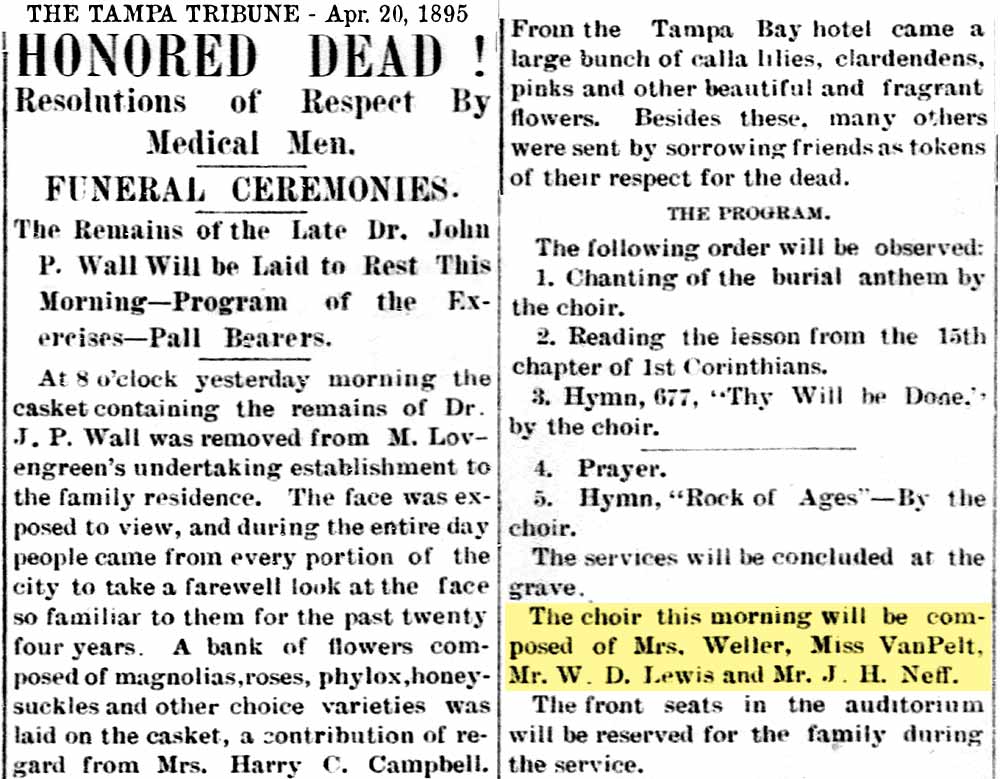
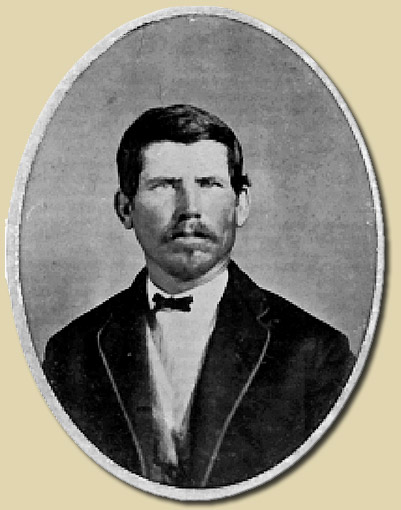 During
the
Civil
War,
John P.
Wall
volunteered
as a
surgeon
and was
assigned
to
Chimborazo
Hospital in
Richmond.
His life was
soon to
evolve into
a curious
milieu of
medicine,
law,
journalism
and
politics.
John P. Wall
became a
successful
physician,
writer and
politician.
He was
associate
editor of
the Sunland
Tribune,
which later
became the
Tampa
Tribune;
served as
mayor of
Tampa from
1878–1880,
concentrating
particularly
on
increasing
the maritime
trade of the
city,
.mapping out
many of the
routes
through the
Florida
wilderness
that are
used by the
Florida
highway
system
today; and
assisting
Vicente
Martinez
Ybor in
establishing
Ybor
City. During
the
Civil
War,
John P.
Wall
volunteered
as a
surgeon
and was
assigned
to
Chimborazo
Hospital in
Richmond.
His life was
soon to
evolve into
a curious
milieu of
medicine,
law,
journalism
and
politics.
John P. Wall
became a
successful
physician,
writer and
politician.
He was
associate
editor of
the Sunland
Tribune,
which later
became the
Tampa
Tribune;
served as
mayor of
Tampa from
1878–1880,
concentrating
particularly
on
increasing
the maritime
trade of the
city,
.mapping out
many of the
routes
through the
Florida
wilderness
that are
used by the
Florida
highway
system
today; and
assisting
Vicente
Martinez
Ybor in
establishing
Ybor
City.
The deaths
of his first
wife and
daughter
from Yellow
Fever
prompted
Wall to
search out
new paths
beyond
simply
guiding
patients
through the
fever’s
various
stages. He
now devoted
his life to
researching
and studying
how it could
be prevented
and
destroyed
more
effectively.
He was among
the first to
assert that
yellow fever
was carried
by the
mosquito.
For his
conclusions
on the
mosquito,
Wall
received
nothing but
ridicule
from the
medical
profession
and
especially
from the lay
press.
His second
wife was the
beautiful
young
daughter of
James McKay,
but to
receive
McKay's
permission,
he had to
successfully
defeat his
greatest
enemy--alcoholism.
Wall
also
served
as
Tampa's
health
officer
and successfully
lobbied
for the
construction
of a
hospital
to care
for the
people
stricken
with
yellow
fever.
Dr. Wall
collapsed
and died
while
giving a
speech
to his
colleagues
at the
annual
meeting
of the
Florida
Medical
Association
in
Gainesville
on April
18,
1895. He
had gone
up there
with his
life-long
friend
and
colleague
Dr.
Sheldon
Stringer.
Read the
article
published
in the
Tampa
Morning
Tribune
on April
19, 1895
about
his life
and his
death.
(When
the
image
opens,
click it
again to
see it
full
size.
It is
large.)
Read
about
the
amazing
life of
Dr. John
P. Wall
here at
TampaPix.
Also see
"They
Exalt
Humbug
at the
Expense
of
Science
and
Truth":
Dr. John
P. Wall
and the
Fight
Against
Yellow
Fever in
Late-Nineteenth
Century
Florida
by Larry
Omar
Rivers,
at USF
Scholar
Commons.
(Source
for the
above
oval
portrait.)
|
CHARITY
CONCERT TO
HELP CUBA'S
WOUNDED
SOLDIERS-
May 24, 1895
Although the
United
States had
not yet
entered into
war with
Spain, Cuba
had been
fighting for
its
independence
for several
years.
There was a
small
contingent
of Spaniards
in Tampa who
quietly
favored
control of
the island
by their
homeland,
but not the
imprisonment
and
mistreatment
the Cubans
were being
subjected
to. Most in
Tampa
sympathized
with the
plight of
the Cubans
and the
horrible
conditions
they were
subjected to
by the
Spanish
rulers and
military
leaders.
Read more
about this
at Clara
Barton in
Tampa, here
at TampaPix.
Here in late
May, a
"Grand
Concert" was
held at the
Cuban opera
house (in
Ybor City)
for the
benefit of
wounded
Cuban
soldiers,
assisted by
"some of the
musical
talent of
Tampa."
"The DeSoto
Duo" of
W. D. Lewis
and James H.
Thomas
teamed up
for a duet,
as well as
each
performing a
solo with
their
instruments
of
expertise.
|
|
 |
|
|
|
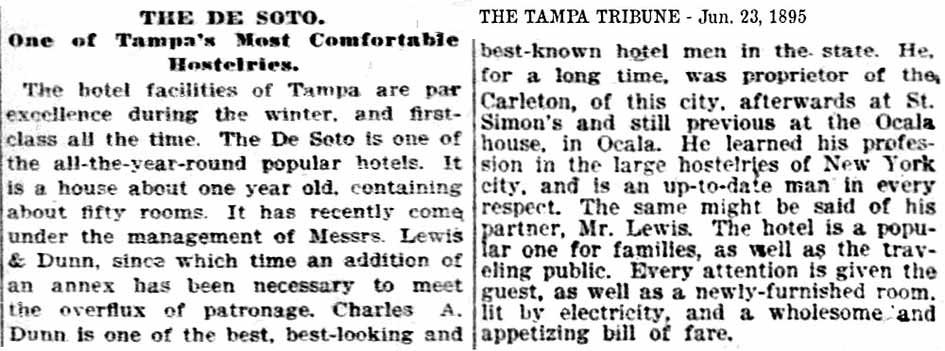
BACKGROUND
OF CHARLES
A. DUNN
Described
here as one
of the best,
best-looking
and
best-known
hotel men in
Florida.
Formerly the
owner of the
Carleton and
St. Simon's
in Tampa, he
previously
owned the
Ocala House
in Ocala.
He received
his training
at the
hotels in
New York
City and was
an
"up-to-date"
man in every
respect.
Every room
at the
DeSoto was
newly
furnished
(the hotel
was about
one year
old) and lit
by
electricity. |
|
|
CHARLES DUNN
RETIRES
In early
1896,
about six
months after
his rave
review in
the Tribune,
Charles
Dunn retired,
leaving
W. D. to
claim all
the future
profits (and
bills.)
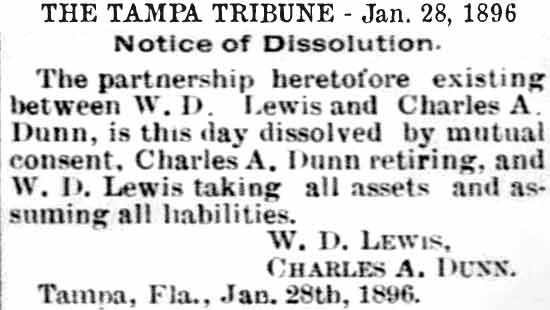
Read the
entire obit
of J. H.
Thomas
When it
opens, click
it again to
see fulll
size. |
DEATH OF
JAMES H.
THOMAS,
OWNER OF THE
DESOTO HOTEL
BUILDING
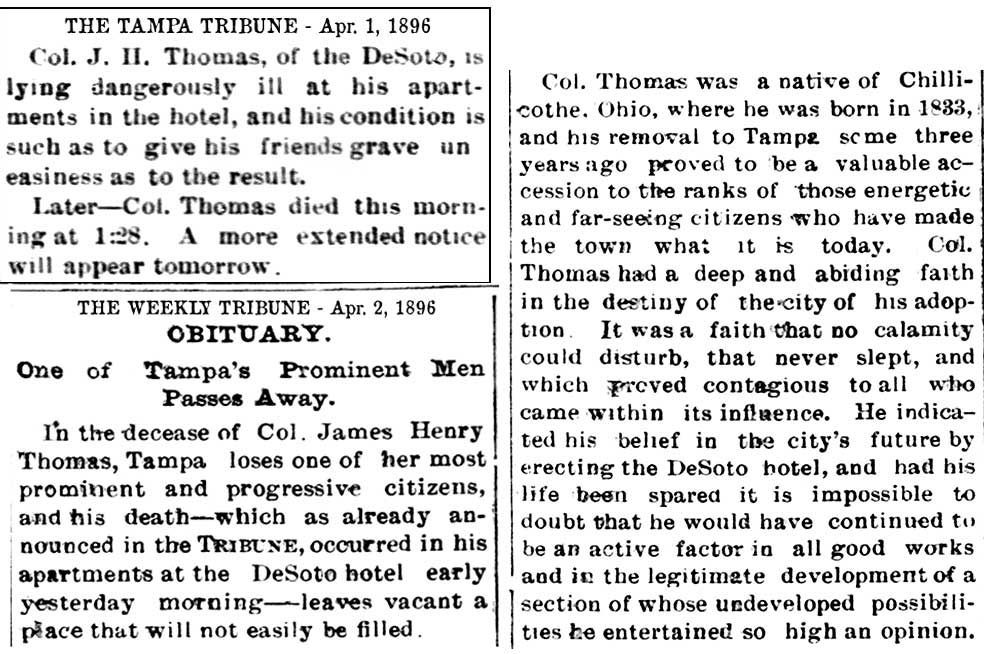
|
|
|
|
|
THE DESOTO HAUNTED? A Tribune reporter sensationalizes the random ringing of a telephone line at the DeSoto as being the ghost of J. H. Thomas, former owner of the hotel building who died in his apartment there. He claims the servants are telling a "chilly, blood-curdling" story which guests from all over have vouched for, that the bell ringing on it's own in the office is Mr. Thomas ringing for water from his room #7. |
|
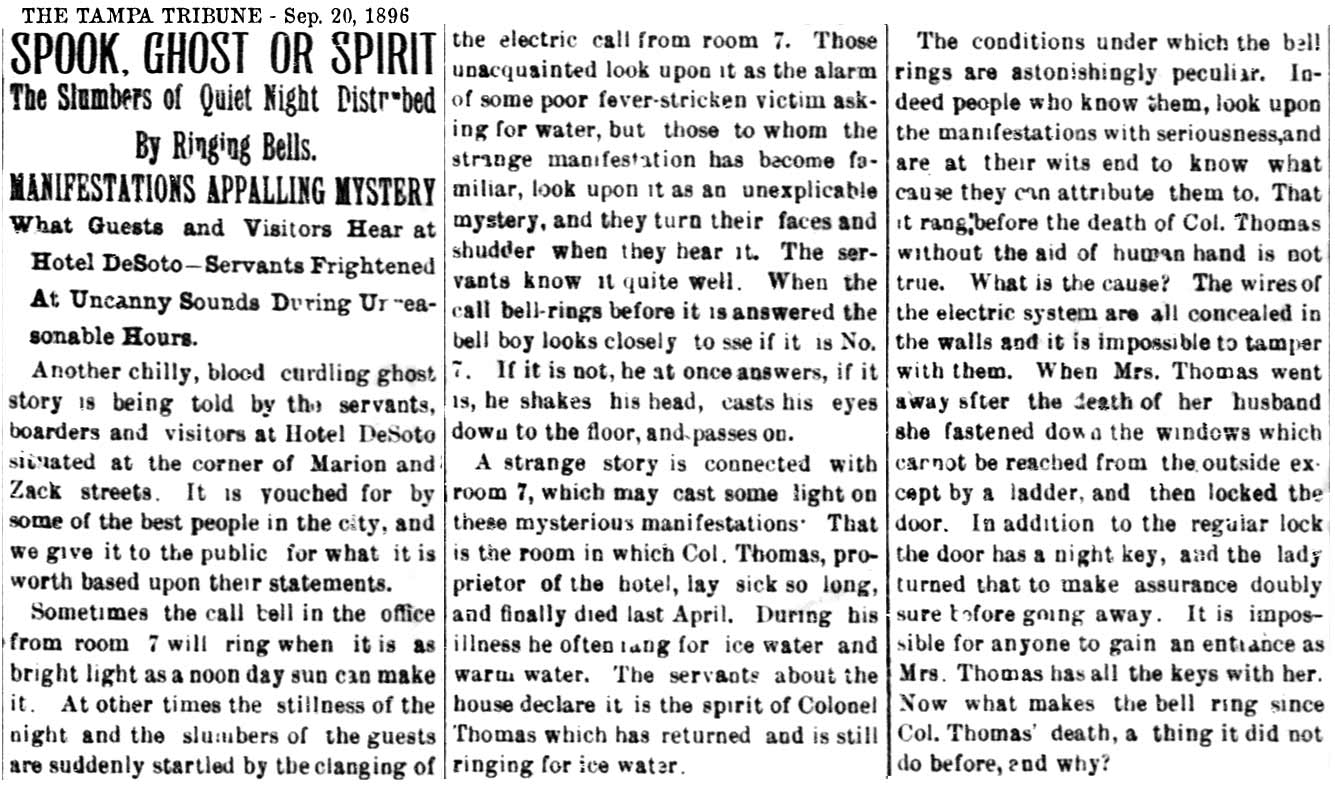
|
| |
| E. M. Greeson, a building contractor who worked on the DeSoto, dispels the the story by explaining that when the building was wired before being plastered, someone maliciously vandalized the wiring. All that had been accessible were repaired, but the bell to room #7 was still shorting out. |
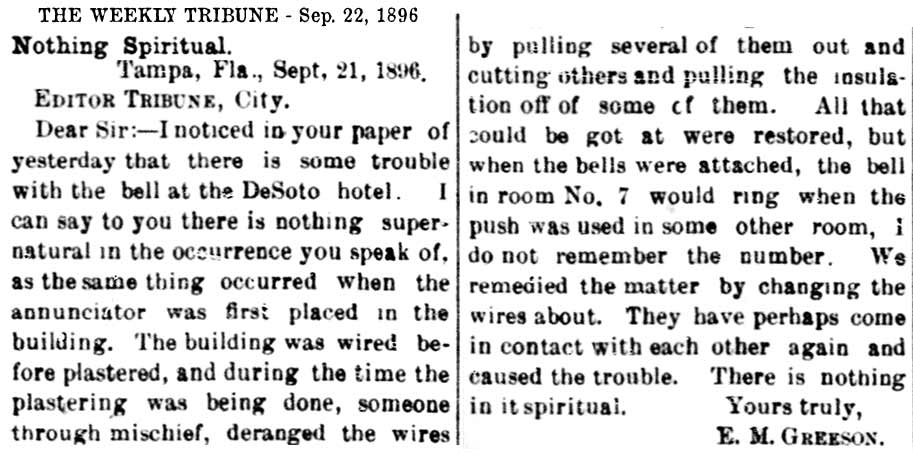
|
| |
| Below: Wilmer Lewis, hotel owner, responds more aggressively, demanding his response be published. He corrects the reporter by saying Mr. Thomas occupied room #9, not room #7, and "no guest ever noticed the bell nor was even startled by it, and no servant was ever alarmed by it or 'cast his eyes down' or ever made a general or particular fool of himself by any other preposterous performance." He rebukes the reporter for publishing "rot" and not considering the damage his sensationalism would cause to the hotel's reputation, adding "such trash" would still be believed by some who hear it, as "all the idiots and fools are not dead yet." |
|

|
| |
|
|
|
|
|
LEWIS LEAVES
THE DESOTO
IN 1897
In late
December
that 1897,
Wilmer Lewis
sold the DeSoto to
the Williams
brothers,
experienced
caterers
from Waldo,
Fla., and
ended his
connection
with the
Hotel DeSoto
after a
supper there
on Jan. 3,
1897.
"Mr. Lewis
has made a
jolly good
host and
retires with
the good
wishes of
the
traveling
public."
The Williams
brothers
planned a
lavish feast
with a
number of
imported
dishes to
celebrate.
In May,
Williams &
Co. became
H. A.
Williams Co.
when R. M.
Williams
retired. |
|
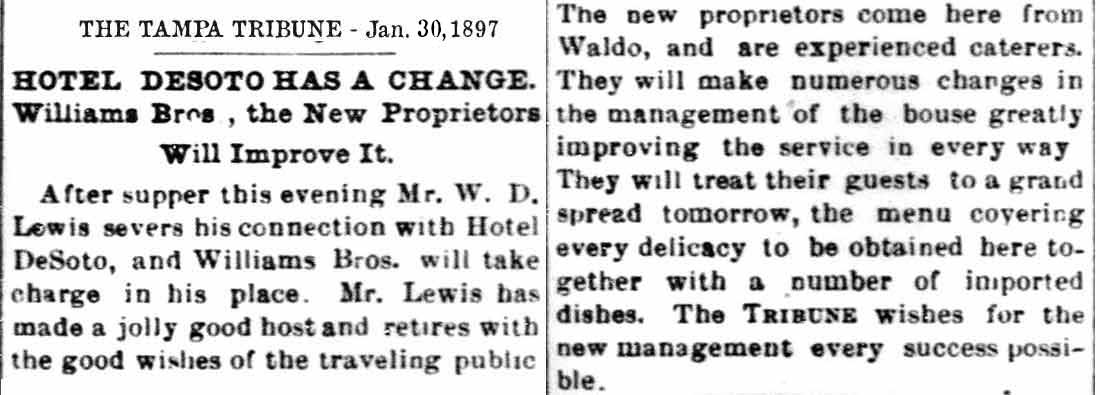
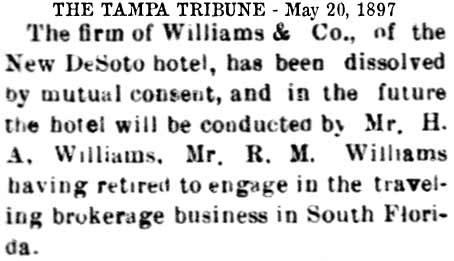
|
THE SPANISH
AMERICAN WAR
BRINGS
PROSPERITY
TO TAMPA,
ALONG WITH CLARA
BARTON AND
THE AMERICAN
RED CROSS
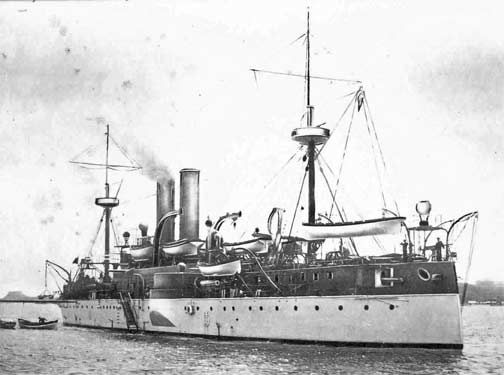 These
were the two
months
leading up
to the
Spanish-American
War.
President
McKinley had
sent the USS
Main to sit
in Havana
Harbor just
as a "show
of force" in
late January
of 1898.
American Red
Cross
founder
Clara Barton
arrived in
Cuba in
early
February and
was setting
up Red Cross
operations
and bringing
in
provisions.,
tending to
the tens of
thousands of
starving Cubans in
Spanish
concentration
camps,
On Feb.
13th, Clara
toured the
Maine and
had dinner
with Capt. Sigsbee on
the ship.
She was
working at
her desk in
Havana the
evening of
the 15th
when all
Havana was
rocked by
the
explosion on
board the
Maine. These
were the two
months
leading up
to the
Spanish-American
War.
President
McKinley had
sent the USS
Main to sit
in Havana
Harbor just
as a "show
of force" in
late January
of 1898.
American Red
Cross
founder
Clara Barton
arrived in
Cuba in
early
February and
was setting
up Red Cross
operations
and bringing
in
provisions.,
tending to
the tens of
thousands of
starving Cubans in
Spanish
concentration
camps,
On Feb.
13th, Clara
toured the
Maine and
had dinner
with Capt. Sigsbee on
the ship.
She was
working at
her desk in
Havana the
evening of
the 15th
when all
Havana was
rocked by
the
explosion on
board the
Maine.
After the
explosion on
the Maine,
Tampa's
mayor (Myron
Gillette)
and
congressman
promptly
petitioned
U.S.
Secretary of
War Russell
Alger for
protection
against the
Spanish
Navy.
Leading
citizens and
the Board of
Trade
demanded a
military
presence in
Tampa and
the funding
of coastal
defense
sites. But
from the
armchair
generals in
Washington,
there was no
response.
Then on
March 22nd,
Henry Plant
wrote
Secretary
Alger
personally,
calling
attention to
his
multi-million
dollar
investment
in Port
Tampa. Money
talked and
Plant had
it. On
March 25th,
Alger sent
his Chief of
Engineers to
begin
fortifications
on Egmont
and Mullet
Keys. With
that,
Florida,
Tampa and
H.B. Plant
were
involved in
the
still-undeclared
war. The
Olivette had
already made
one run for
Assistant
Secretary of
the Navy,
Theodore
Roosevelt,
delivering
ammunition
to Key West.
Local papers
began
boosting
Tampa as the
obvious
supply point
for
operations
in the
Caribbean.
At the end
of March, a
real-life
seagoing
admiral
checked into
the Port
Tampa Inn.
On behalf of
the Plant
System,
Henry
Plant's
second in
command,
Franklin Q.
Brown, gave
"Fighting
Bob" Evans a
tour of the
harbor. The
admiral
passed the
word to the
press corps.
In the event
of war, make
way for the
Navy!
Due to the
coming war,
the order
was given
for all
American
citizens to
leave
Havana.
Clara was
forced to
abandon her
relief work
and, in her
words, she
left those
“poor, dying
wretches to
their fate.”
One
newspaper
reported,
“The whole
system of
caring for
and giving
aid to the
starving
Cubans is
for the time
being
brought to a
complete
standstill.”
On April
9th, she
packed her
bags and
headed to
Tampa, where
she set up
the American
Red Cross
headquarters.
At the
declaration
of war on
April 25th,
the American
Red Cross in
Tampa was
ready to
offer
immediate
war service,
and in spite
of war,
Barton hoped
that her
relief work
would
continue.
 In
the
meantime,
Tampa and
Port Tampa became
a hotbed of
military
activity,
and a flood
of journalists
from all
over the
world
descended on
Tampa.
H. B.
Plant's
Tampa Bay
Hotel became
headquarters
for the top
brass of the
U.S.
military
forces during the
Spanish
American War
as Tampa was
the
debarkation
point for
troops going
to Cuba.
The troops
and their
leaders
camped out
at various
places
around
Tampa, West
Tampa and
Port Tampa,
and Ybor
City.
A young
relatively
unknown
officer
named
Theodore
Roosevelt
camped
outdoors in
the
sweltering
heat and
mosquito
infested
area of West
Tampa with
his "’Rough
Riders, but
his wife
stayed at
the "big
hotel."
Generals Joe
Wheeler,
John B.
Gordon,
Fitzhugh
Lee, Nelson
A. Miles,
James F.
Wade,
McClure, and
Ramsey were
some of the
brass who
mapped
strategy
from the
shady verandahs of
the hotel. In
the
meantime,
Tampa and
Port Tampa became
a hotbed of
military
activity,
and a flood
of journalists
from all
over the
world
descended on
Tampa.
H. B.
Plant's
Tampa Bay
Hotel became
headquarters
for the top
brass of the
U.S.
military
forces during the
Spanish
American War
as Tampa was
the
debarkation
point for
troops going
to Cuba.
The troops
and their
leaders
camped out
at various
places
around
Tampa, West
Tampa and
Port Tampa,
and Ybor
City.
A young
relatively
unknown
officer
named
Theodore
Roosevelt
camped
outdoors in
the
sweltering
heat and
mosquito
infested
area of West
Tampa with
his "’Rough
Riders, but
his wife
stayed at
the "big
hotel."
Generals Joe
Wheeler,
John B.
Gordon,
Fitzhugh
Lee, Nelson
A. Miles,
James F.
Wade,
McClure, and
Ramsey were
some of the
brass who
mapped
strategy
from the
shady verandahs of
the hotel.
Rooms were
scarce and
hotels
and boarding
houses in
Tampa
profited.
This was a
boom-time
for Tampa--a
tremendous
boost for
the local
economy,
especially
the saloons.
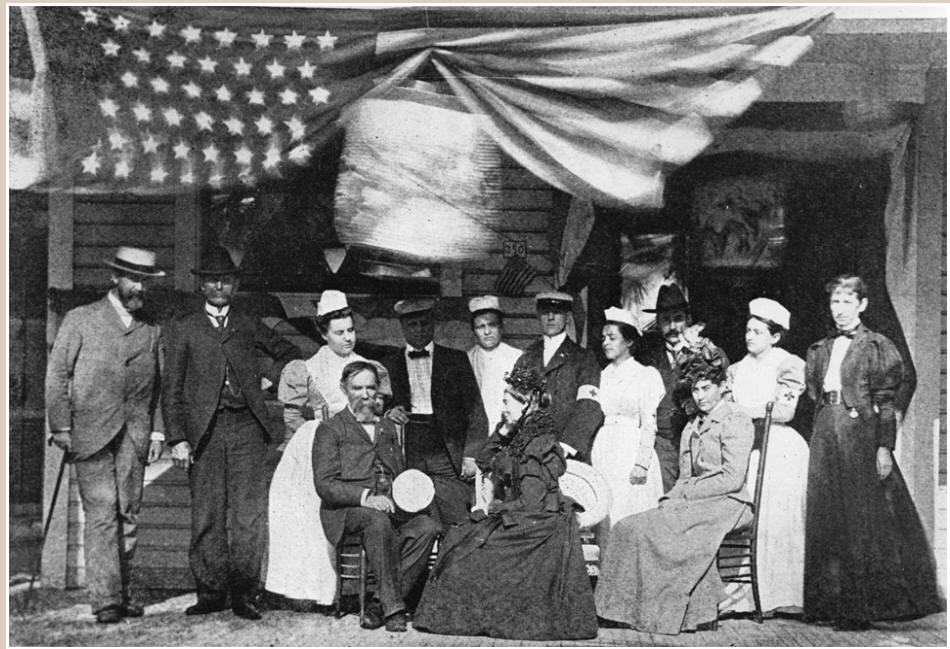
Where did
Clara Barton
stay during
the times
she was in
Tampa?
Find out
at TampaPix.
It's NOT
where most
people think
she would
have stayed.
Read more
about Clara
Barton, from
her early
childhood,
through her
Civil War
relief, her
Red Cross
efforts, and
her time in
Tampa as
well as the
war, here at
TampaPix.com:
Clara Barton
Early Life
through 1897
Clara Barton
1898 through
1912
(Captions
and credits
for all the
photos used
in this
section are
provided on
the pages
linked
above.)
|
H. A
WILLIAMS
RETIRES,
MRS. B. S.
HANKINS
TAKES CHARGE
OF THE
DESOTO
Mrs. Hankins
was formerly
the owner of
the Gold
Hotel in
Bartow, and
the
Commercial
boarding
house in
Tampa.
Nothing more
is said
about her in
the Tampa
newspapers
other than
her name,
which was
always "Mrs"
and her
husband's
initials,
and Hankins. This
article goes
on to
describe the
DeSoto and
the plan
Mrs. Hankins
had to
improve the
hotel, such
as offering
special
rates to
Tampa
people.
Special
attention
would be
given to the
cuisine,
"and the
table will
at all times
be supplied
with the
best the
market
affords."

The Desoto
opened on
Apr. 5, 1898
with Mrs.
Hankins as
the new
manager,
formerly
owner of the
Commercial
house in
Tampa.
She is
credited
with having
"a
considerable
amount of
management
of hotels in
Florida."
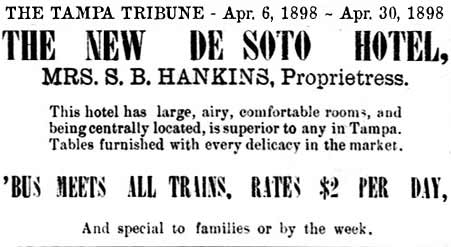
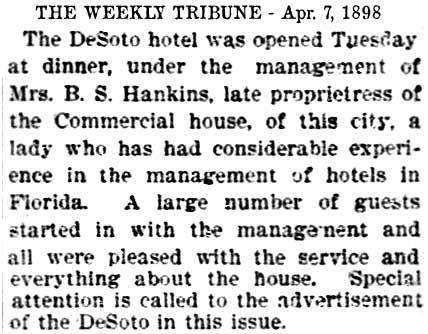
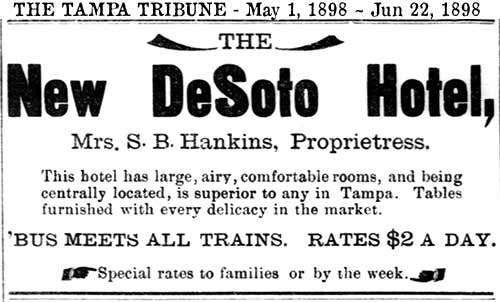
|
MRS. B. S.
HANKINS and
THE HANKINS
BROTHERS OF
BARTOW IN
TAMPA
Mrs. B. S.
Hankins was
the wife of
Bethel
Stevens
Hankins,
a.k.a.
Gilpin or
just "Gilp"
Hankins, his
nickname.
One of his
brothers,
whom he
partnered
with in his
Tampa
saloon business was Sylvanius
Masters
Hankins, who was
known as "Marter."
Their
father,
William
Wesley
Hankins, was
one of eight
children of
pioneer
farmer
Dennis
DuPont
Hankins who
owned a
large
plantation
in Madison
County.
Dennis was a
Methodist
preacher and
is credited
with
starting a
Methodist
Church in
Madison
County.
He was
married to
Sarah Connor
and served
as a Justice
of Peace for
Madison Co.
at Cherry
Lake.
Gilp's and
Marter's
father,
William
Wesley
"Billy" Hankins, was
a gunsmith
and dry
goods store
owner in
Bartow.
In town, and
in most of
the state,
he was known
as "Uncle
Billy
Hankins." He
was a
skillful
hunter and is credited
with firing
the last
shot of 2nd
Seminole War
at age 16.
During the
Civil war,
he was a
Confederate
sharpshooter
in the 5th
FL Infantry,
Company D,
and was
captured
Apr. 6, 1865
at Highbridge.
Later he was
released on
oath from
Point
Lookout
Prison MD. William was a
member of
state House
of
Representatives
from Madison
and
Lafayette
counties in
1873, and a
member of
state senate
in 1883 and
1885 from
Taylor and
Lafayette
counties.
In all, W.
W. Hankins
and wife
Almira
Church had
at least
twelve
children,
but three
died in
childhood.
Mouse over
the photo to
see names.
Photo
identification
is from
WikiTree
William
Wesley
Hankins
(standing,
2nd from
right) and
his
children,
ca.
1890-1897.
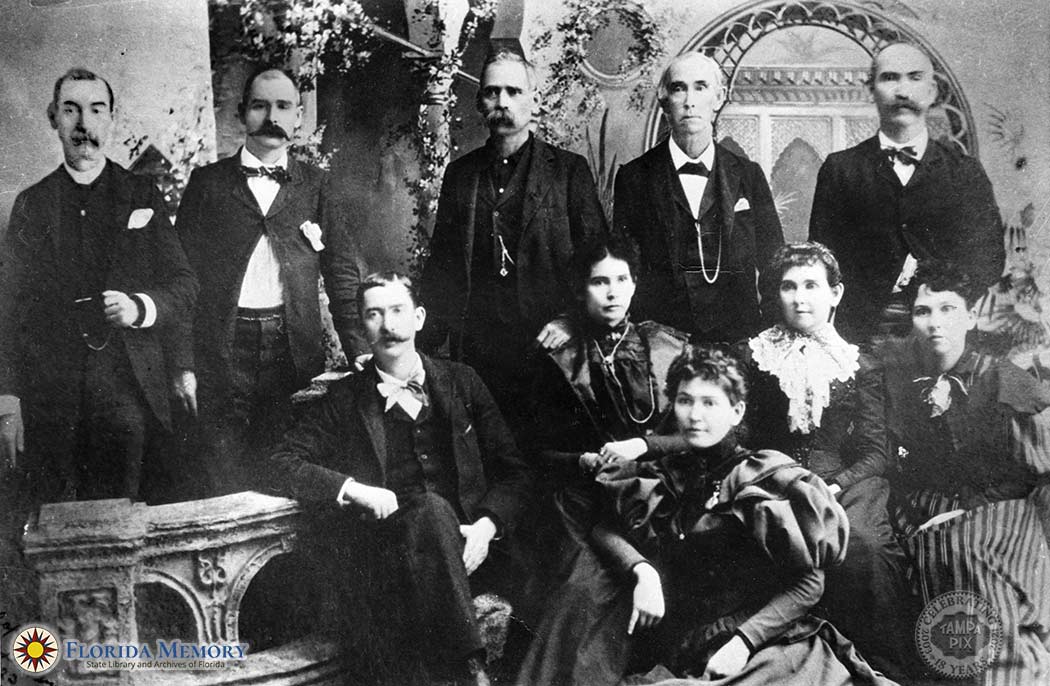
Photo
courtesy of
Florida
Memory,
State
Library &
Archives of
Florida.
The Hankins
family lived
in Bartow,
Fla.
William W.
Hankin's
wife is not
in the
photo, she
died in
1890.
This photo
was taken
sometime
after the
death of
Almira Jane
(Church)
Hankins in
Mar. 1890,
to the time
of Gilp
Hankin's
death in
Aug. 1897.
Edward S.
Hankins died
in Key West
in Sept.
1899.
BLOODY BRAWL
BETWEEN
TWO PAIRS OF
BROTHERS ON
STREETS OF
TAMPA -
HANKINS vs.
McNEILL
In a letter
to the Gulf
Coast Breeze
(Crawfordville,
Fla.)
newspaper
from an
unnamed
writer,
published
Aug 19, 1897
about
the Aug. 4th
street fight
between the
Hankins
brothers and
the McNeil
brothers,
this was
said of the
Hankins and
McNeil
families:
The Hankins brothers were originally from Middle Florida. Their father, Hon. William Hankins, was a noble true and good man. He represented at different times, the counties of Madison, Lafayette, and Suwannee in the Legislature and while under his control, Marter and Gilp Hankins were extra good boys. Their older brother, Hon. W. D. Hankins, of Lafayette County, followed in the footsteps of their honored father, but Marter and Gilp engaged in the liquor saloon business, and followed the course of the average man in that business. For the past ten years or more, they have enjoyed the reputation of being violent and dangerous men.
|
The McNeil brothers are originally from Sumter County, Geo. James C. McNeil is an architect, and is sole proprietor of the Tampa Planing Mills and Novelty Works. For several years he identified with the city government of Tampa as President of the City Council and Mayor pro tem. Lee McNeil assisted his brother at his mills, until disabled by the loss of a hand in the machinery. Since then he has been in the employ of the city as manager of the city cemetery (Oaklawn.) |
Tampa City Council Members |
|
Tampa City Council Members |
March 4, 1892 – March 10, 1893
James C. McNeil, President
George T. Chamberlain, President pro tempore
Louis G. Cone
Isaac S. Craft
Henry L. Crane
Jose Gomez
William H. Kendrick
Peter O. Knight
James W. Roberts |
March 10, 1893 – March 9, 1894
James C. McNeil, President
George S. Petty, President pro tempore
George T. Chamberlain
Henry L. Crane
Robert W. Easley
William H. Kendrick
Peter O. Knight
John S. McFall
Emilio Pons
Ramon Rubiera de Armas
John Savarese |
| |
|
|
|
THE MURDER
OF
GILPIN
HANKINS
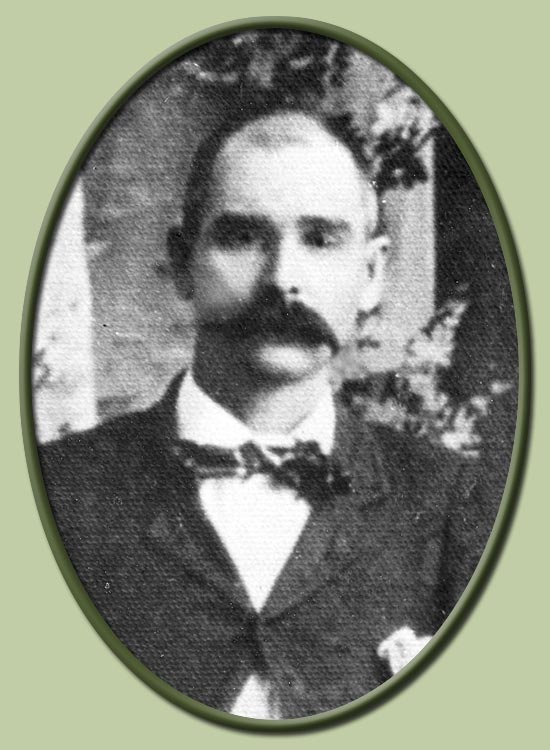 |
|
Bethel S. "Gilp"
Hankins |
About eight
months
before she
leased the
DeSoto
Hotel, Mrs.
Hankins was
widowed in
early Aug.
1897 when
her husband and
his brother, Sylvanius
Masters
"Marter" Hankins,
were
involved in
a street
fight with
the McNeil
brothers
James C. and
Lee.
Gilp Hankins was
co-owner of
"The Missing
Link Saloon"
and at the
time of his
death, he
was co-owner
of
the "Hankins
Brothers
Saloon" with
his brother Marter.
On Aug. 4,
1897, around
10 p.m., Marter
and Gilp
Hankins
encountered
the McNeil
brothers on the
streets at
Franklin and
Harrison
where the
Hankins
Bros. saloon was
located.
An argument
over an old
gambling
debt J. C.
McNeil was
said to have owed
to Gilp
ensued,
which turned
into a
violent fight.
|
Sylvanus Masters "Marter" Hankins
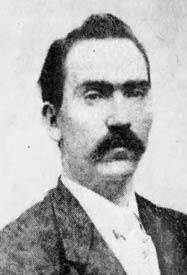
Brother of Bethel S. "Gilp" Hankins
Photo provided by Judy Llamas at Find-a-Grave |
|
READ ABOUT THE CONFRONTATION ON THE STREETS OF TAMPA AND THE RESULTING TRIAL OF THE MCNEIL BROTHERS
|
|
MRS. HANKINS LEAVES THE DESOTO
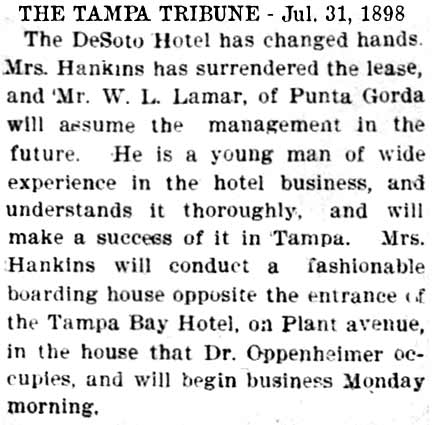
No other mentions of Lamar.
Brown & Corning
immediately
undertook to renovate
the hotel by
flooring the
lobby with
tile
installed by
Tampa Tile &
Paving Co.,
tearing away
the old
kitchen and
adjoining
outhouse and
building a
new and
"more
commodious
one."
The entire
culinary
department
was to be
completely
overhauled,
including
repainting
the dining
room.
All
seventy-one guest
rooms were
to be
thoroughly
overhauled
and
renovated,
including
new screens
and beds.
Four new
porcelain
bath tubs
and entirely
new closets*
were also
being added.
Also, the
sample rooms
were to be
newly
wallpapered
and
carpeted.
It appears
that a Mrs.
Capt. Rogers
owned the
building,
with the new
leasers
being
described as
"proprietors"
(owners of
the
business.)

|
LAMAR GIVES UP TO BROWN & CORNING, START REPAIRS W. L. Lamar is described as "a young man of wide experience in the hotel business, and understands it thoroughly." Mrs. Hankins planned to open a "fashionable boarding house opposite the entrance of the Tampa Bay Hotel on Plant Avenue" in a house occupied by the well-known Tampa doctor Oppenheimer. Mr. Lamar's career at the DeSoto
was
short-lived.
In Sept.
1898, the
DeSoto was
leased for a
number of
years by Amos A.
Brown and
W. E. Corning, men
with long
experience
in the hotel
business.
 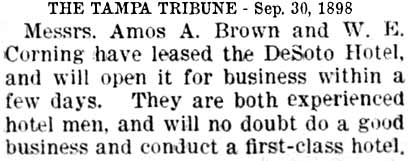 |
|
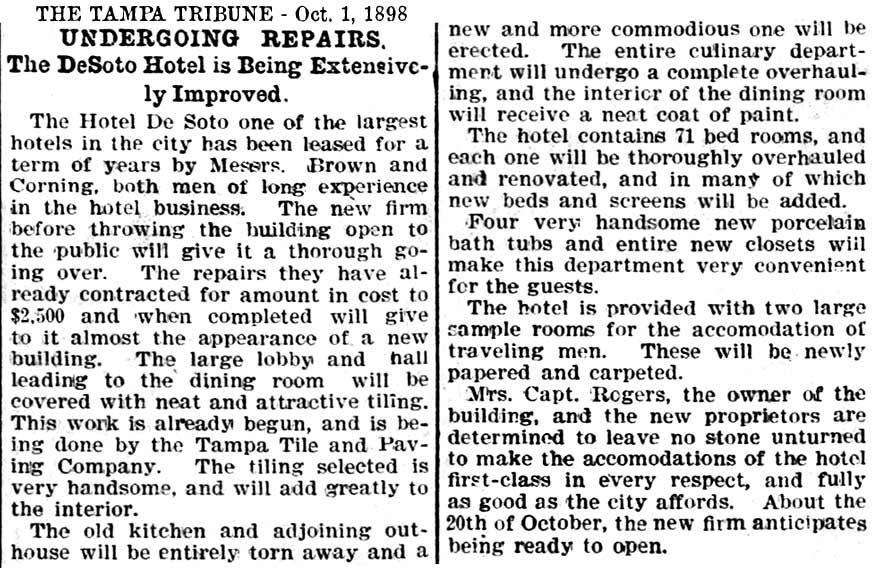 |
|
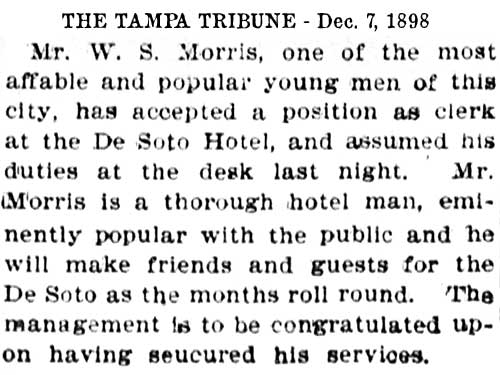
*The
DeSoto, as
well as many
other hotels
of this
period,
didn't have
a bathroom
in the guest
rooms.
Bathrooms
were usually
one large
room with
multiple
tubs.
"Closets"
was probably
"water
closets"--
toilets in a
small
private
space in a
room to be
shared by
all guests.
If they were
outside they
were called
"outhouses."
|
DESOTO SOLD
TO ROBERT F.
WEBB &
SON-IN-LAW
WALTER L.
PARKER
Webb &
Parker were
currently
the owner
and manager
of the
Palmetto
Hotel.
As soon as
Webb closed
the sale of
the Palmetto
to Hazen, he
bought the
DeSoto from
Brown &
Corning.
It is R. F.
Webb and W.
L. Parker
who would
turn the old
wood frame
DeSoto into
a brick and
block palace
that would
rival most
hotels in
the south.
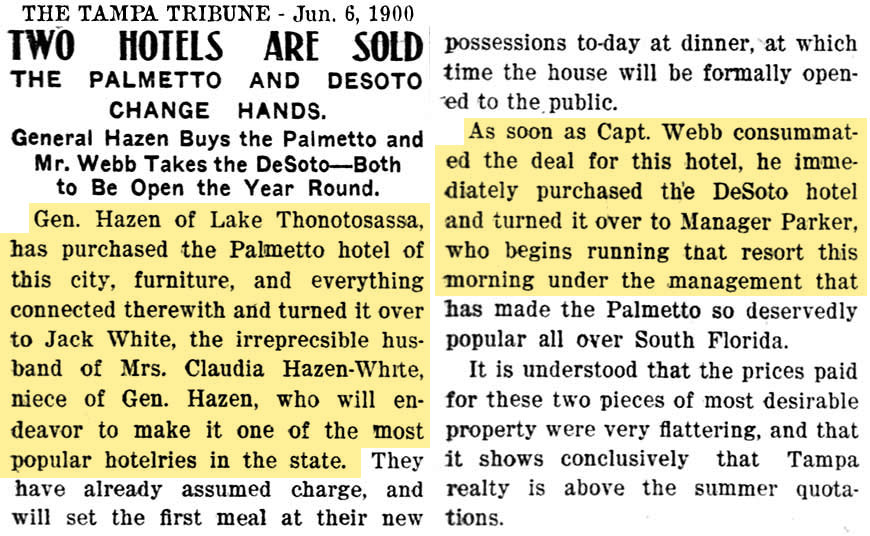 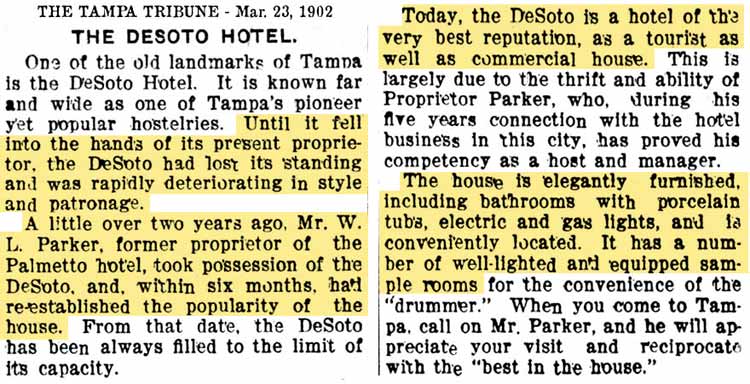
WALTER LAYTON PARKER
Information mostly from his Tampa Tribune obituary of Nov. 13, 1918, and some info and photo from
"The City Council of Tampa & Celebration of Old City Hall's CentennialBorn in Liberty County, Georgia on Mar. 26, 1868, W. L. Parker spent most of his life in Florida. He lived in Wellborn, Fla. until he was 16, then went to Orlando to work in the railroad offices. Later he came to Tampa and took a position as telegraph operator for the Plant System, which became the A.C.L. Railroad. In 1900 he became manager of the Palmetto Hotel when his father-in-law, former council member Robert F. Webb, retired from the hotel business. Soon afterward, when the Palmetto was sold and the DeSoto purchased, Parker became a stockholder and was given the position of manager, one he would retain until his death. Under his ownership, the old wood frame hotel was completely replaced by a new gleaming brick and stone structure, a process which spanned from 1907 to 1910, and eventually occupying almost the entire square block. Parker was a member of Tampa’s first Library Board and was instrumental in establishing a public library in Tampa. He was elected to Tampa City Council to represent the First Ward, downtown Tampa. Parker served on the Ordinances and Rules Committee, the Schools and Public Buildings Committee, and the Wharves, Bridges and Harbors Committee. He was also a Hillsborough County Commissioner. |
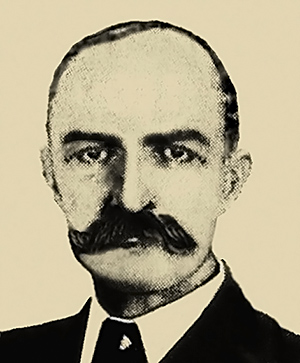
Walter L. Parker
Tampa City Councilman from
June 5, 1904 – June 7, 1906 and
Hillsborough Co. Commissioner
|
|
Mr. Parker was a member of many clubs and fraternal organizations, including the Rotary Club, the Masons and Elks. He held numerous important positions in his Tampa business career. including chairman of the board of county commissioners, member of the city council and library board, director of the South Florida Fair Association, and steward in the Methodist church. In March, 1891, Mr. Parker married Miss Annie Webb, daughter of R. F. Webb. The last two years of his life he spent mostly away from Tampa, seeking cure for his illness by traveling in search of better health, including to Denver, CO, and Asheville, NC. He died a in a hospital at Columbia, Ala., on Nov. 12, 1918, where he had been for just a few weeks. Mrs. Parker and Walter's brother, Nat Parker, were with him at the time. He was survived by his wife Annie Webb Parker, one daughter Mrs. Eugene Knight, and a son, Francis Webb Parker, one sister Mrs. J. Futch of Alachua, and four brothers: Nat of Tampa, Harry of St. Pete, T.C. of Baltimore, and C.C. of Lake City. Also a granddaughter Nancy Knight. Mrs. Parker was a sister of Goodlett Webb of Tampa Electric Co, Elmer Webb, V.R. Webb, and Mrs. M.W.Pollica of the DeSoto Hotel.
TAMPA CITY COUNCIL MEMBERS June 5, 1904 – June 7, 1906
Curren Elmore Webb, President
W.D. Wiggins, President pro tempore
James Robert Dekle,
Michael C. Foley,
Thomas C. Folsom,
Henry Clay Giddens,
John Thomas Gunn,
John Percy Hardee,
Ernest W. Monrose,
Walter L. Parker,
Joel B. Phillips "The City Council of Tampa," etc, adds: When the streets around it [the DeSoto hotel] were laid out, Parker Street was named after him."
Parker St. is nowhere near where the DeSoto Hotel was located. The streets in the area of the hotel, and all the others downtown, were named and laid out in 1848 by surveyor John Jackson. Parker Street is in Hyde Park just on the west side of the river at present Kennedy Blvd.
|
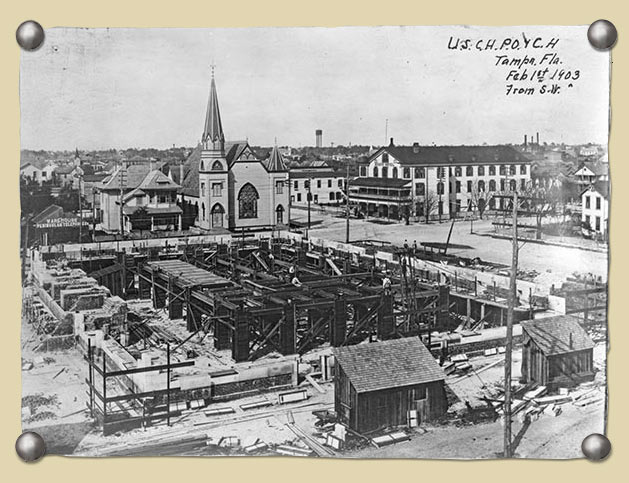 |
The 1903
re-photo at
left is from
the Burgert
Bros.
collection
at the Tampa
Hillsborough
Co. Public
Library. It
shows
construction
of the
basement of
the new U.S.
Customs
House-Post
Office-Federal
Courthouse
in the
foreground.
In the
background
is a
rare view
of the
original
wood frame
DeSoto
Hotel, which
in fact may
be the
only quality
photo in
existence.
Later photos
and post
cards show
the rebuilt
brick and
block hotel
that
replaced
this one in
1910.
Also seen
here is the
wood frame
First
Presbyterian
church which
was
relocated
from the
original
site where
you see the
construction
in progress.
Photo
courtesy of
the
Tampa-Hillsborough
Co. Public
Library
Cooperative,
Burgert
Bros.
collection
|
|
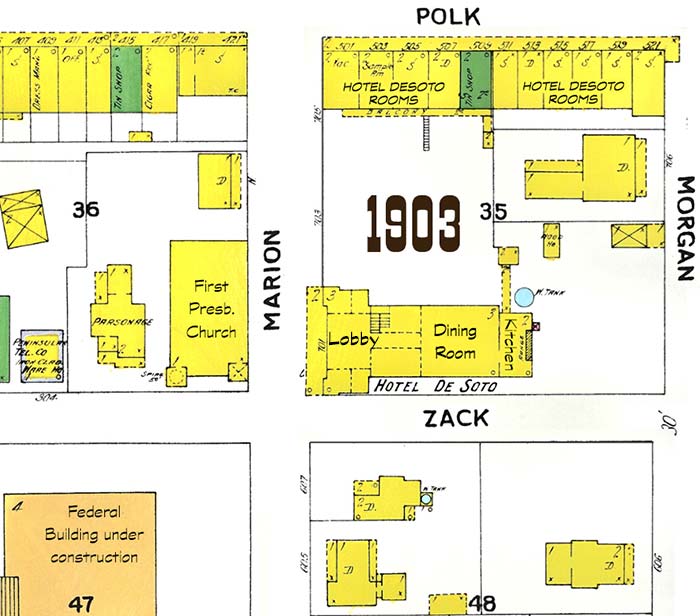
|
The four
blocks shown
here have
been moved
toward the
center of
the
intersection
to use less
area for
this
graphic.
The streets
are actually
about 80 ft.
wide, or
about twice
the width
you see
here.
This 1903
Sanborn map
from the UF
Digital Map
collection
shows the
area at the
time the
above photo
was taken.
The new
Federal
District
Courthouse
can be seen
under
construction
at lower
left
foreground.
The
Presbyterian
church
building was
moved from
where the
courthouse
was being
built to the
north side
of Zack
across from
the DeSoto.
THE FIRST
DESOTO ANNEX
Notice along
Polk Street
where there
were misc.
shops are
now hotel
rooms.
The first
four on the
left were
two-story,
with the
second room
being a
sample room.
Then in
green a tin
shop, then
five
one-story
rooms, then
one
two-story
room on the
corner of
Polk and
Morgan.
This whole
strip of
rooms was
known as the
annex to the
DeSoto.
In this
period
hotels
maintained a
vacant
"sample
room" so
prospective
guests could
see the
various
options
available
for
occupancy.
There was
usually more
than one
sample room,
with one
each
representing
the layout
and size
options.
Often, when
a hotel was
completely
booked, the
sample rooms
would then
be available
for rent
|
|
|
|
|
|
|
|
|
|
|
THE DESOTO
GETS A
COMPLETE
OVERHAUL AFTER W. D.
LEWIS
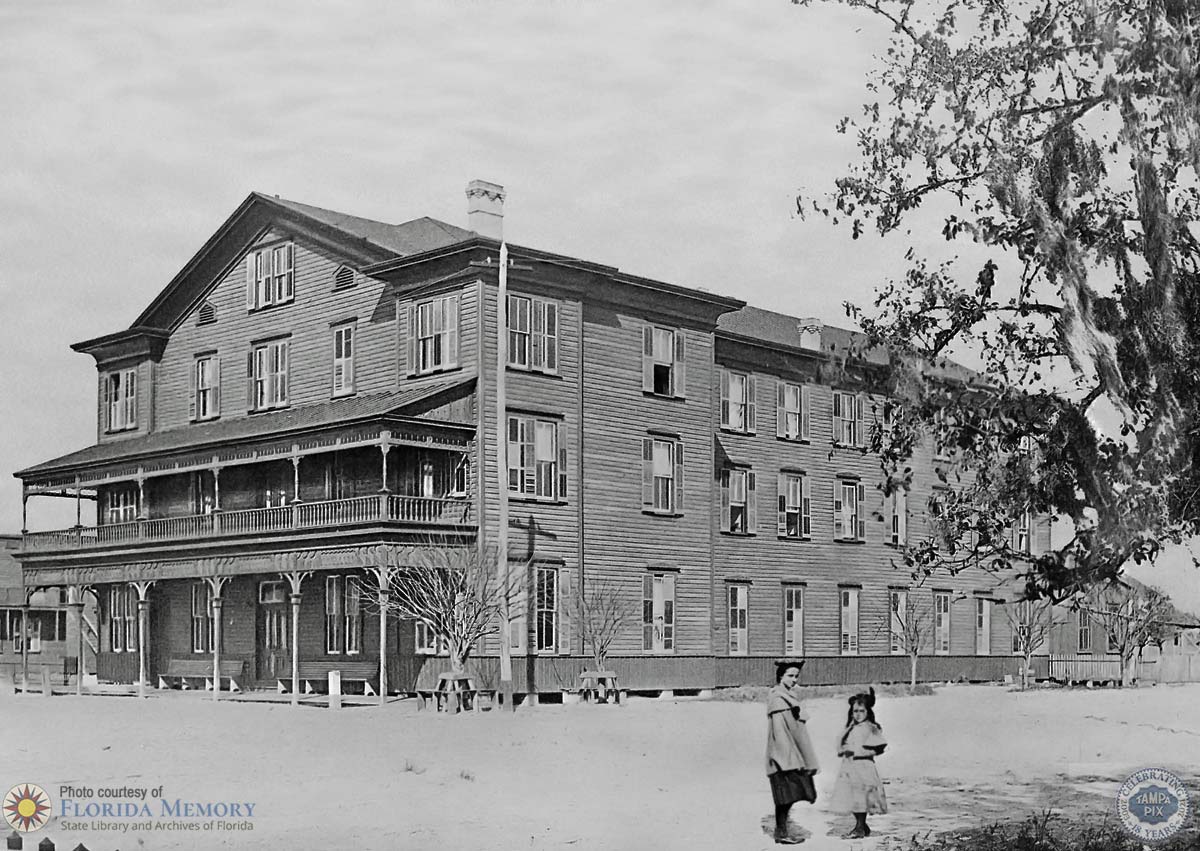
The DeSoto
Hotel in
1898
Photo
courtesy of
the State
Archives of
Florida.
This rare
photo below
shows the
original
wood frame
DeSoto Hotel
in 1903,
about six
years before
it was
completely
replaced by
a new brick
& block
four-story
structure.
It is the
upper right
portion of
the
previously
displayed
photo
showing the
Federal
Courthouse
construction.
At the far
left of the
photo can be
seen the
original two-story
annex to the
DeSoto,
which ran
along Polk
St. between
Marion &
Morgan.
The water
tank at
upper left
is at
Tampa's
first
waterworks
pumping
station
located at
the corner
of Estelle &
Jefferson
St.
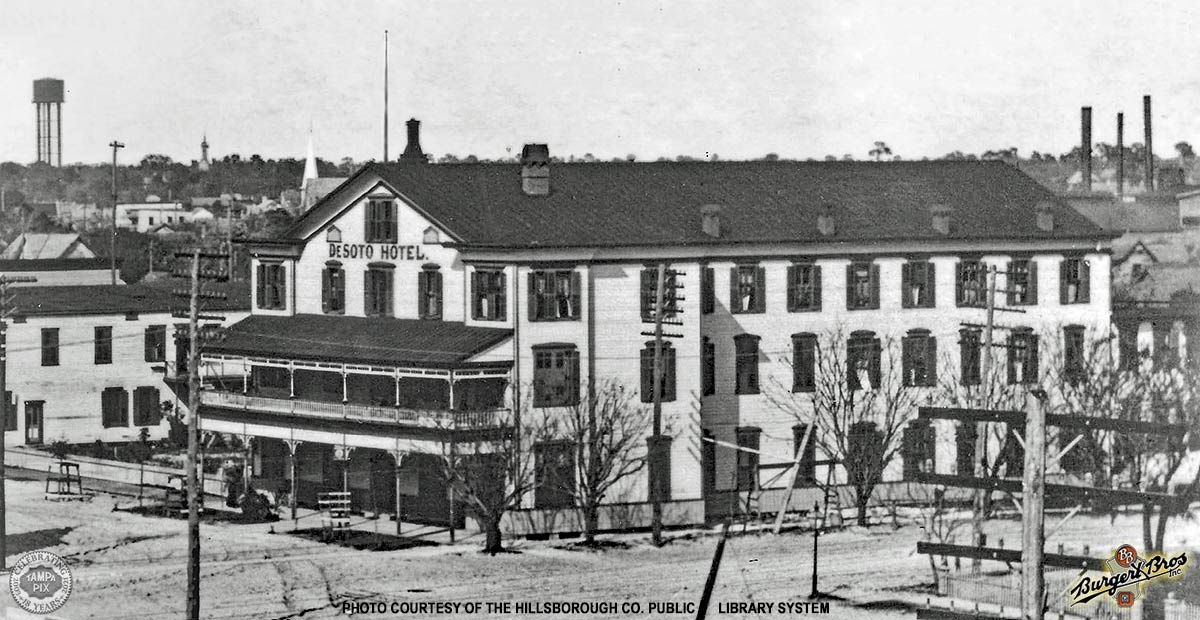
The original
wood frame
DeSoto
Hotel, Feb.
1, 1903.
BURGERT
BROS. HIGH-RES SCAN WAS
PROVIDED BY
THE
TAMPA-HILLSBOROUGH
CO. PUBLIC
LIBRARY
COOPERATIVE
(THCPLC).
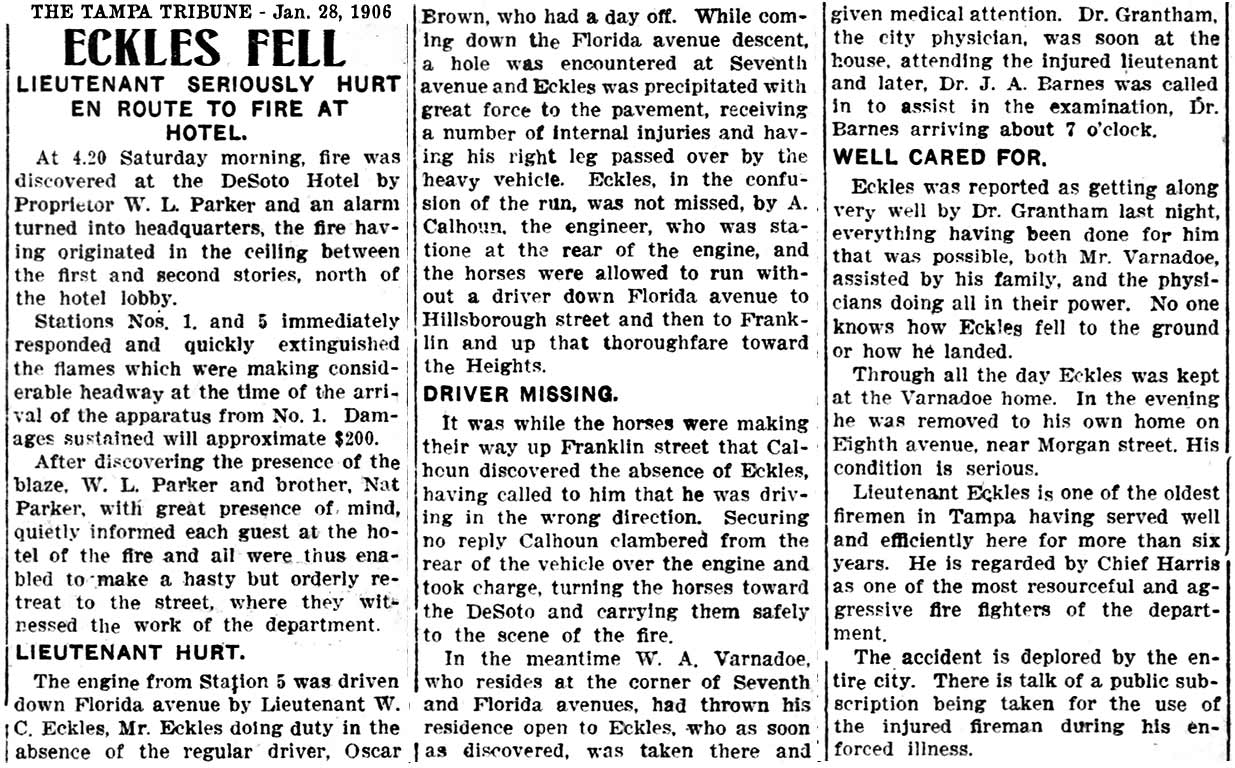
In the fall
of 1906,
Walter L.
Parker sold the
DeSoto to a
number of Ocala
developers
who were
associates
of his.
The new
expanded
ownership planned
to replace
the old wood
structure
with a four
story brick
and stone
building.
The
improvements
were
scheduled to
begin after
the State
Fair in
November.
The planned
improvement
of $150,000
along with
other
construction
projects in
Tampa set
a one-month
record high
of $210,432
for
November,
topping Oct.
1906 by just
over
$125,000.
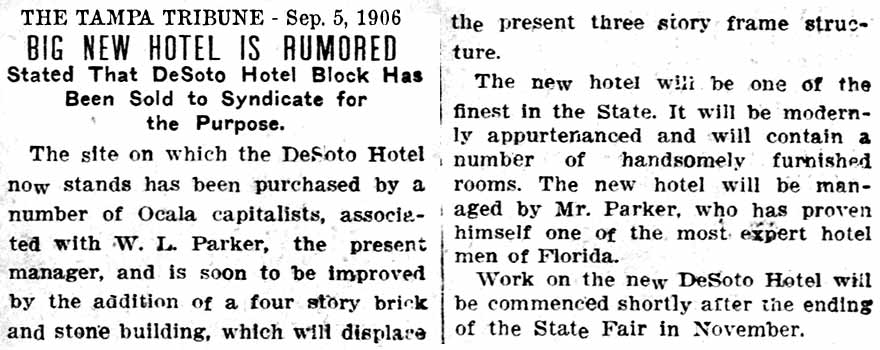
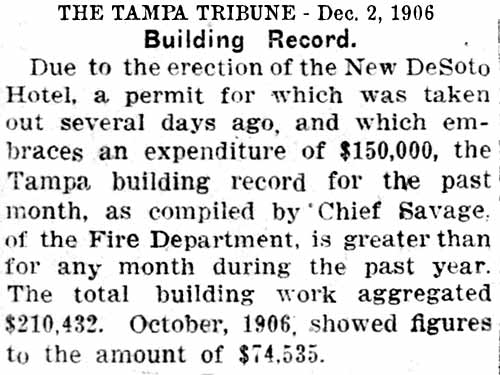
The new
construction
was touted
as the
largest
permit in
the history
of Tampa,
with the
possible
exception of
H.B. Plant's
Tampa Bay
Hotel, the
new Sacred
Heart
Catholic
Church, and
the new
Federal
Building.
The hotel
would be
known as the
"New DeSoto"
which would
be built
fireproof
with steel
beams, with
it's own
electric
power plant
and steam
laundry.
It would
take up the
whole block
between
Polk, Zack,
Morgan, and
Marion
Streets and
have three
entrances.
The new
building
would be 210
feet square,
eventually
taking up
the whole
block, with a space
for a
courtyard of
around 50 x
100 feet.
The whole
project
would be
done in
phases, with
the original
building
remaining
until the
greater part
of the new
hotel was
completed.
It was
expected
that Elmore
Webb would
oversee the
project.
Architect of
the Tampa
Bay Hotel, J.
A. Wood, was
hired to
design the
the new
hotel.

| The first to go was the two-story wood structure along Polk St. that was built as an annex with extra rooms for the original wood frame hotel. 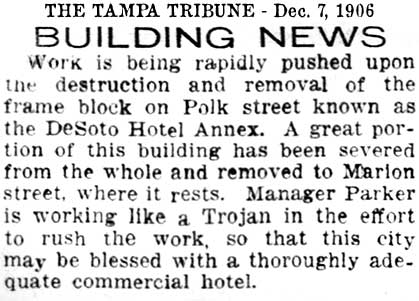
|
By the end of Feb. 1907, a new foundation had been laid along Marion St. and Polk St. This was for the north wing on the northwest corner of the lot and the main building that fronted Marion Street.
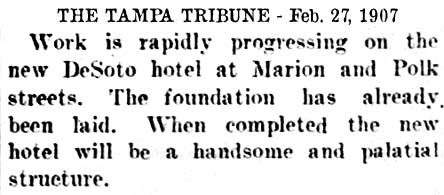
|
As construction on the main building progressed rapidly, a fancy ink well trimmed in silver with onyx pedestal and silver pole supporting incandescent lamps was received from the American Hotel Supply Co.
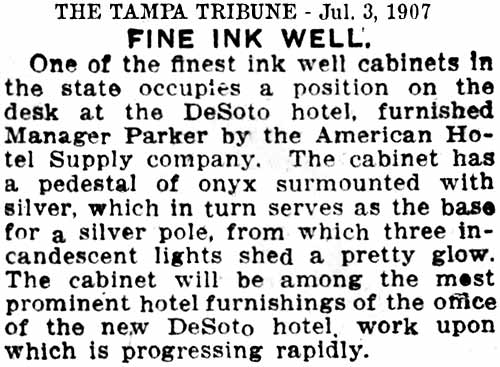 |
|
Owner of the DeSoto W.L. Parker announced in late July 1907 that the old DeSoto would close on Sat., Aug. 3. He originally planned to keep it open longer but work was progressing so quickly on the new hotel that they needed to start the next phase of construction: moving the old building to the rear of the lot to make room for the south wing of the main building.
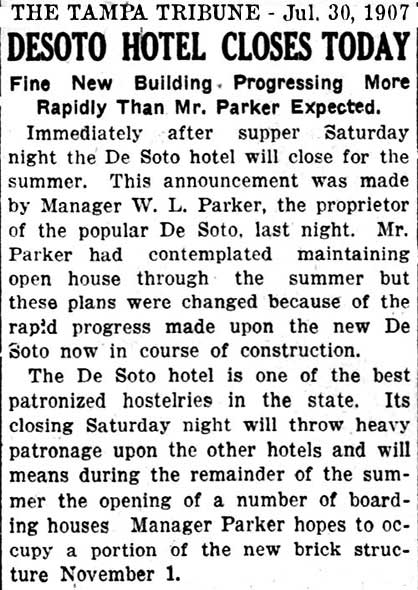
|
By Sep. 1907, the old structure had been lifted, rotated 90 deg. counterclockwise, and moved to the rear of the property along Morgan Street. This second phase, the annex, would be completed as soon as possible so as have space for temporary offices, some rooms could be refurbished on the upper floors and a large dining room created on the ground floor. 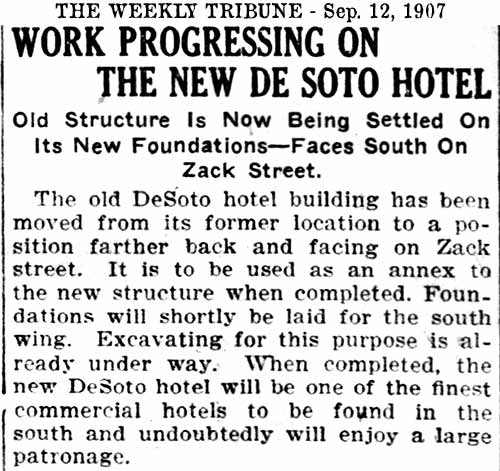
|
By the end of Oct. 1907 the concrete floor, roof and cornices of the new building were being worked on. A probably opening of January was a highly optimistic guess. The old three-story building was to reopen next month; this was another optimistic prediction. 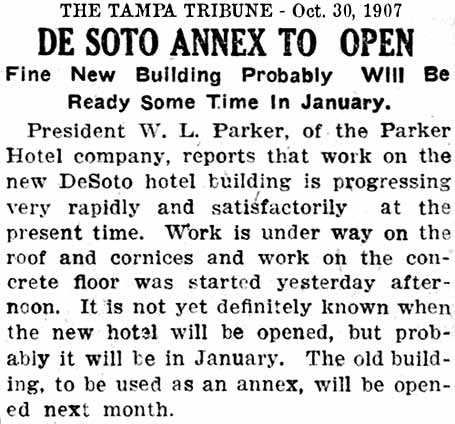
|
The
original
3-story
wood
frame
building
was
rotated
90 deg.
counterclockwise
and
moved to
east
side of
the
block
along
Morgan
St.
In
mid-November
1907 the
projected
completion
dates of the
main
building and
the annex
were
pushed back
due to
difficulty
in obtaining
some
building
materials.
A portion of
the main
building "will
in all
probability"
be ready for
occupancy by
Jan. 1 and
the annex
was expected
to open in
early
December.
J. A. Wood
was expected
to flip the
switch on
the lighting
at night
within a
short time.

|
|
The newly relocated and refurbished annex was opened to guests on the evening of Nov. 30, 1907 and the first meal was served the following night, Dec. 1. W. L. Parker had no estimated date that the completely new main building would be finished.
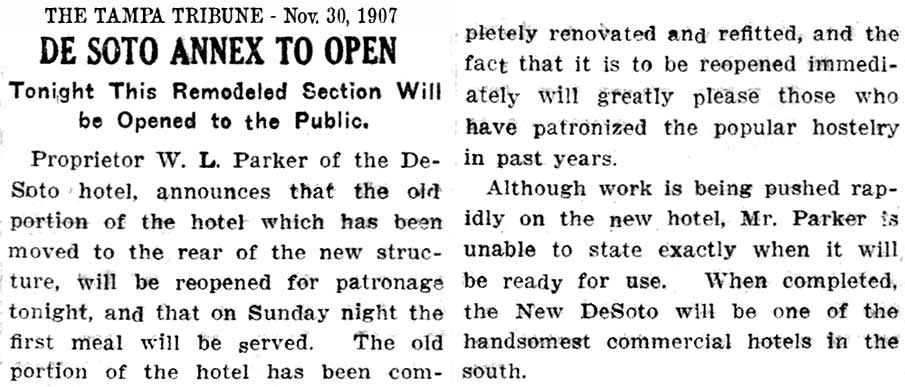 |
 |
|
|
Architect J. A. Wood was furnishing and completing new rooms in the main building every day. A large number of rooms were expected to be ready for guests in early February, just in time for state fair visitors. |
In early Feb. 1908 the plumbing contract for furnishing and installing fixtures to the new annex was awarded to Joughin Bros. This was a prestigious accomplishment for that company as their work was under the supervision of noted architect J. A. Wood, and it called for fine plumbing and expensive fixtures. |
|
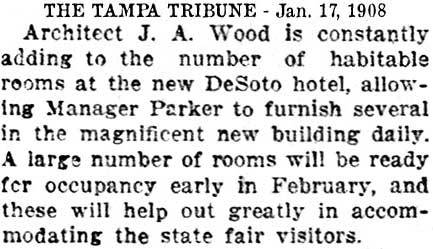
|
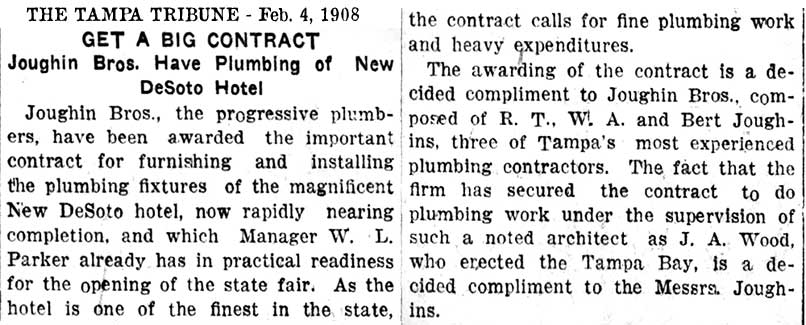
|
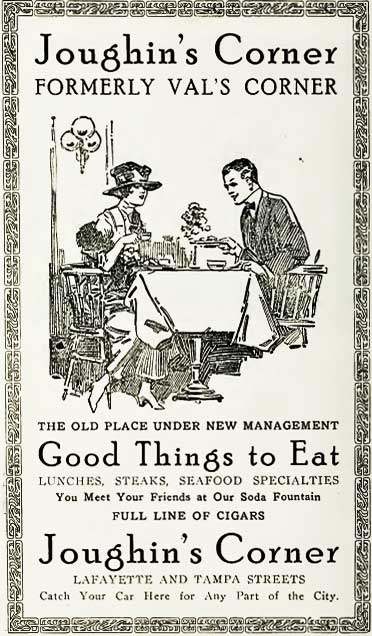 |
ROBERT T. JOUGHIN Born in Terrel, Texas in 1880, Bob Joughin moved to Sanford, FL in 1884 with his parents. He received his early education there and later took special commercial, plumbing and heating engineering courses. He came to Tampa in 1897 and worked odd jobs for a few years, learning to be a plumber under the apprenticeship of K. R. Lau Plumbing Co. In 1904 he went into partnership with W.E. McAndrews and soon into business for himself as Joughin & McAndrews. A year later, his brother, W.A. Joughin, bought McAndrews' interest in the company and the firm became Joughin Brothers Plumbing & Heating Co. In 1909, he married Miss Lula M. Jackson, a granddaughter of early Tampa pioneer and surveyor John Jackson. In 1917, Bob Joughin bought his brother's interest when W.A. entered the army and his company became R.T. Joughin, Inc. Knowing the business from the ground up, Mr. Joughin was enabled to secure and carry out the plumbing and heating contracts for the largest buildings in Florida.
In addition to his plumbing business, in the early 1920s he owned "Joughin's Corner," a large cigar, refreshment and restaurant business at one of the most prominent corners in Tampa, Lafayette & Tampa St. Always in interested in politics, Mr. Joughin served for twelve years as a member of the Democratic Executive Committee.
Image at left from "Rinaldi's Guide Book of Tampa", 1922. |
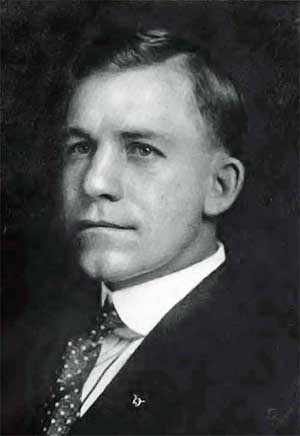
R. T. Joughin, ca. 1915
Image above from "Men of the South" See full reference below.
|
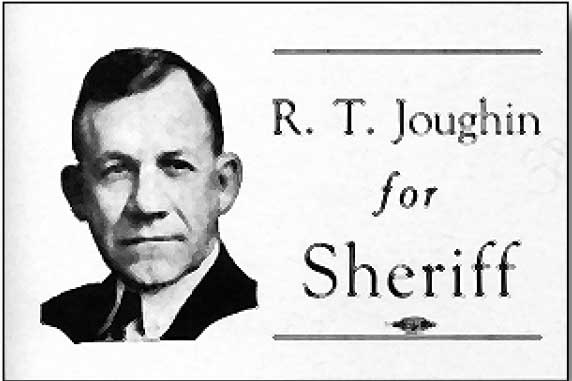 |
|
Image from "Smoking Guns"
See full reference below. |
In 1928 Joughin was appointed to serve as sheriff of Hillsborough County by Gov. Doyle E. Carlton as a result of controversy concerning alleged corruption of the current sheriff, L. M. Hatton. Joughin served for three years as Sheriff during the "smoking guns" gangster era in Tampa. Joughin's daughter, Lula Joughin Dovi, was an author and a writer for the Sunland Tribune, Journal of the Tampa Historical Society. In her article about her father, "Smoking Guns," she wrote: "My father was called from his plumbing and heating contracting business by then-Governor Doyle E. Carlton to begin serving the unexpired term of the Sheriff who was suspended. And as I recall that period I remember seeing a machine gun sitting in the corner of his bedroom and two pistols resting under his pillow. There was an ever present threat of ambush."
Sheriff Joughin ran for re-election in 1932 but lost. There were rumors of ballot box "stuffing." Former Governor Carlton told Lula when her father died in 1961 that he and her father were told about a polling place where there was allegedly some ballot box "stuffing." The two of them were getting ready to go check out the rumor when, as Carlton recalled, "We remembered we didn’t have any guns on us." |
| LULA JOUGHIN DOVI, native of Tampa, a daughter of Sheriff R.T. "Bob" Joughin, was a great-granddaughter** of John Jackson, surveyor of downtown Tampa and many areas of Florida, through her mother. A 1940 graduate of Plant High School, she received her A.B. degree from Florida State University and her M.A. degree from University of South Florida. She was a countywide coordinator of social studies and art for Adult and Community Education, Hillsborough County Public School System and served as vice chairperson of Hillsborough County Democratic Executive Committee and as a member of the board of Carrollwood Civic Association, and attended the Democratic National Convention as an alternate delegate. She was a member of Phi Delta Kappa, educational honorary. **The original Sunland Tribune article says she is the granddaughter, but that is not the case. John Jackson and wife Ellen Maher Jackson had four children, their oldest was son Thomas E. Jackson. Thomas married Kate E. Warner. Of their children that reached maturity was their third child, Lulu Marguerite Jackson, who married Robert T. Joughin. These were Lula Joughin Dovi's parents.
"Smoking Guns of Tampa" by Lula Joughin Dovi, THE SUNLAND TRIBUNE Vol. XIV Nov, 1988 Journal of the TAMPA HISTORICAL SOCIETY, at USF Scholar Commons.
"Men of the South, A Work for the Newspaper Reference Library" Southern Biographical Association, 1922 at Internet Archive
History of the City and the Tampa Bay Region of Florida,
by Karl H. Grismer, edited by D. B. McKay, 1950.
"Genealogical Records of the Pioneers of Tampa" by Charles E. Harrison, 1915

|
|
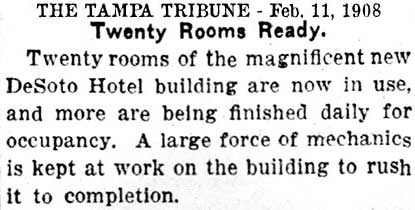
In mid Feb. 1908, twenty rooms were "now in use" but the article doesn't say what they're being used for. "More are being finished daily for occupancy" doesn't really clear it up as "occupancy" doesn't specify guests. |
|
In late April 1908 Parker decided that no more new additions would be constructed until the main building was completed. A seventy-five foot long porch verandah was under construction. The lobby would be 62 ft. by 62 ft. and it was expected that over 62 rooms ready soon. It would seem that guests were already booking rooms, whether or not they were occupied at the time remains to be seen. |
|

|
|
|
|
In late May 1908 a contract for tile floors was awarded to "Prof. O. H. de la Morton" for floors in the offices of the new building. The work was expected to start as soon as the materials arrived.
|
|
|
|
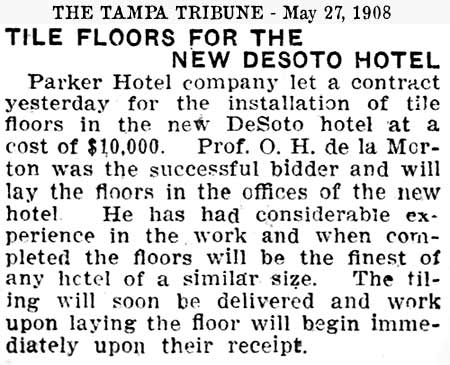
|
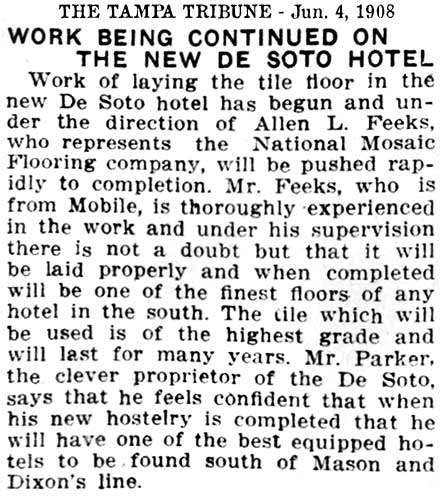
|
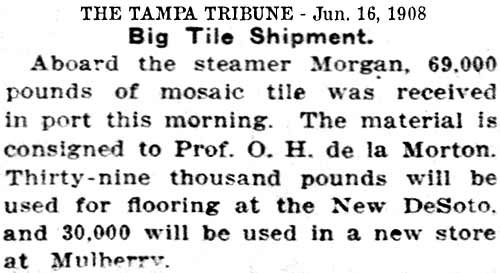
|
|
|
|
|
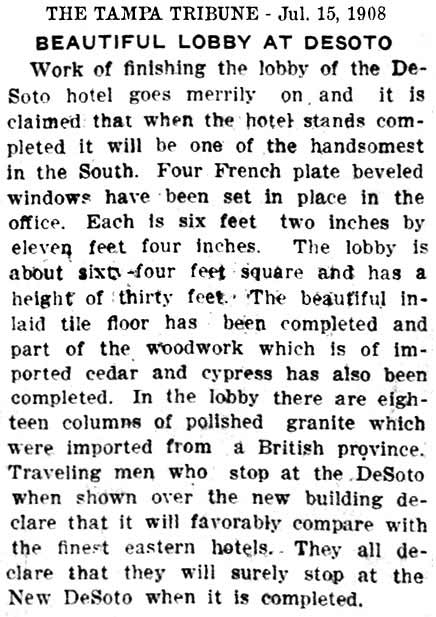 |
The main building was almost completed in the latter third of August, pending the arrival of office furniture and electrical fixtures. The office, which was temporarily in the frame annex, was to move to new building and the old office space in the annex was to convert to a dining room. |
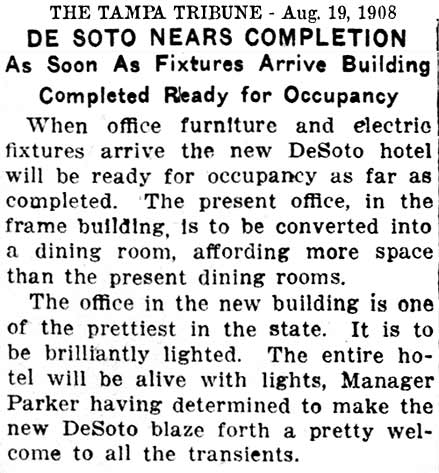 |
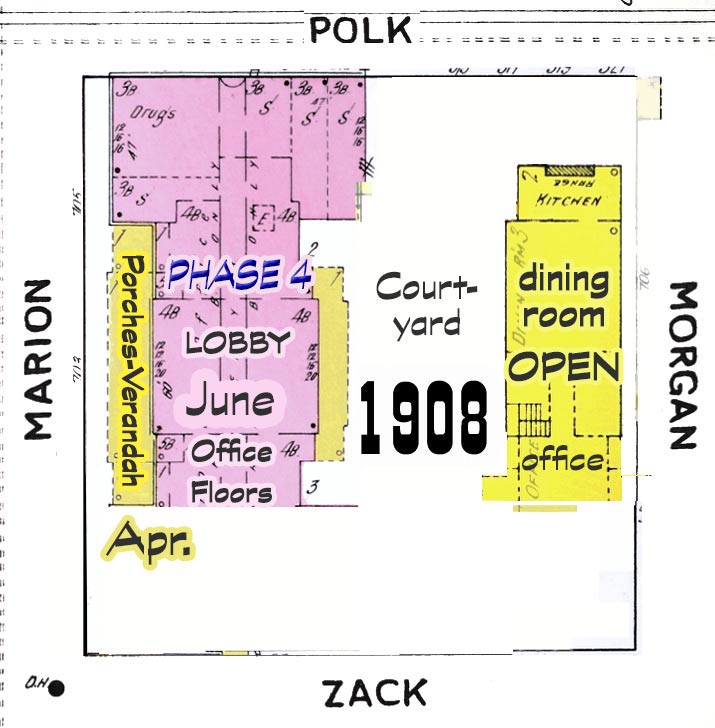 |
|
NOT THE ANNEX
This Sep. 11th article is improperly titled, as it is not the annex but the main building that was ready for occupancy in about a week. 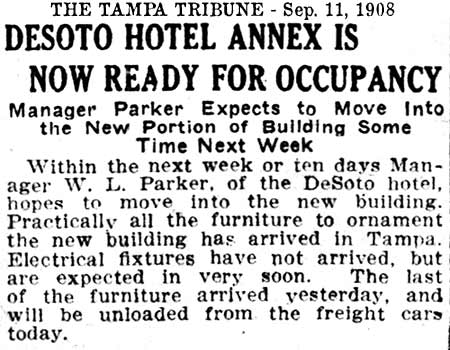
|
On Sep 18th, 1908, Parker announced that the completed portion of the main building would be opened on the following day, and dinner would be served in the temporary dining room at 6:15. Here, the reporter refers to the main building as the southwestern wing. There is no doubt it is the main building since it is the location of the lobby and the excavating at the southwestern corner had not yet begun.
Parker was making the plans to finish the rest of the building--the south wing, but had not yet determined when that would start. |
|
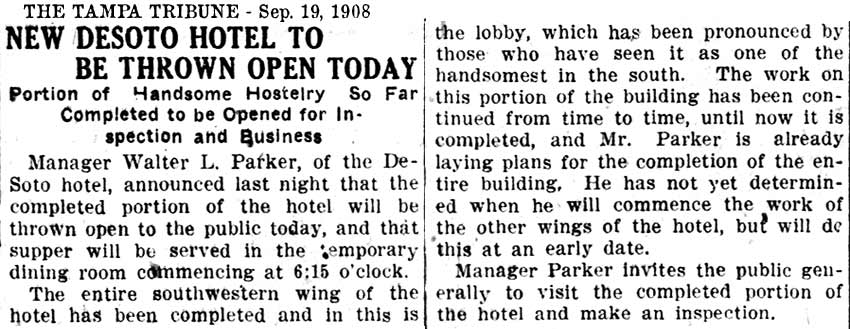
|
| |
|
| In late Sep. 1908, with the exterior completed and some minor interior work being done, owner W. L. Parker is presented with a bouquet of roses from a shoe company that was having a convention there. The convention put a strain on room availability, but all went smoothly on opening day, "this has not daunted Manager Parker." The hotel was described as "Well lighted and imposing, presenting an attractive appearance to the ey and proving to be a great drawing card." |
|

|
| |
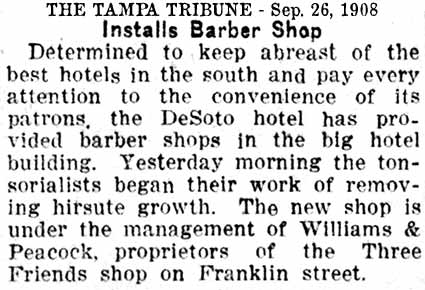 |
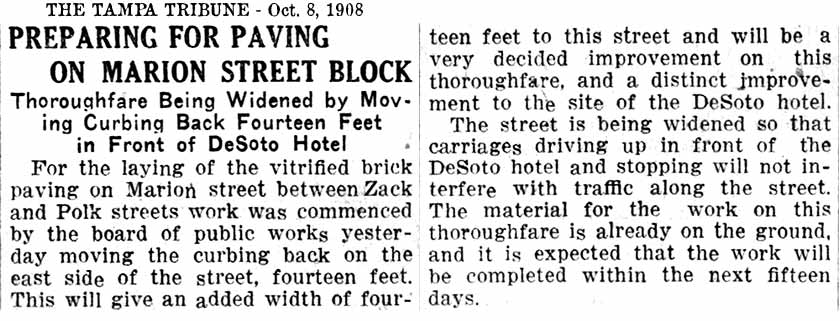
|
In late Sep. 1908, Williams & Peacock, the owners of the "Three Friends" barber shop on Franklin St, opened on in the DeSoto.In mid October 1908, Marion Street in front of the hotel was paved and widened, so that traffic wouldn't have to stop when passengers were being dropped off. Later, this would cause a big stink when a city auditor finds that the bill for this was footed by the city and not the hotel.
The placement of the dining room and barber shop on the map at right is arbitrary and not necessarily where they were actually located.

|
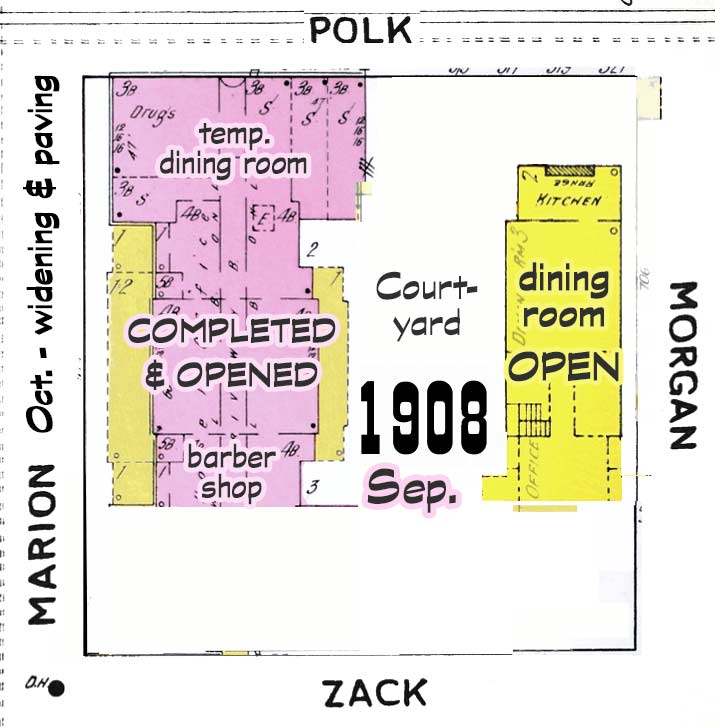
|
| |
|
| In late Jan. 1909 Parker had the old sidewalk torn out and was replacing it with a new 9 ft wide cement walk. |
In mid-May 1909 it was announced that by the end of the year and into next spring, 1910, work would start on building the new south wing at the corner of Marion and Zack. The spring months of 1909 were prosperous for Parker and the upper floors of the new wing would provide additional rooms. It was imperative that this be done before the opening of the next winter season on 1910. |
|
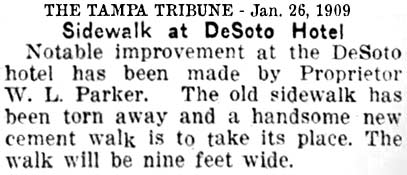
|

|
|
|
|
|
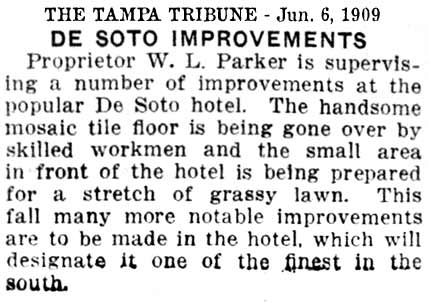
|
|
|
July 4, 1909 - Cigar distributor Eli Witt, who's motto was, "Cigars, that's my business!" bought the shop from Joseph Palmer in the post office which was in the basement of the new Federal building and negotiated with W. L. Parker to put a cigar/newspaper stand in the DeSoto, leaving Palmer to manage both places. The finest of fixtures would be arriving soon. 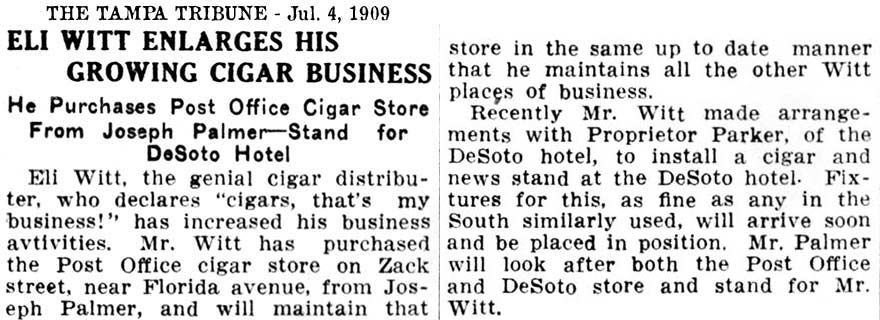
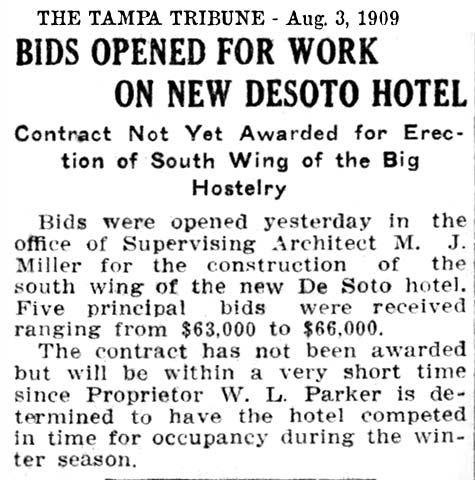
In early Aug. 1909 bidding was opened for a contractor to build the new south wing of the hotel. Five principal bids were received ranging from $63k to $66k. A decision from Parker was expected soon because he was eager to open the hotel in time for the upcoming winter season.
Parker decided not to contract with a construction company because he thought the bids were too high. His estimate was that the south wing could be built for $50,000 to $60,000 using freelance carpenters. By mid-August 1909, work had begun on clearing the south half of the property to build the south wing foundation. The south wing was to be a duplicate of the north wing. Carpenters had begun work on excavating for the foundation but Parker was using "day labor."
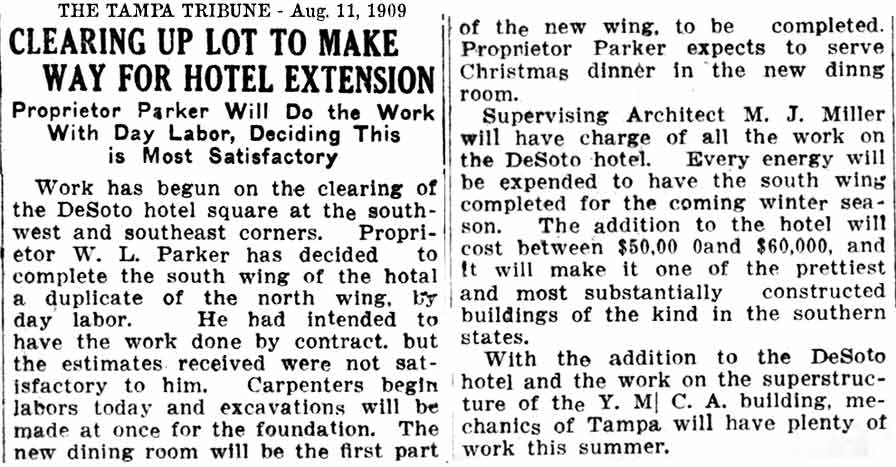
|
Within a month after the news was released, Witt had his stand up and running in the DeSoto. The fixtures had just been installed the night before, all bought from and installed by E. R. Beckwith. Parker and Witt were both pleased with the results, which also included a newspaper stand. The shop was situated in the southeast section of the lobby.
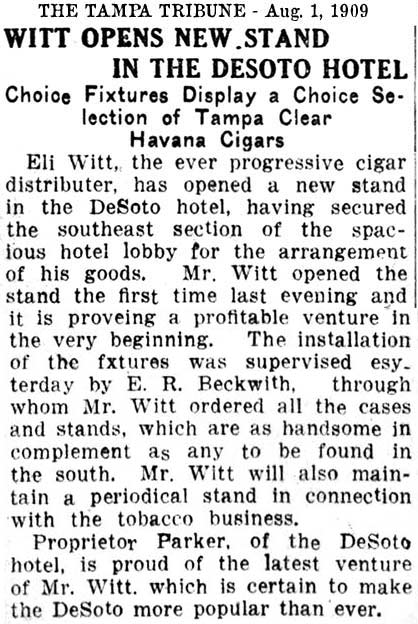
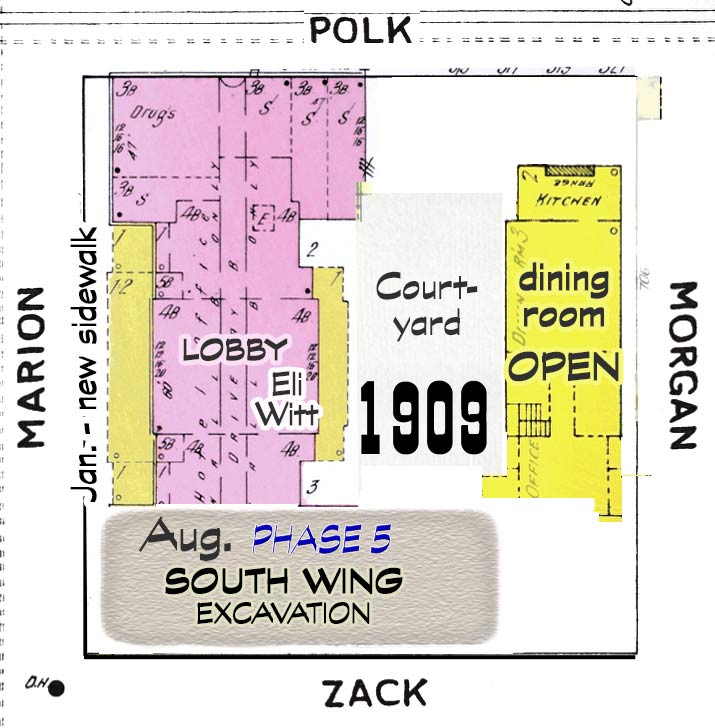
|
| |
|
|
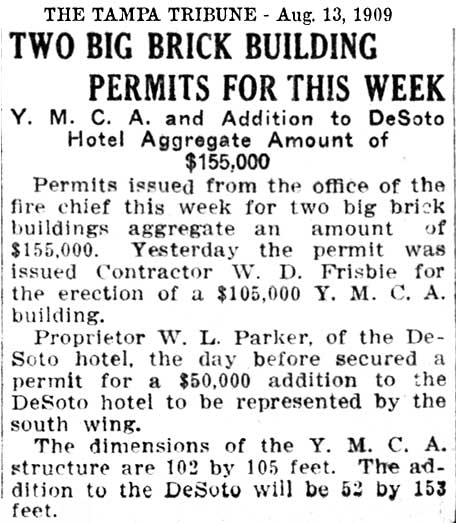

In mid-August 1909 a permit of $105k was issued for construction of the new YMCA building, and another for $50k to Parker to build the new south wing of the Desoto. This was $13k less than the lowest bid he received from construction companies earlier this month. The entire south wing was to be 52 ft x 153 ft. but a later article shows that the entire wing wasn't built at this time. |
|
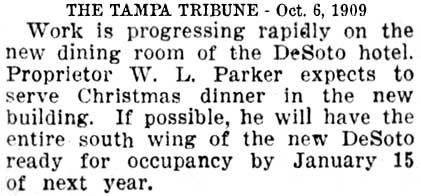
|
In early Oct. 1909 Parker was trying to get the new dining room on the first floor of the new south wing completed in time to serve Christmas dinner in it. The whole wing was expected to be completed for occupancy by Jan. 15, 1910. |
|

|
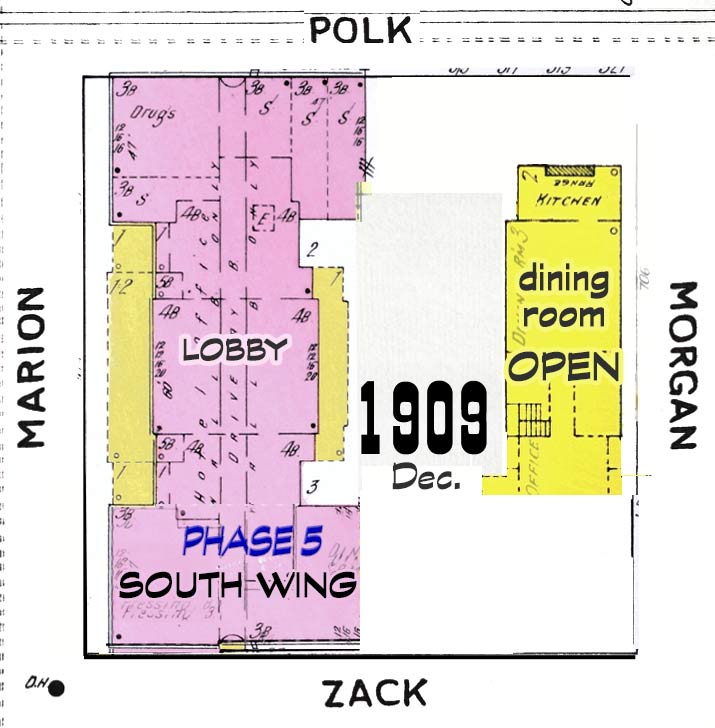
The roof of the south wing was completed in late Oct. 1909.
In early Nov. 1909 C. E. Webb said the new addition was 50 x 80 feet, with the lower floor devoted entirely to dining purposes. Its 80 ft. length indicates that it did not extend all the way along Zack St. to Morgan St. as the Aug. 13 permit described (52 x 153.) The second floor would house 27 sleeping rooms with baths. It's not clear if the remaining work on the south wing is a reference to this nearly completed structure or to the next phase which was to extend this wing along Zack St. towards Morgan St. |
|
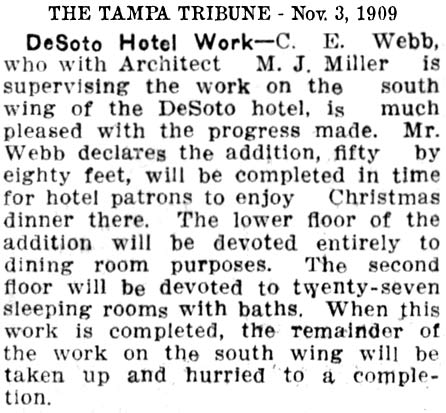
|
|
|
|
| |
|
|
|
By Nov. 20, 1909, work had begun on the interior of the new south wing. Parker expected to serve Christmas dinner in the new dining room a month later. 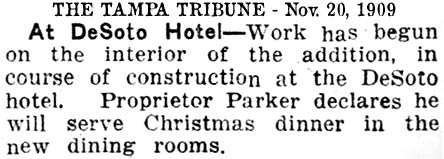
|
Fifteen days before Christmas and Parker thinks he will be serving dinner in the new dining rooms "even before Christmas."
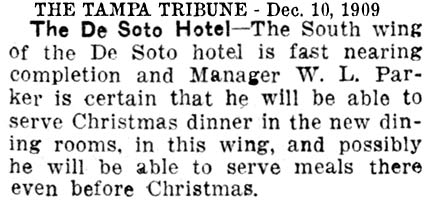 |
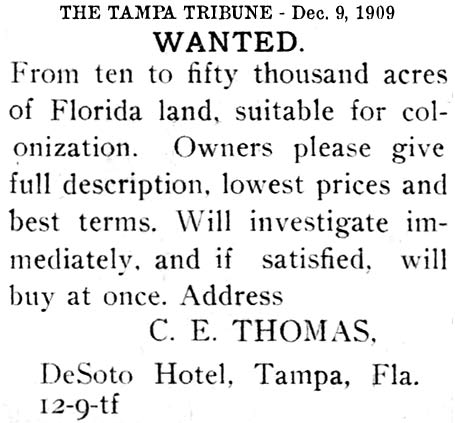
|
|
In mid-December 1909 workmen were rushing to place the finishing touches on the new dining room in the south wing and Parker expected to serve guests there in two days. The new dining room was described as "a model of artistic beauty, roomy and well arranged." Solid marble columns ran its entire length down the middle of it and on each side with the room being steam heated. Ten electric fans cooled the room in the summer and 48 electric lights lit the room. A private dining room "of magnificent proportions" adjoined the main room on the north. 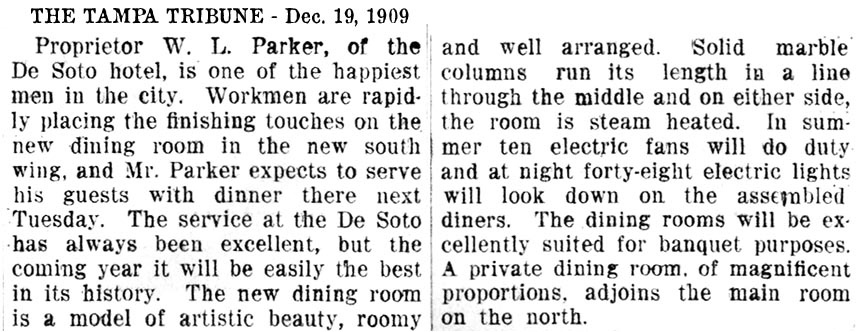
 Tuesday was Dec. 21, but after the above article on the 19th, nothing more is found in the papers about the Desoto (except for a handful about who was staying there, and the one at right) until Christmas day. Tuesday was Dec. 21, but after the above article on the 19th, nothing more is found in the papers about the Desoto (except for a handful about who was staying there, and the one at right) until Christmas day.
Parker had a farm north of West Tampa where he raised produce and possibly livestock to supply his hotel. |
C.E. Thomas, along with a group of other Chicago investors, formed the "North Tampa Land Co." around 1905 and in 1910 bought 32,000 acres of land 20 miles north of Tampa near Stemper. The Chicago-based company advertised their plans extensively all over the North and Midwest in newspapers, focusing heavily on Michigan, Indiana and Ohio. They developed the area into the town of "North Tampa" which in 1913 was renamed "Lutz."
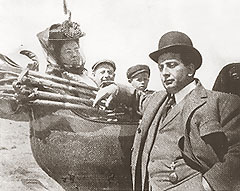
Read about this at TampaPix's History of Lutz 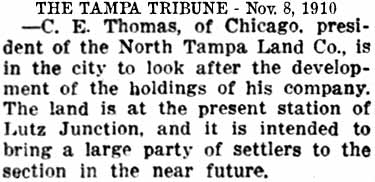
|
|
|
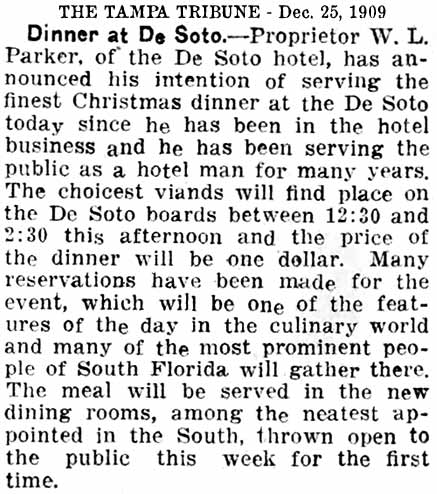
CHRISTMAS DAY, 1909
Workers must have really felt pressured to finish the interior dining rooms but they got it done just in time, as no announcement was made in the paper until Christmas morning that dinner would be served on time.
The finest dinner that Parker had ever served since he had been in the hotel business, consisting of "the choicest viands, "will find place on the DeSoto boards between 12:30 and 2:30 p.m" for ONE DOLLAR.
This may sound ridiculously cheap but according to the Dept. of Labor statistics Consumer Price Index, $1 in 1909 is equivalent in purchasing power to about $28.35 in 2020. Still not a bad price for a first-rate meal.
Apparently the news of the dinner was out on the street before the article which said many reservations had already been made.
|
|
On Jan 19, 1910, two fires broke out that could have been disastrous, but both were quickly contained with little loss. |
|
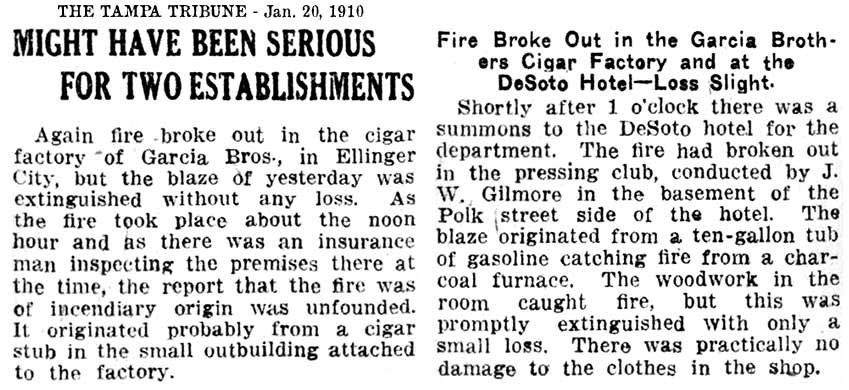
|
The fire at the Garcia cigar factory in Ellinger City (later it was called Roberts City) was ruled not of incendiary origin. Today we use the term "arson." Interesting that an insurance inspector was on the premises at the time. Being the worst possible time for a fire to take place, one would think immediately of the competition as suspect, or at least a disgruntled employee, and back then there were plenty. At the DeSoto hotel, a fire broke out in the "pressing club." Today we call it the laundry room. Why would they have a tub of gasoline in a laundry room?
This is why: |
|
According to research published by the National Institute of Dry Cleaning, turpentine spirits, camphor oil, benzene, naphtha, kerosene, and white gasoline were common dry cleaning solvents in the late 19th century. In 1898, carbon tetrachloride imported from Germany was sold as a dry cleaning and spot-removal agent and in the early 1900s, raw white gasoline was the primary dry cleaning solvent used in the U.S. Around the early 1900s, distillation was first used to purify spent solvents. Steam presses came into operation in 1903 and by 1905, clarifying systems, including settling tanks, were used to purify dirty solvents. By 1915, the average U.S. dry cleaning operation used approximately 12,000 gallons of gasoline per year. It wasn’t until 1924 that Lloyd E. Jackson and W.J. Stoddard developed specifications for a higher flash point petroleum dry cleaning solvent, which later became known as the Stoddard solvent. In 1928, the U.S. Department of Commerce required a minimum flash point of 100 degrees Fahrenheit for petroleum dry cleaning solvents, which resulted in drycleaners beginning to use the Stoddard solvent.
(Info from The History of Drycleaners Written by: Ruxandra Niculescu, CEO of REM.)
|
| |
|
In late July 1910 it was announced that Parker expected the new south wing addition to be completed by October 1 that year. Later plans included an improved courtyard with a pool containing alligators, and a garden cultivated with flowers. With the new south wing the DeSoto was to have 150 rooms. 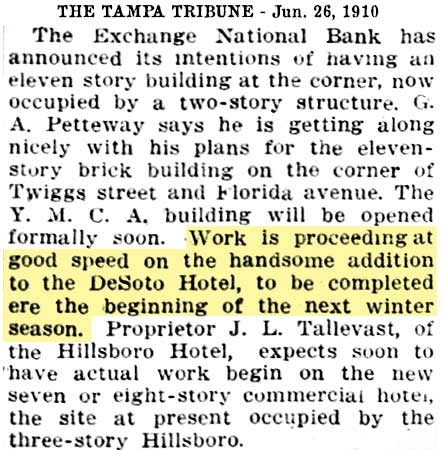
|
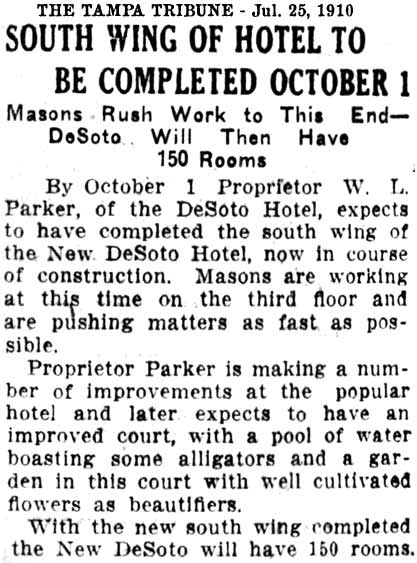
|
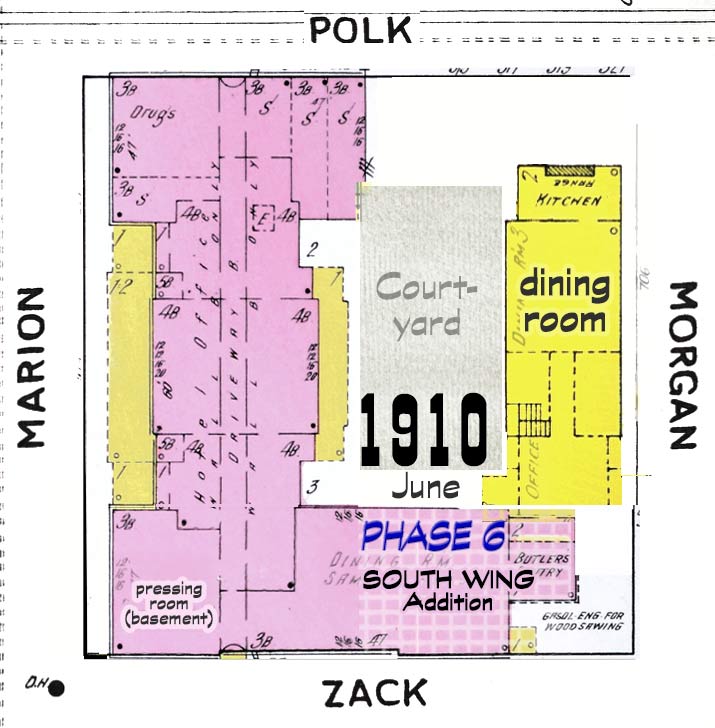
|
| |
| In late August of 1910, the new south wing addition was progressing rapidly and expected to open in time for the winter season rush. The construction of the wing and other improvements was an outlay of $30,000. |
The corner of Polk and Marion Streets was undergoing many great improvements toward the end of summer, 1910. A new brick ice plant was planned for the northeast corner and the lumber from the heavy hauling offices of W. O. Hobbs, which currently occupied the corner, was torn away to be used to build cottages elsewhere. Parker planned to tear away the last remaining wood structure at that corner and build on the the hotel with more brick buildings. |
|
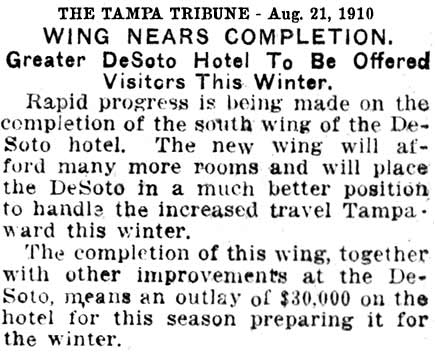
|
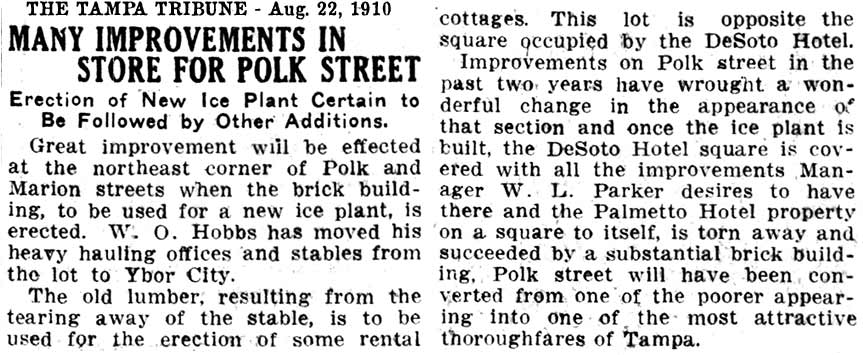
|
| |
| W.L. Parker reported that Sep. 4, 1910 was the best business the hotel had done in the past four to five months. Reservations from northerners planning to spend the winter in Tampa were beginning to increase and Parker was looking forward to the best winter in the history ofd the DeSoto. |
A journeyman's plumbers strike in Oct. 1910 caused a shortage of plumbers at various establishments around Tampa. Master plumbers were expected to fill the void which along with the cigar workers stirke, was causing a limited number of jobs available in construction. Serving as a Journeyman Plumber is a key requirement of becoming a Master Plumber. Although a Journeyman and a Master Plumber are both licensed as plumbers, a Journeyman's work centers on plumbing only while a Master Plumber can own a plumbing business, supervising other plumbers and is experienced at plumbing as well as business management.. |
|
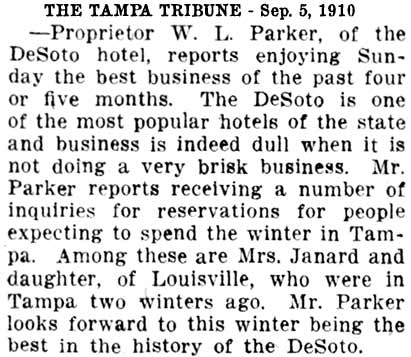
|
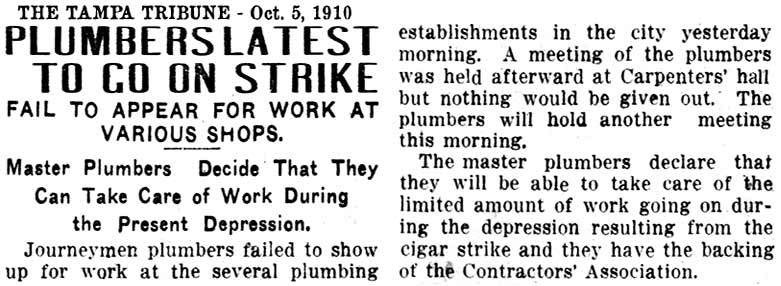
|
| |
| |
|
|
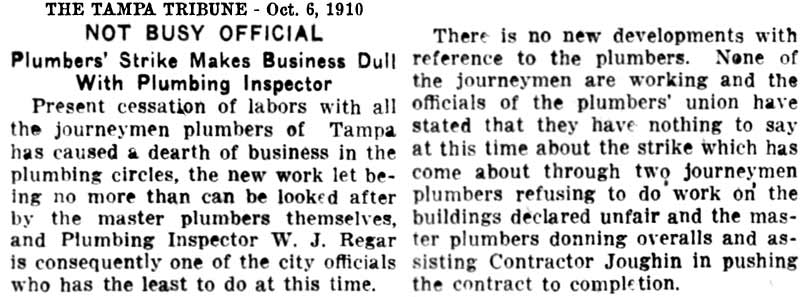
|
The plumbers strike left Tampa's plumbing inspector W. J. Regar with little work to do. The plumbers union had nothing to say about the strike which came about due to two journeymen plumbers who refused to do work on the buildings declared unfair. |
| |
|
| |
|
|
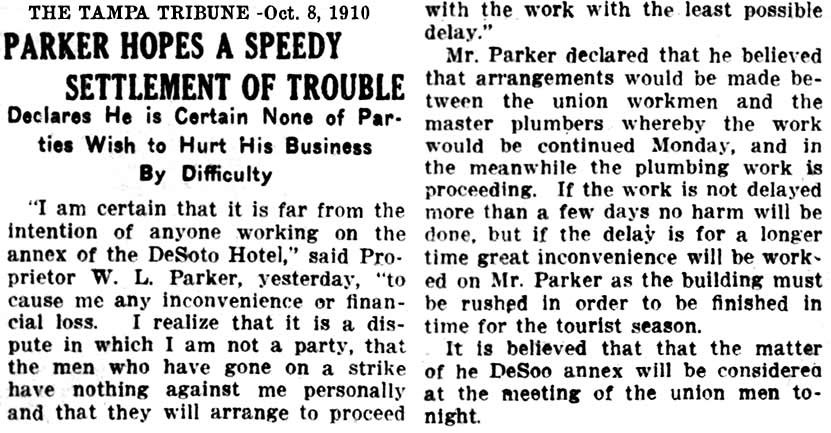
|
W. L. Parker spoke out saying he was sure that the strike was nothing personal directed against him and that he believed something was being worked out so that work on the DeSoto would not be delayed more than a few days. If the delay was to be longer, it would be a great inconvenience and cause a rush to finish in time for the tourist season. |
| |
|
| |
|
|
At a meeting of the Contractors' Association, it was decided that to pass a resolution approving the use of any class of labor to complete construction on the DeSoto. The strike had expanded to include carpenters, plasterers and painters in early October. Contractors were surprised when their employees walked out because none of them had ever been accused of being unfair with their workers. "Both Mr. Webb and myself have been among the best friends that union men have in Tampa" said Mr. Pimberly of the Buildings Trades Council. 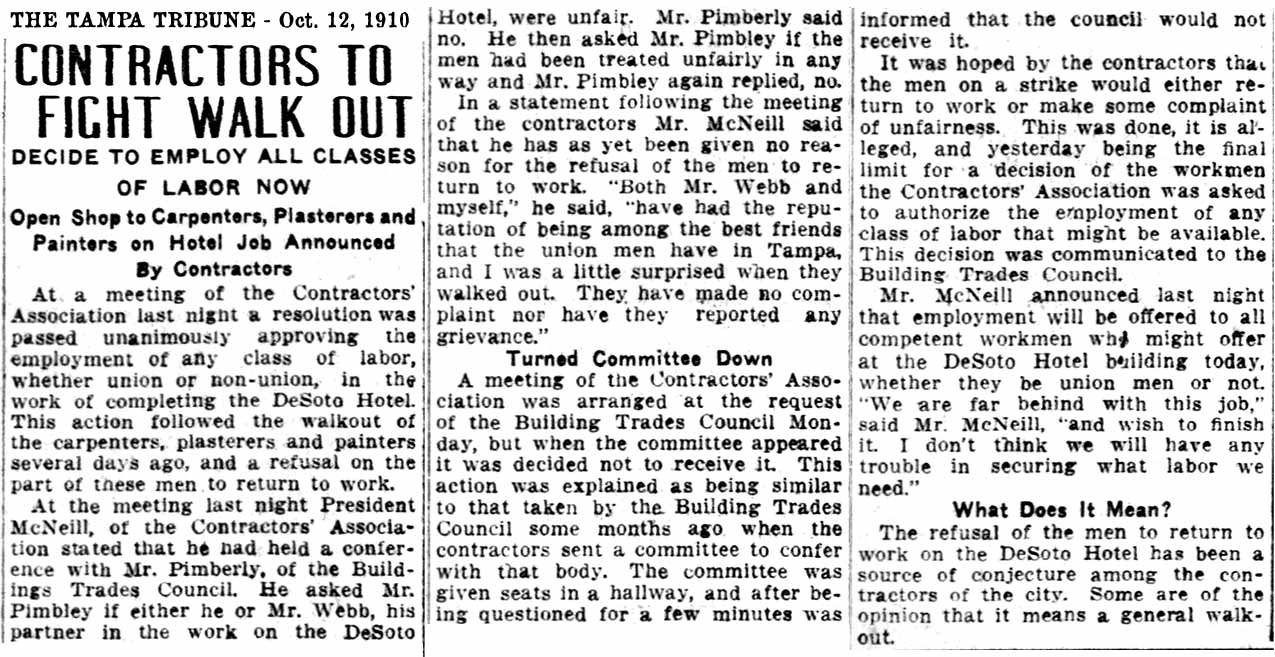
|
| |
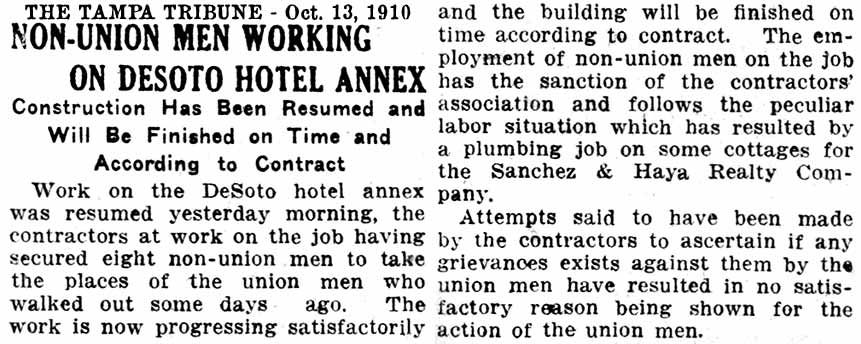
Work on the DeSoto resumed when eight non-union men were hired to replace the striking men. The work was being done with the approval of the contractor's association after a dispute by plumbers at the Sanchez & Haya realty company job site caused the strike. Attempts had been made to find out if any grievances existed against the the contractors at the DeSoto but no satisfactory reason had yet been given. |
| |
| |
|
The Tribune voiced its opinion on the strike by taking sides with the DeSoto contractors, stating that it was unfair for workers there to walk out when there were no issues with their work there. It further stated that the labor unions could not take a stance claiming the adoption of the "open shop" policy at the DeSoto site was a blow to unionism by the contractors, as every observance of the union rules were being followed in the treatment of their workers. It ends with a strong statement, "Let this be fully understood...by all parties concerned before the present trend of public sentiment in Tampa proceeds further in the development of a course of action which has been forced upon it by the unreasonable and town-wrecking attitude of the union men themselves." 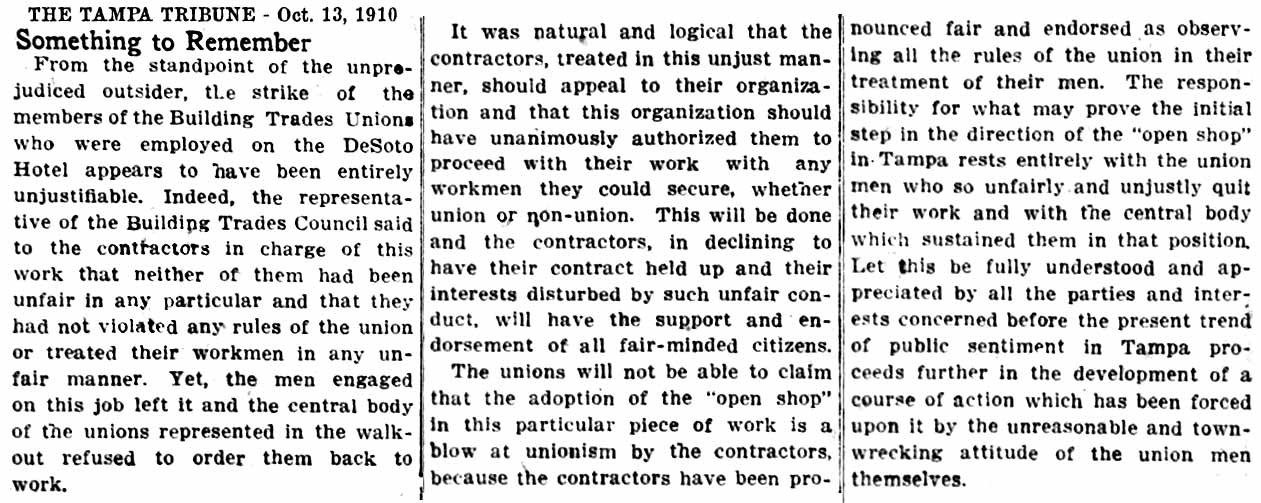
|
| |
|
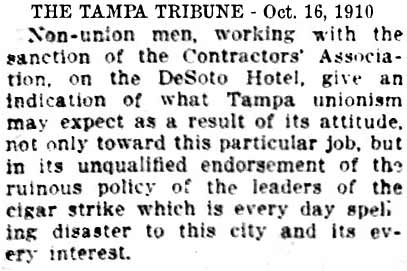
|
The Tribune warned the unions that the non-union men working with the contractors on the DeSoto Hotel should be a lesson to the unions as to what they can expect with their "unqualified endorsement of the ruinous policy of the leaders of the cigar strike which every day spells disaster to this city and its every interest." In early December, 1910, fine tile had arrived from Mobile and was being laid in the rooms and corridors of the new wing of the DeSoto. "These tiles are exactly like those in use for centuries in Spain and Cuba, and the big factory in Mobile is the only plant in America except a small attempt in Ybor City by some non-English speaking Cubans." The article goes on to describe the tiles, the company who makes them, and the durability and better economy of tile floors for the long run. |
|
The 25 day delay of work on the DeSoto caused 10 days of no work being done and the recent rains have caused damage because of it, due to the walls still being open to the elements.
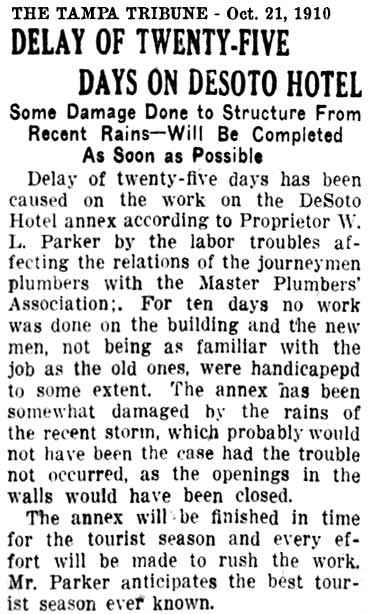
|
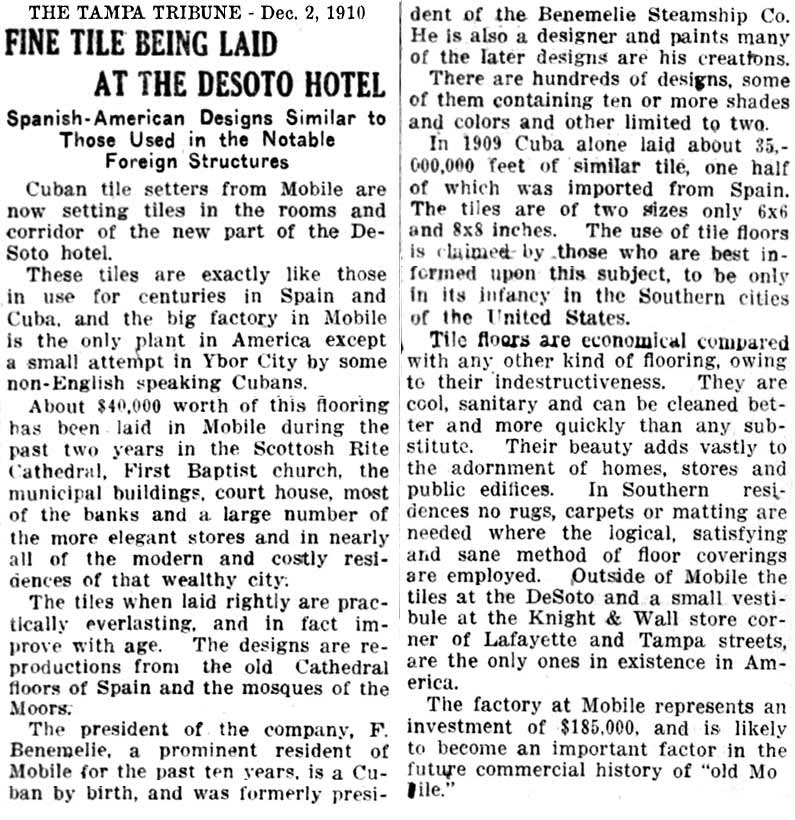
|
| The new south wing was expected to be finished by mid-December, 1910 adding 26 more rooms and many other conveniences. Parker next expected to extend the Morgan Street side of the hotel by finally removing the old wood frame section which was the original structure that was moved and rotated from its original location at Marion and Zack St.
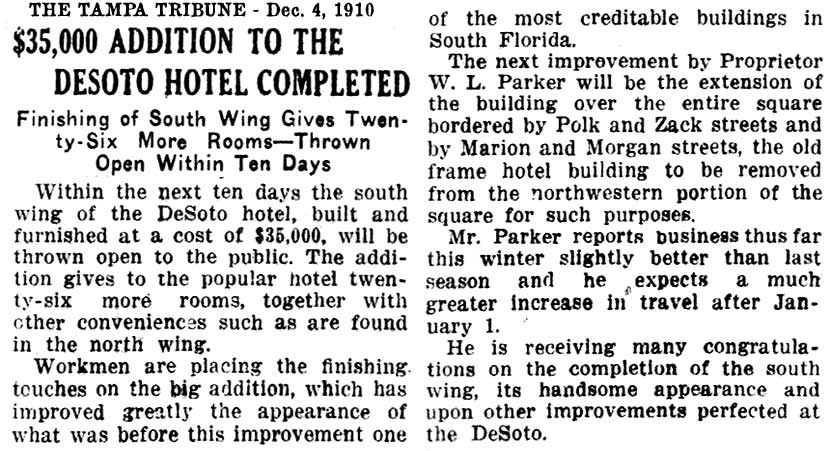 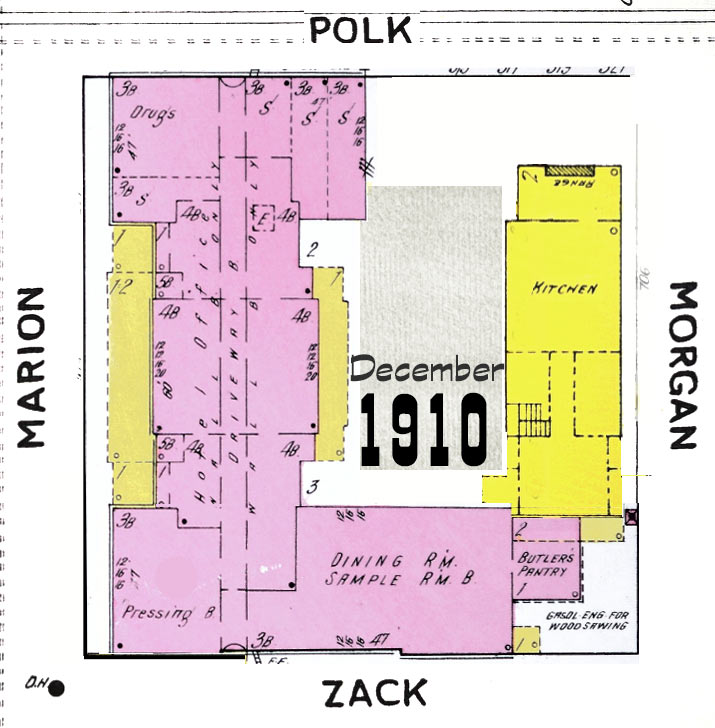
|
|
Tampa
historian
Karl Grismer
on the
DeSoto:
| Prior to its erection [the Hillsboro Hotel,] the principal hotel open the year round was the DeSoto, built in 1892-93 by Capt. R. F. Webb and Walter Parker. Designed by J. A. Wood, the architect who had planned the Tampa Bay Hotel and the county courthouse, it was topped by Moorish 'domes and minarets which Wood favored and was adorned by rambling wooden porches and stately marble columns in the lobby. However, the De Soto lacked modem bathroom facilities and the Hillsboro became Tampa's leading hotel, immediately upon completion. Later the De Soto was modernized and enlarged. |
Clearly, Grismer is mistaken on a few key facts:
-
The first DeSoto was built by James Henry Thomas who came to Tampa from Ohio in 1893, so it couldn't have been built in 1892. It was built 1893-94
-
Robert F. Webb bought the first DeSoto from Thomas and turned it over to his son-in-law, Walter L. Parker. Upon Parker bringing in a number of associates as co-owners, they were the builders of the NEW DeSoto Hotel
-
J. A. Wood designed the second Desoto Hotel. To think that everything J. A. Wood designed had Moorish domes and minarets is a bit presumptuous on Grismer's part. As can be seen, both the original and the new hotel designs were far from Moorish, and the feature bearing the most resemblance to the Tampa Bay Hotel is the Desoto's front porch, verandah and their decorative trimmings.
|
|
|
Construction
nearly
completed on
DeSoto Hotel
#2 -- the
"New DeSoto." |
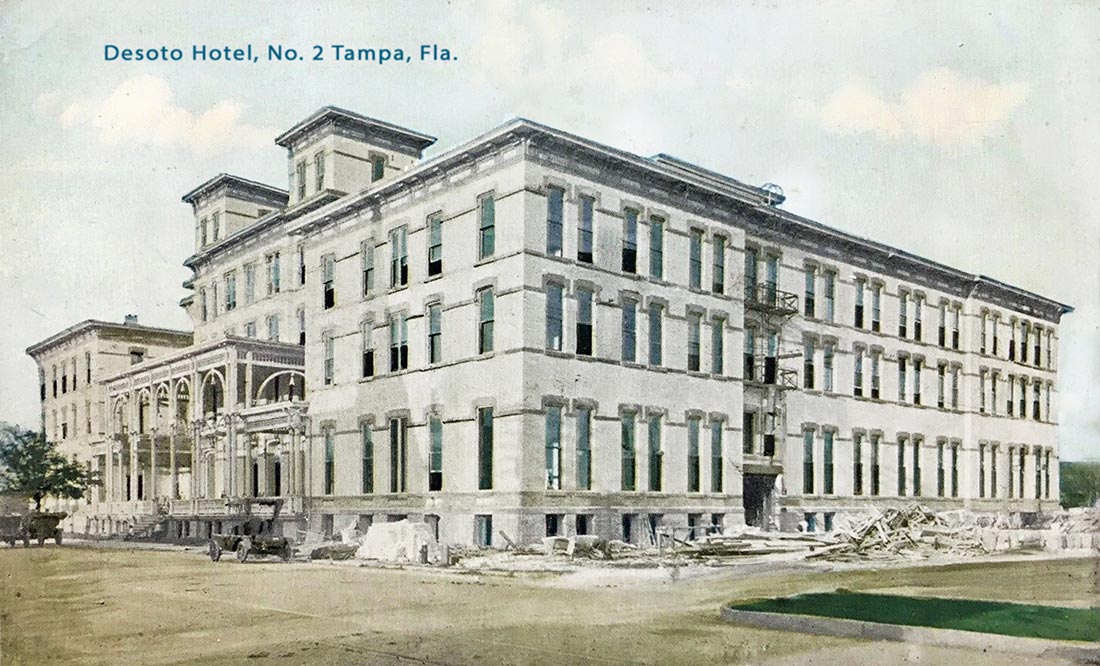
EBAY
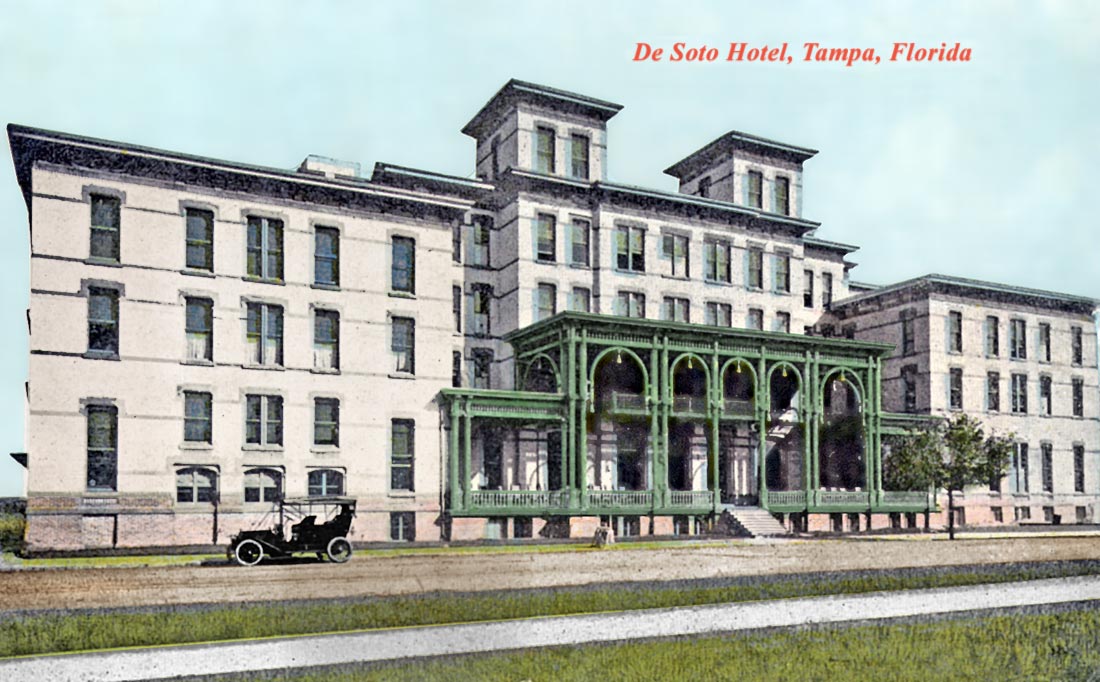 |
|
From the
Hampton Dunn
and Florida
Collection
of Postcards
at the USF
Library
digital
collections
website. |
|
1921 -
Company B of
the
Hillsborough
Co. Home
Guards |
 |
Burgert
Brothers
Cirkut
Camera
Panoramic
image from
the
collection
of the Tampa
Hillsborough
Co. Public
Library
website.
These
negatives
are named
after the
special
Cirkut
camera that
could rotate
up to 360°
to produce
sweeping
panoramic
views.
The
negatives
were
produced on
nitrate film
and had
deteriorated
severely
over the
years. The
library has
created new
negatives
and prints
from these
old
negatives.
Read about
the Cirkut
Camera at
the TampaPix
Burgert
Bros.
feature. |
|
|
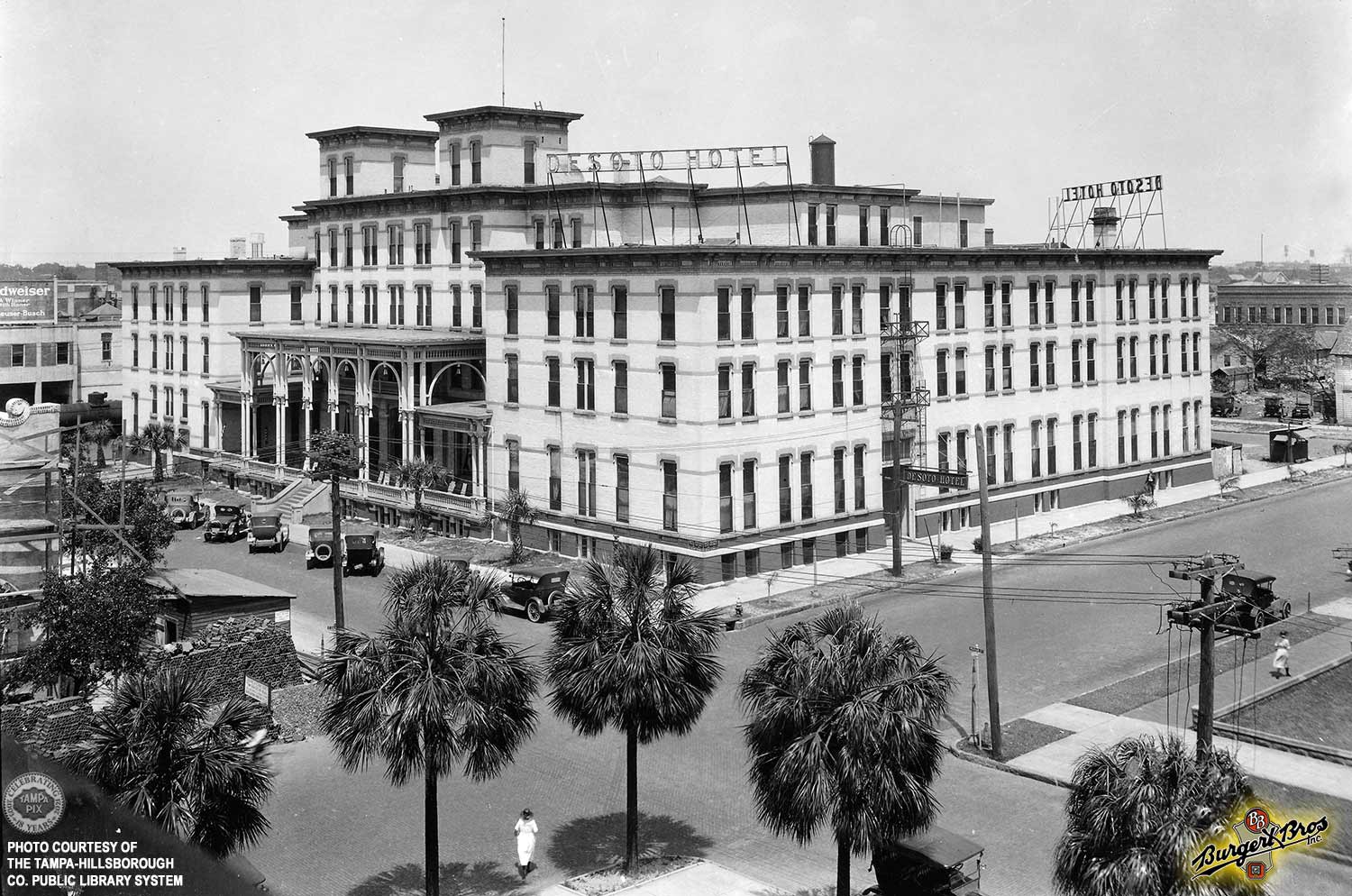
|
|
1922 -
Burgert
Bros., Tampa
Hillsborough
Co. Public
Library
digital
collection. |
|
1936 - Main
entrance on
Marion St. |
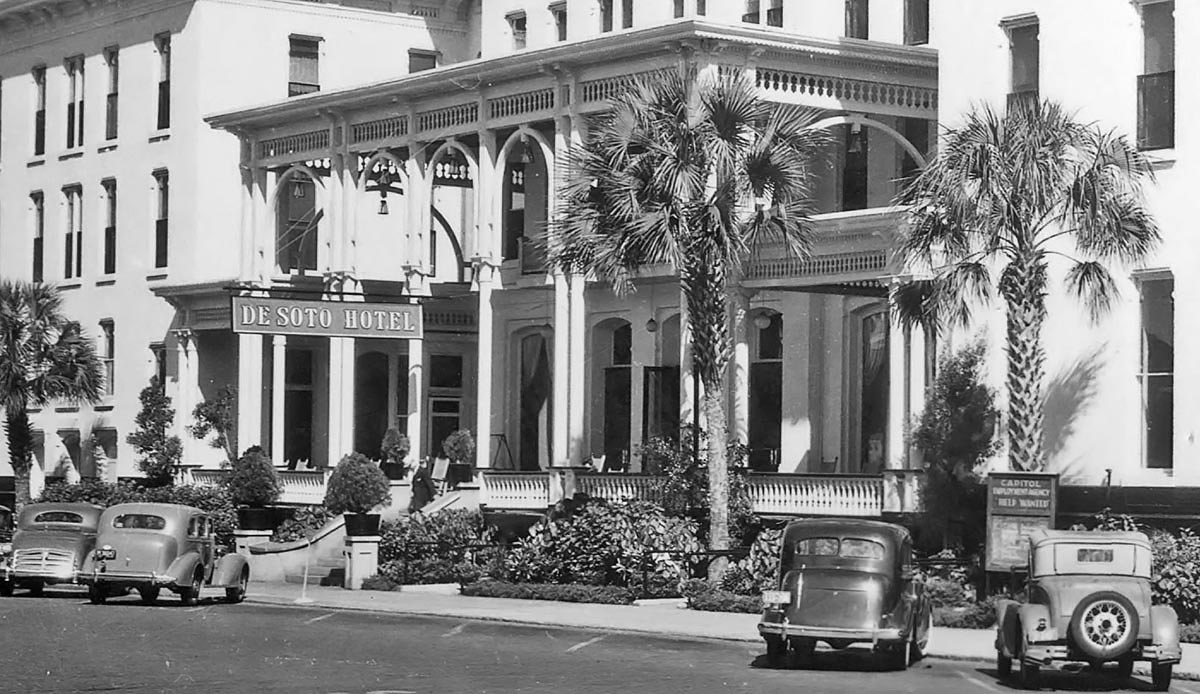 |
|
Photo by
Robertson &
Fresh from
the USF
digital
collections
1936 - South
entrance,
Zack Street
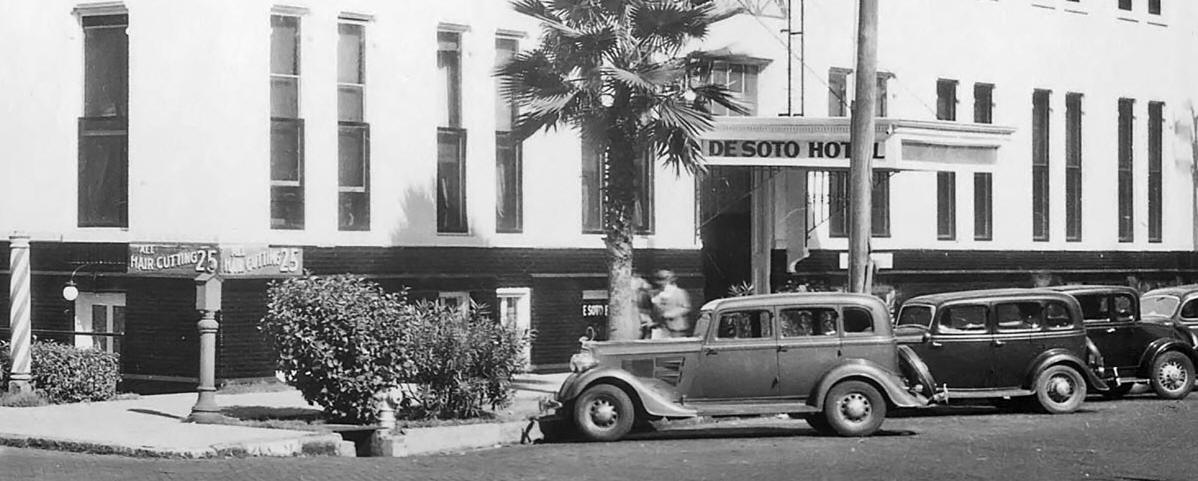 |
|
Photo by
Robertson &
Fresh from
the USF
digital
collections
1936 -
Rooftop sign
Place your
cursor on it
to switch it
on.
 |
|
Photo by
Robertson &
Fresh from
the USF
digital
collections
1930s - The
east side of
the DeSoto
along Morgan
St.
Not as ritzy
as the front
facade.
Notice the
old wood
frame annex
no longer
existed as
it was only
temporary
while the
new
structure
was still
under
construction.
Also, the
"courtyard"
described in
the early
news
articles
apparently
wasn't
anything for
guests to
enjoy.
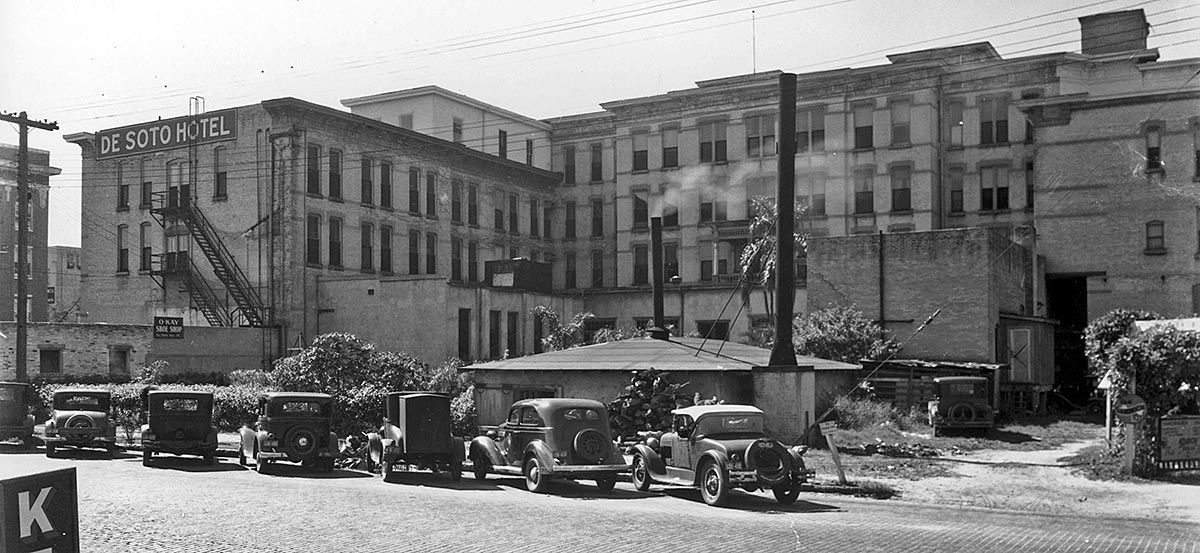
|
|
|
|
|
Nov. 4, 1946
- The Indian
Room Bar at
the DeSoto
Hotel |
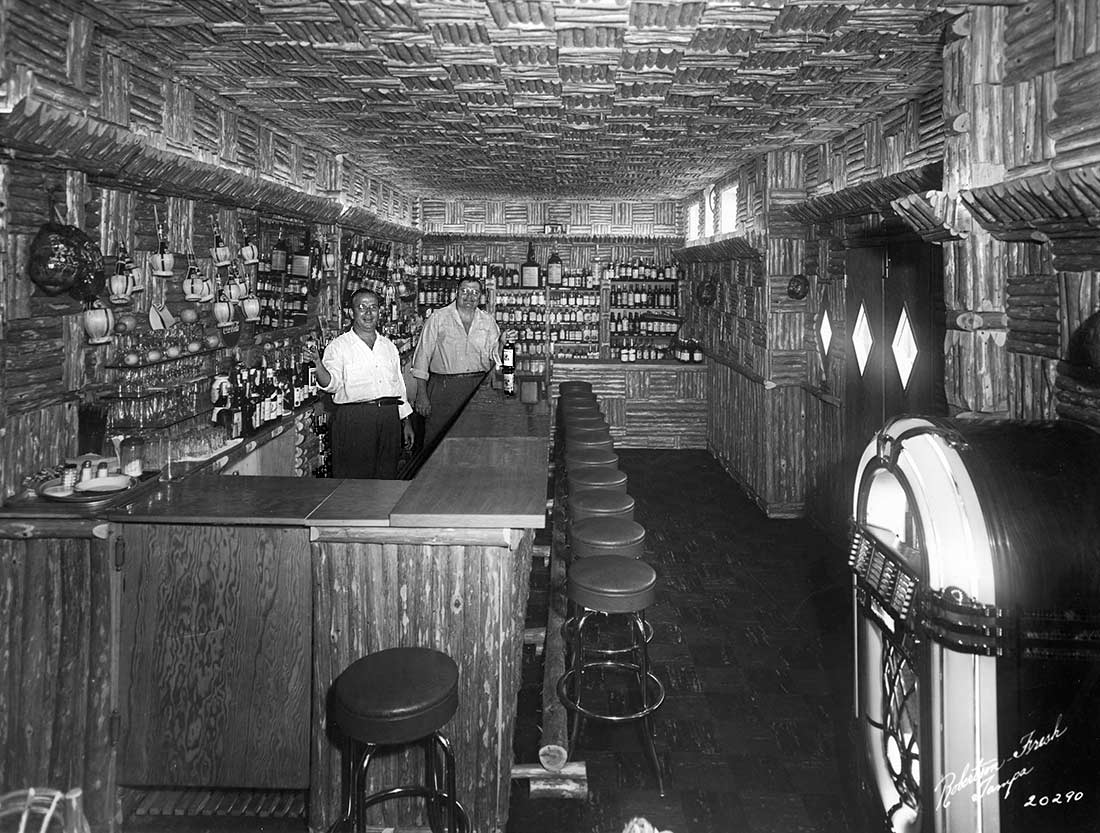 |
|
Photo by
Robertson &
Fresh from
the USF
digital
collections
1950 -
Entrance to
Indian Room
Bar & Grill
at 721
Marion
Street |
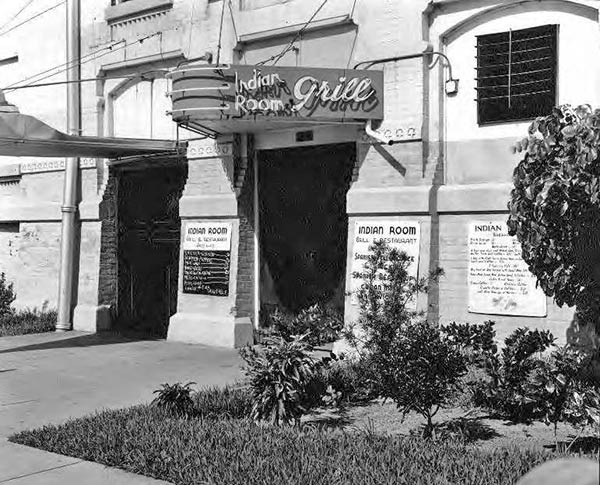
Burgert
Bros., Tampa
Hillsborough
Co. Public
Library
digital
collection.
Nov. 4, 1946
- Lobby at
the DeSoto
Hotel |
 |
|
Photo by
Robertson &
Fresh from
the USF
digital
collections |
|
Nov. 4, 1946
- A view of
the DeSoto
from Marion
& Zack St.
looking
northeast. |
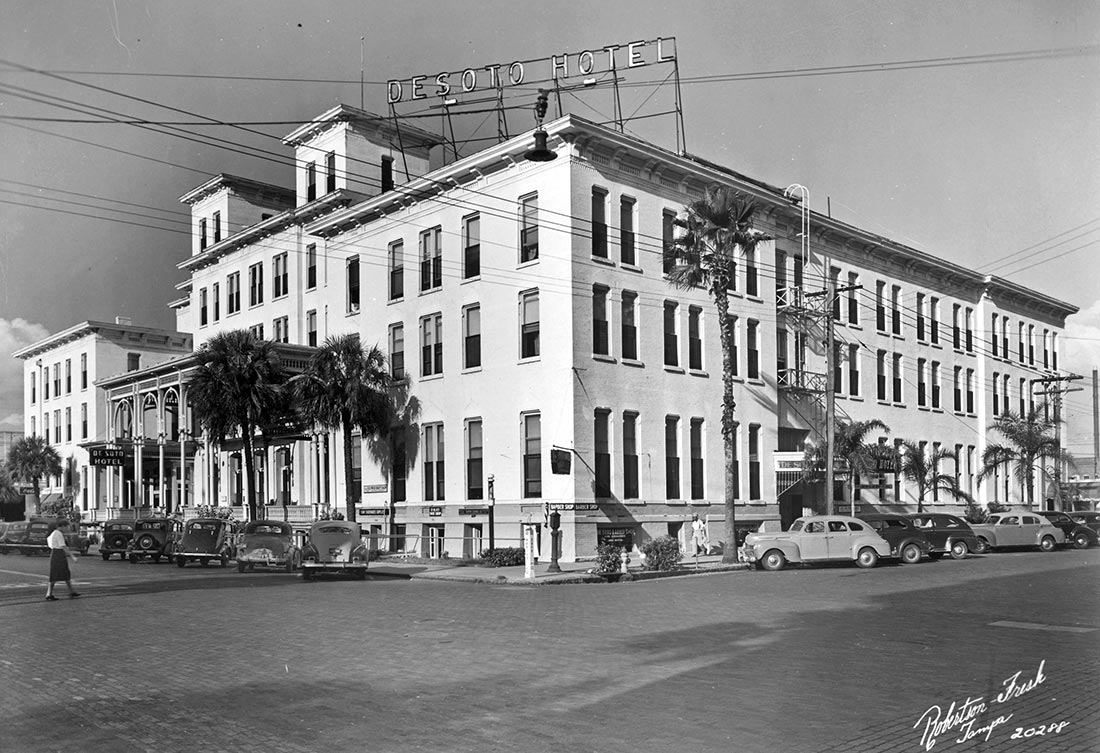 |
|
Photo by
Robertson &
Fresh from
the USF
digital
collections |
|
June 3, 1949
- Elevated
view of the
DeSoto Hotel
from Marion
& Zack St. |
Sep. 23,
1955 -
Demolition
of the 45
year old
DeSoto Hotel
#2. |
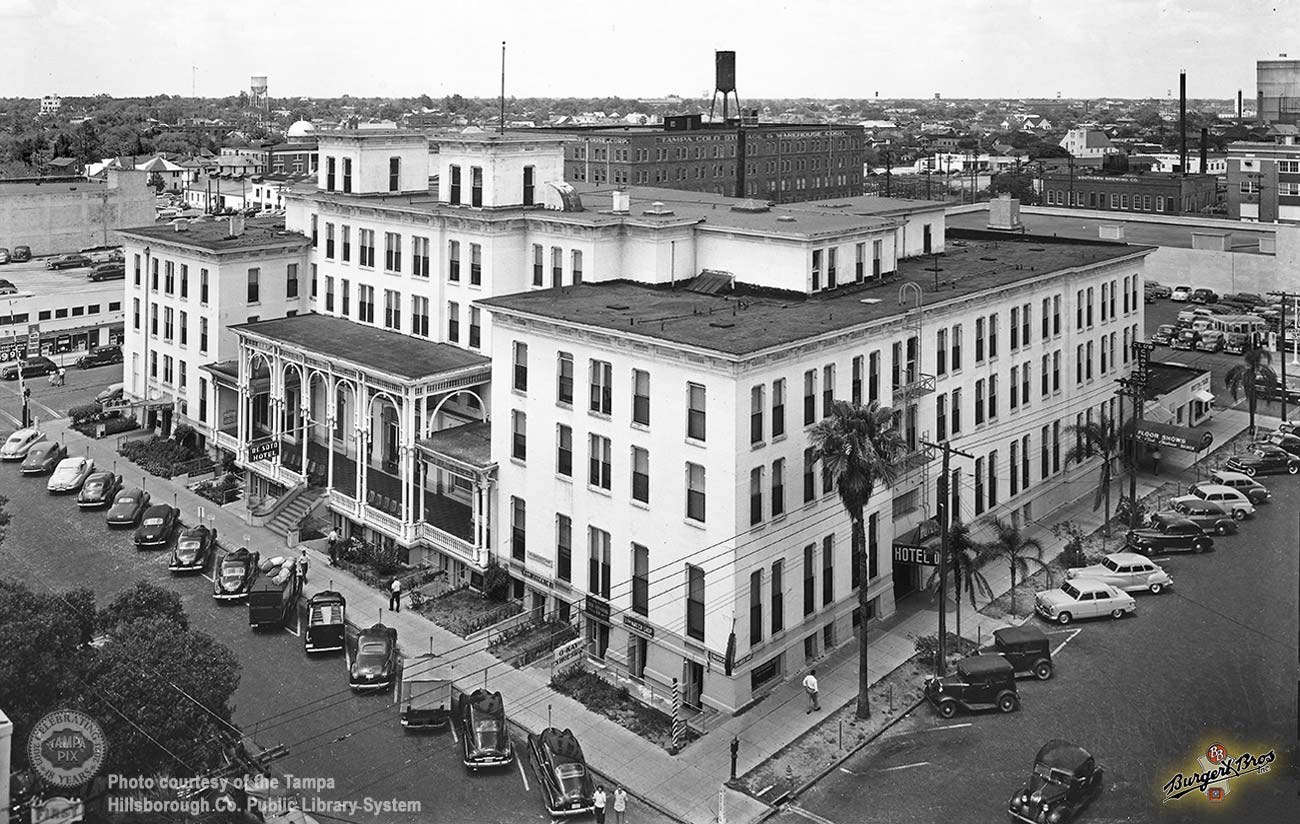
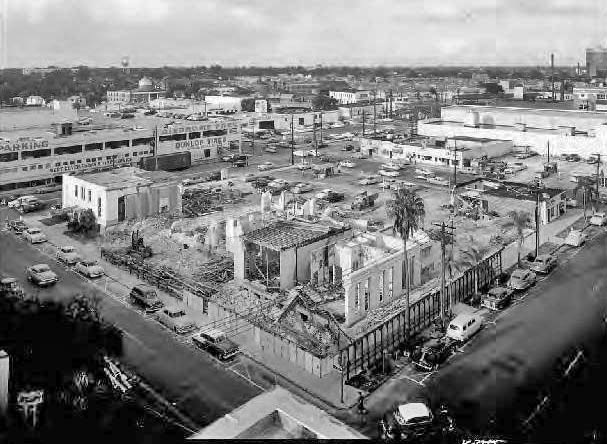 |
|
Burgert
Bros., Tampa
Hillsborough
Co. Public
Library
digital
collection. |
Burgert
Bros., Tampa
Hillsborough
Co. Public
Library
digital
collection. |
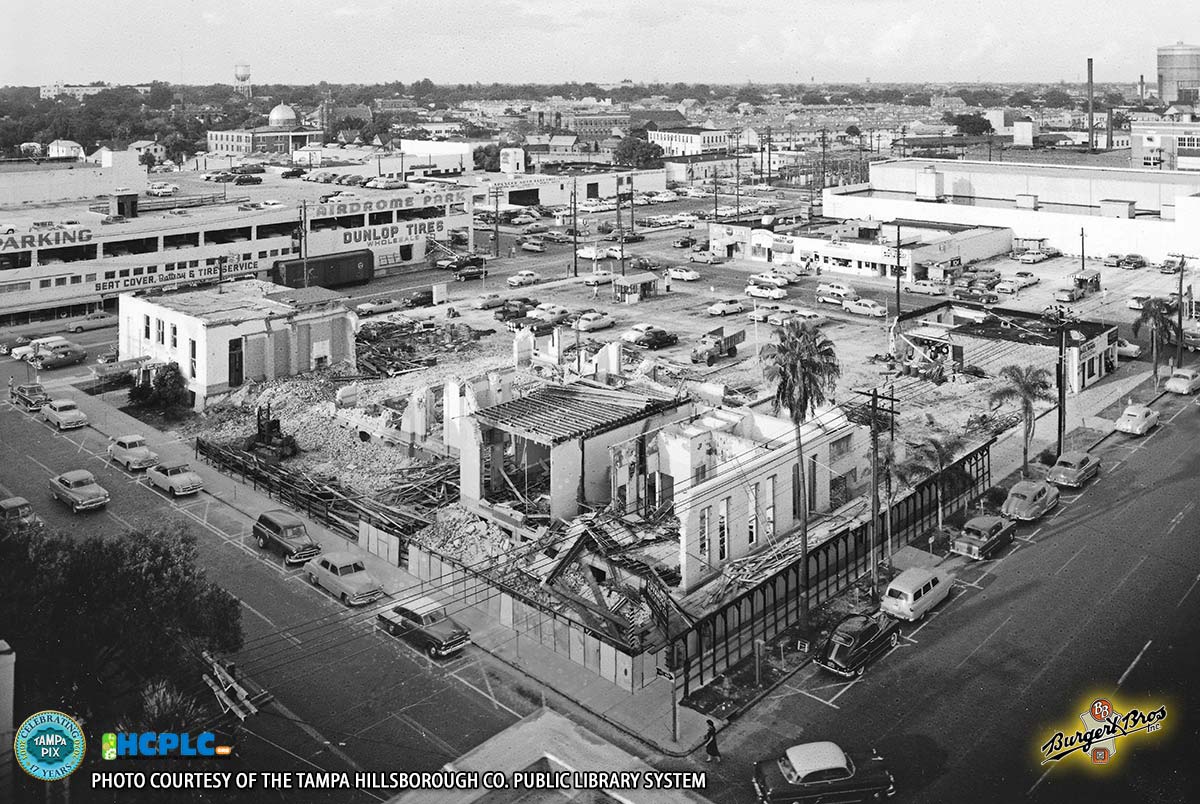 |
|
W. D. LEWIS
AND ANNIE
MOVE TO
KENTUCKY
|
|
In early
Feb. 1897,
the local
Tampa news
announced
that
W. D. Lewis had
formed a
partnership
with a Mr.
Keyes in
Louisville as
a
merchandise
brokerage
firm in the
name of
Lewis &
Keyes,** which
would start
business
immediately. |
|
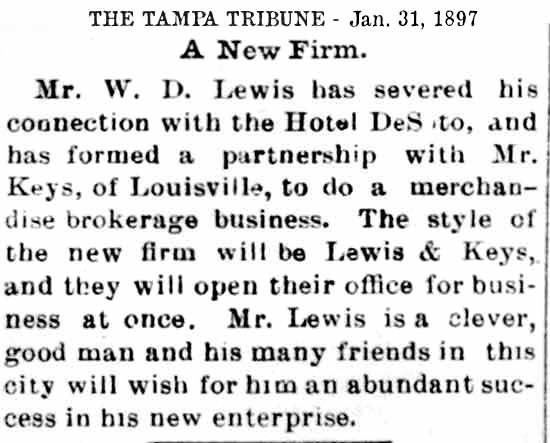
**Nothing of
the Lewis &
Keyes
partnership
could be
found.
Perhaps the
plan
fizzled.
Mr. Keyes
may have
been the
president of
the Keyes-Gallrein
Music Co. in
Louisville,
who
advertised
as "We are
the Largest
Music Supply
House in the
South.
Manufacturers,
Publishers
and General
Dealers."
This
Louisville
partnership
between John
W. Keyes
formerly of
Nashville
and Herman
Gallrein of
Louisville
appears to
be
short-lived;
it
advertised
only from
July to
early Sept.
of 1897 in a
Hartford KY
newspaper.
In mid-Dec.
1897, Mr.
Keyes sold
his interest
in the
company and
on Jan. 1,
1898, took
charge of
the
manufacturing
and
wholesale
business of
Wulschner
Music House.
Last mention
of Lewis in
Tampa papers.
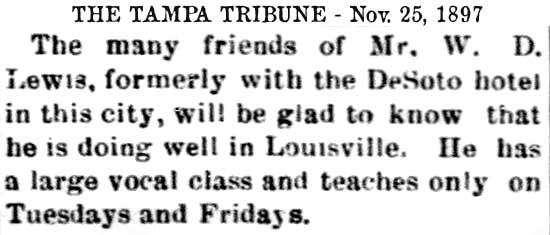
|
Wilmer and
Annie Lewis
moved to
Louisville,
KY, to start
a new life.
Below:
In August
1897, W. D.
Lewis
visited in
Lexington
for several
weeks, where
the local
papers took
note of his
presence by
writing,
"The
congregation
at the
Cathedral
very much
enjoyed
hearing him
sing the
Offertory at
the morning
service
yesterday.
He is an
accomplished
musician and
member of
the choir of
St Andrew's
Church in
Tampa.
Mr. Lewis
has a bass
voice of
unusual
range and
beautiful
quality...
-WD-LEWIS-of-Tampa-in-town-for-buisness,-fine-voice.jpg)
BELOW:
Feb. 1899 -
The Alumni
Club of the
local High
School
sponsored
the first
afternoon
concert of a
series for
1899; this
one was held
at the
girl's high
school
building.
The program
consisted of
vocal and
instrumental
solos, and a
"charmingly
rendered
selection by
a quartet
which
included
W. D. Lewis. |
Below:
Sep. 21,
1897 - W. D.
Lewis got
fed up with so many
people in
the area
thinking
Florida was a
Yellow Fever
risk because
they thought
it was close
to New
Orleans, which was
having an
outbreak. He
set the
record
straight
giving the
distance of
1,000 miles
and assured
them Florida
was as free
from YF as
Kentucky was.
(Back then, YF was
attributed
directly to
filthy
conditions,
and to
falsely
believe the
fever was in
Tampa was to
say Tampa
was filthy. Tampa
did in fact
have a
history of
YF
outbreaks.)
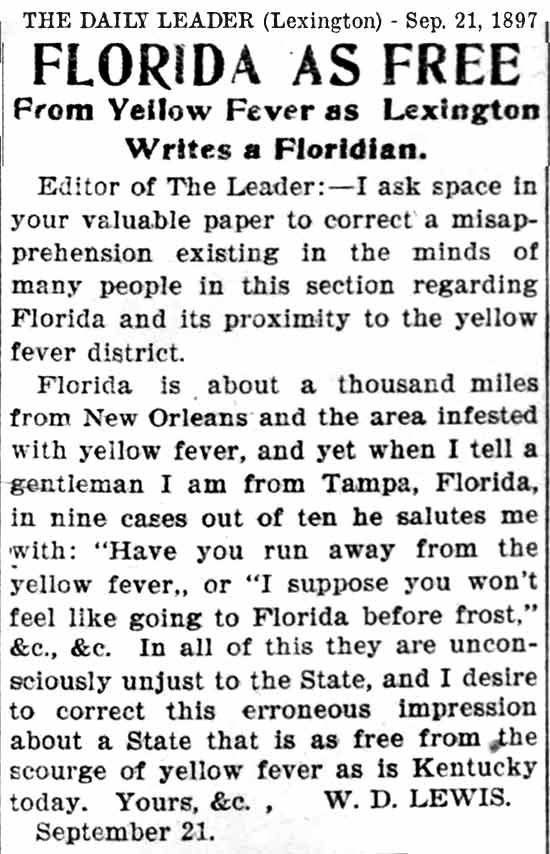 |
|
|
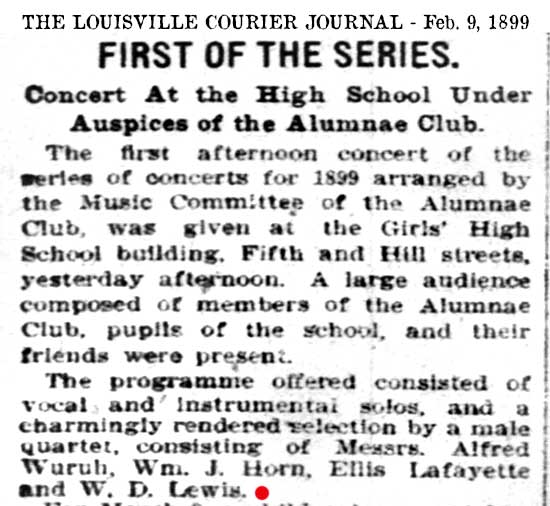
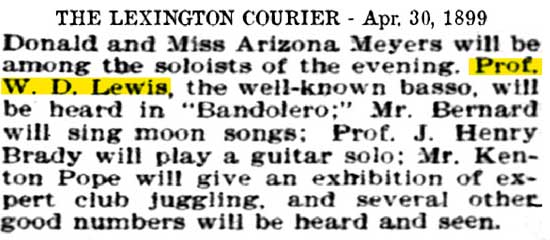 |
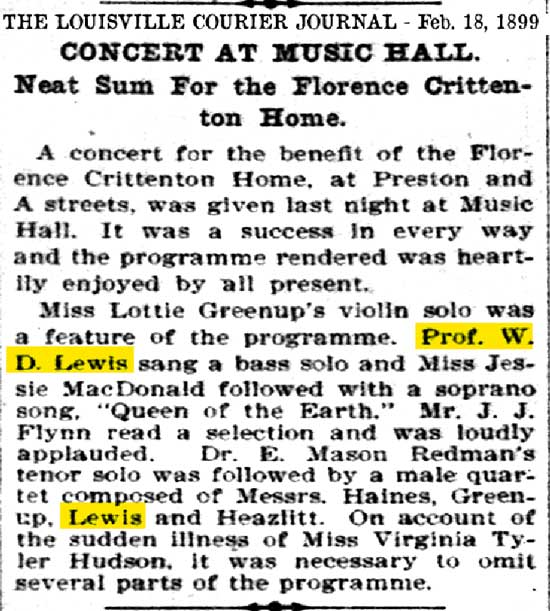
|
|
BELOW:
In April of
1900, Prof.
Lewis
visited his
former
pupil,
George W.
Llewellyn,
in Dayton
Ohio.
During that
short visit
he sang at
the Grace
Church...
"characterized
by artistic
finish in
all
respects.
His voice is
a powerful
sonorous
basso
profundo,
and is under
perfect
control."
While in
Dayton, he
let it be
known that
he intended
to relocate
there.
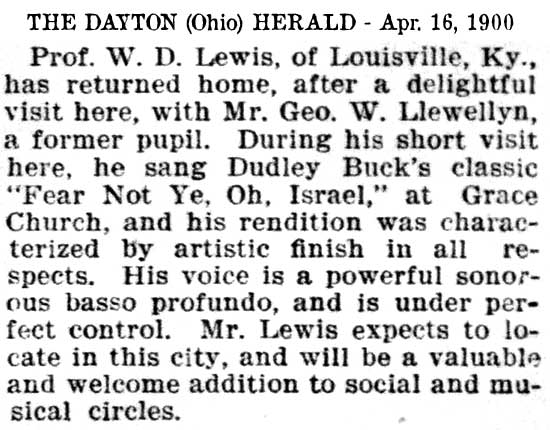 |
|
WILMER &
ANNIE LEWIS
MOVE TO
DAYTON, OHIO
By summer of
1900, W. D.
Lewis and
Annie
had moved to
Dayton,
Ohio, where
W. D. Lewis
led the
Epworth
League
Choir,
performing
at the Grace M.E. church.
On September
24, 1900
Prof. Lewis
opened the
Dayton
Conservatory,
School of
Music, where
he was
Director and
vocal
instructor, H.H. Kaeuper
taught piano
and music
theory,
Charles
Holstein
taught
violin, and
Anna Loy May
taught
elocution.
The school
was located
in the
Cooper
Seminary
Annex at
First and
Perry
Streets,
which is
where W. D.
Lewis
had his
studios and
residence.
The 1900
Census of
W. D. Lewis and
Annie Lewis
in Dayton
reveals that
Annie had
given birth
to a child
who had
passed away
by the time
of the
census in
June.
W. D. Lewis was a
vocal
teacher and
renting
their
residence.
W.
D. Lewis
also taught
vocal music
at
Wittenberg
College at
Springfield,
Ohio.
W. D. Lewis and
Annie
were
members of
the
Episcopal
Church, and
attended the
Christ
Church of
that faith
in Dayton.
W. D. Lewis
continued as a
concert
soloist and
teacher for
many years
in Dayton.
His
reputation
as a
thorough,
conscientious
teacher of
voice
culture was
well
established
and
recognized,
and a great
many of his
pupils gained the
top of the
ladder in
their
profession.
1900 Census,
Dayton, Ohio |
|
 |
|
This census
is
consistent
with birth
places but
their birth
years and
ages are
about 10
years off;
both would
have been in
their early
50s in 1900.
The yellow
highlight
indicates
Annie was
the mother
of one
child, none
living at
this time.
She could
have had a
child any
time after
the 1880
census.
It is
unusual for
a wife of a
"Society
newsmaker"
such as
W. D. Lewis to
not have
anything
published
about her in
local
papers.
(The only
mention of
her
consisting
of more than
a short
sentence was
that about
her death.)
The green
highlighting
shows W. D.
Lewis
had been
unemployed
for ZERO
months and
was renting
his home. |
|
|
|
W. D. Lewis led
the Epworth
League choir
at the Grace M.E. church. |
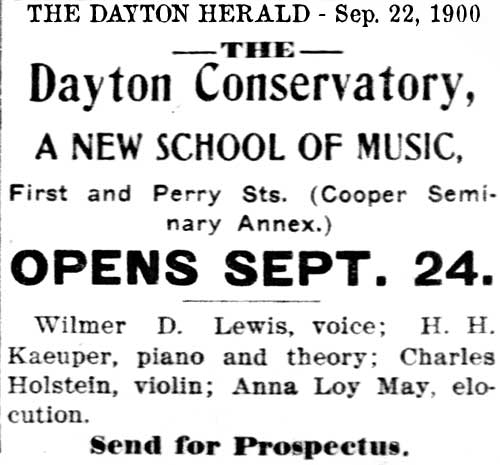
At Right:
Feb. 19,
1901 - W. D.
Lewis led a
double
quartet
performance
at the
Dayton View
Assembly and
performed a
solo "at the
Bottom of
the Deep
Blue Sea" by
Petrie. |
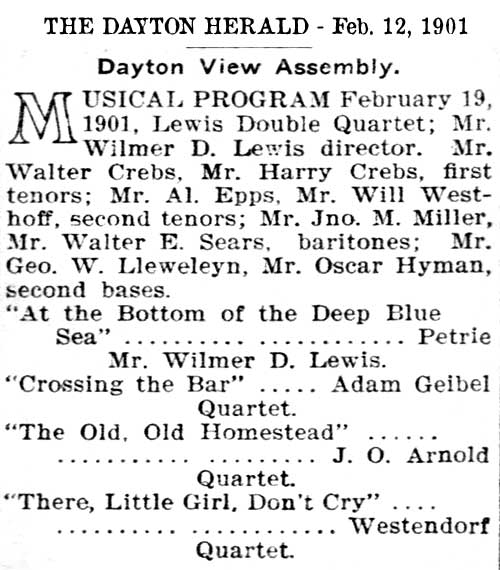 |
|
 |
|
At Right:
In late Sep.
1900,
W. D. Lewis and
three others
opened "THE
DAYTON
CONSERVATORY" a new
school of
music in
Dayton at
the Cooper
Seminary
Annex, with
W. D. Lewis
teaching
voice, and
the others
teaching
piano,
theory,
violin and
elocution.
|
|
|
The Dayton
Conservatory
of Music
took charge
of planning and directing this
early May, 1901 event, the
last in the
series of
"Popular
Saturday
Nights"
concerts,
where the
faculty of
the school
performed. |
THE MUSICIAN, Aug. 1901 (A monthly national music magazine) - Published in Philadelphia by the Hatch music company, Jan. 1896-Nov. 1903; |
|
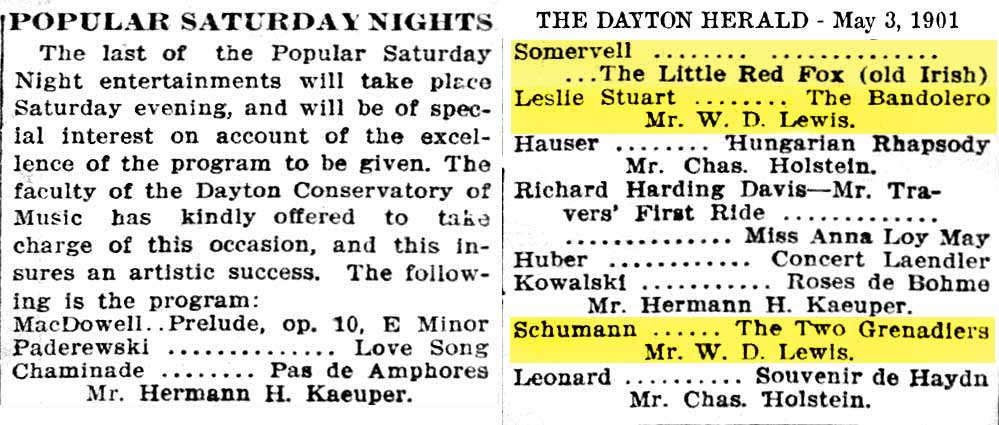
|
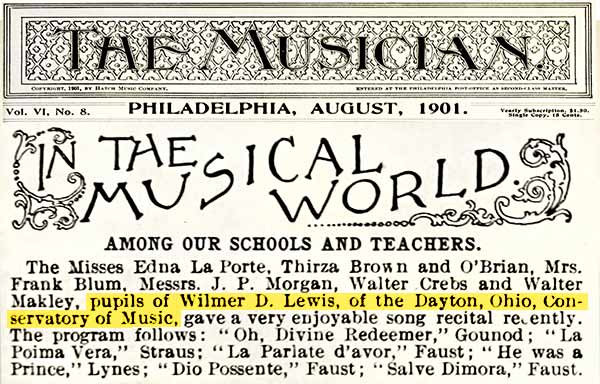
|
| |
From Internet Archive |
|
|
DEATH OF
WILMER'S
WIFE, ANNIE
I. LEWIS
(This
section is
incomplete.)
On Oct. 3,
1908, Annie
I.
(McIlvaine)
Lewis died
at St.
Elizabeth
hospital in
Dayton.
Her funeral
was held on
Monday
afternoon on
Oct. 5 from
the chapel
of Woodland
Cemetery
where she
was buried.
Her funeral
announcement
stated that
she had been
ill and
suffering
from
paralysis
for six
years, but
her death
record shows
her death
was caused
by heart
trouble and
dropsy. She
was sixty
years old.
| Dropsy: An old term for the swelling of soft tissues due to the accumulation of excess water. Today one would be more descriptive and specify the cause. Thus, the person might have edema due to congestive heart failure. Edema is often more prominent in the lower legs and feet toward the end of the day as a result of pooling of fluid from the upright position usually maintained during the day. Upon awakening from sleeping, people can have swelling around the eyes referred to as periorbital edema. The Middle English dropesie came through the Old French hydropsie from the Greek hydrops which in turn came from the Greek "hydro" meaning water. |
By Oct. 1909
W. D. Lewis
resumed his
vocal
classes at
his studios
at the
Dayton
Conservatory.
He had at
least forty
pupils
singing in
choirs in
and around
Dayton, and
ten "making
good" with
various
traveling
companies on
the road.
In addition
to this, he
had five
former
pupils who
were
successful
vocal
teachers,
and
twenty-five
more singing
in theaters
and holding
various
positions
there.
His ads in
the Dayton
Herald
carried a
three-quarter
bust photo
of him, and
stated
"Voice
Culture,
Established
11 years in
Dayton.
Specialist
in Tone
Placing,
Enunciation,
Voice
Building.
I have
absolutely
made voices
"out of
whole
cloth," and
am able and
willing to
convince you
if you
will call on
me."
The 1910
Census of
Dayton
showed
W. D. Lewis
living alone
at 276 1st
Street as a
music
teacher.
It is at
this time
that W. D.
Lewis
began to
sell
insurance,
taking a job
as a general
agent of the
American
Casualty and
Union
Casualty
companies
with offices
in the Reibold
building.
W. D. LEWIS
FROM
NEWSPAPER
ARTICLES
In mid-April
of 1911,
W. D. Lewis was
engaged to
be married
to Miss
Sarah Reel,
Miss Reel
was a
teacher at
the Franklin
School, and
a daughter
of Mr. &
Mrs. John H.
Reel. At
this time
the wedding
date had not
been set,
but it was
planned for
early that
summer.
In July that
year, W. D.
Lewis
moved his
music studio
from the
Dayton
Conservatory
to 498
Ludlow
Street
Arcade. In
1912 his
insurance
office was
in the Reibold Bldg
at rm. 707-8
where he
sold fire
insurance.
He continued
teach voice
culture at
rm 283 in
the ARcade,
and in his
office at
the Reibold
blidng. In
May 1912,
W. D. Lewis
incorporated
as "The
Wilmer D.
Lewis Co."
Dayton,
along with
F. C. Reel,
J. P.
Morgan, L.R.
Lewis, and
S.T.
Maloney,
$10,000
investment.
By the end
of 1913,
Wilmer D.
Lewis
Insurance
was selling
Fire, Auto
Liability,
Personal
Health,
Property
Damage,
Elevator
Liability,
Accident,
Auto
Collision,
Plate Glass,
and Auto
Fire
insurance,
at his
offices at
707-708
Reibold
Building.
In 1915,
Wilmer D.
Lewis & Co.
moved to 907
in the
Schwind
Building,
selling
Aetna Live
and
Accident,
American
Casualty Co,
Union
Casualty Co,
and
Equitable
Secrity Co.
policies.
There was a
lot of
competition
in Dayton in
the realm of
music
instruction,
and this
would be the
last year
W. D. Lewis
taught
vocal
instruction,
which he was
doing at his
residence at
125 Lehman
St. and his
office at
907 in the Schwind
bldg.
By Jan.
1916, Wilmer
D. Lewis &
Co. was back
in the
Reibold
Bldge, and
#778.
He
advertised
"Insure your
automobile
in the Aetna
Accident &
Liability
Co.
Aetna
service is
always
perfect and
prompt.
He added in
fine print
"I would not
drive an
automobile
on Main St.
from the
Monument to
Sixth St.
without
LIABILITY."
On Friday,
Nov. 9,
1917, Prof.
Lewis had an
attack of
apoplexy
around 10:30
a.m. while
near the
Young
Women's
League
building in
Dayton.
He was
rushed into
the building
in serious
condition
and soon
attended to
by Drs. K.
M. Ellsworth
and A. B.
Brower.
Wilmer was
then taken
by ambulance
to his home
at 125
Lehman St.
where at 10
p.m. he
lapsed into
unconsciousness
until his
death at
12:15 a.m.
Sunday, Nov
11.
1917-11-09
DAYTON DAILY
NEWS
Wilmer Lewis
Seriously
Ill
1917-11-09
DAYTON
HERALD
Insurance
man removed
to home.
1917-11-10
DAYTON DAILY
NEWS -
Lewis
unconscious
due to
apoplexy
(stroke).
1917-11-11-DAYTON-DAILY-NEWS
Prof. Wilmer
Lewis Called
by Death
1917-11-12-DAYTON-DAILY-NEWS-
Private
burial
service for
W. D. Lewis
"Mr. Lewis
was a
resident of
Dayton
during the
past 18
years,
having come
here from
Louisville,
Ky and
during a
portion of
that time he
was a vocal
instructor,
maintaining
a studio in
the Cooper
seminary
Annex.
He also
appeared
often in
public as a
well-known
singer. He
was
well-known
in insurance
circles
during the
last 10
years, and
for the past
two years he
had ceased
vocal
instruction
while he
represented
the Aetna
Insurance
Co. in this
city.
His wife and
one six
month old
infant son
survive him.
Funeral
services for
Prof. Wilmer
D. Lewis,
67,** former
prominent
teacher of
vocal music
in Dayton
and at
Wittenberg
College at
Springfield,
will be held
Tuesday
afternoon at
1:30 p.m. at
the
residence ,
125 Lehman
St.
Rev. Arthur
Dumper of
Christ
Episcopal
church will
officiate.
Burial will
be made in
Woodland
cemetery and
will be
private.
Pall-bearers
were Messrs.
Howard
Williamson,
Charles
Harwood,
Frederick
Bender, Hale
Pardonner,
Arnold
Atlhoff, and
Frank
Walker.
Elks lodge
of sorrow
was held
Monday
evening at
7:30.
**Prof.
Lewis was
actually
closer to 70
years old,
as three of
his earliest
censuses
indicate he
was born
1847 to
1849.
In 1920,
Sarah (Reel)
Lewis lived
at 236 St.
in Dayton
with her 2
yr. 6 mos.
old son
Lewis Lewis
and her
62-yr-old
widowed
mother
Amelia Reel.
Sarah would
turn 41 that
year, making
her about 25
to 29 years
younger than
Wilmer.
Sarah was
still a
school
teacher at a
public
school.
On August
25, 1940,
23-year-old
Lewis Wilmer
Lewis of
Dayton, son
of Wilmer D.
Lewis and
Sarah Reel,
married
24-year old
Marthia
McCoy of
Springfield,
daughter of
Hugh S.
McCoy and
Loa Evans,
in
Springfield,
Clark Co,
Ohio.
Both the
bride and
the groom
were
teachers.
(This
information
is public
record.)
In 1946,
their son
Geoffrey
Hugh Lewis
was born in
Springfield,
Oh.
Geoffrey
entered the
U.S. Navy
and was
stationed in
San Diego,
CA when he
married in
Clark Co.,
Ohio on Jun.
13, 1967 to
Nancy Eileen
Landis of
Dayton,
Ohio.
Lewis Wilmer
Lewis died
Mar. 19,
1966 in
Springfield,
Oh. at age
48 and is
buried at S.
Solon
Cemetery in
Madison Co.,
Ohio.
Here we see
that
Victor's
father,
Robert H., was
one of many
brothers of
Mary McIlvaine
(Simmons),
William P.
Haisley's
mother-in-law.
Several
children
have been
cut out from
between Mary
and Robert,
as well as
from both
ends of this
chart.
There were
11 years
between the
births of
Mary and
Robert, with
Joshua being
one born in
that period.
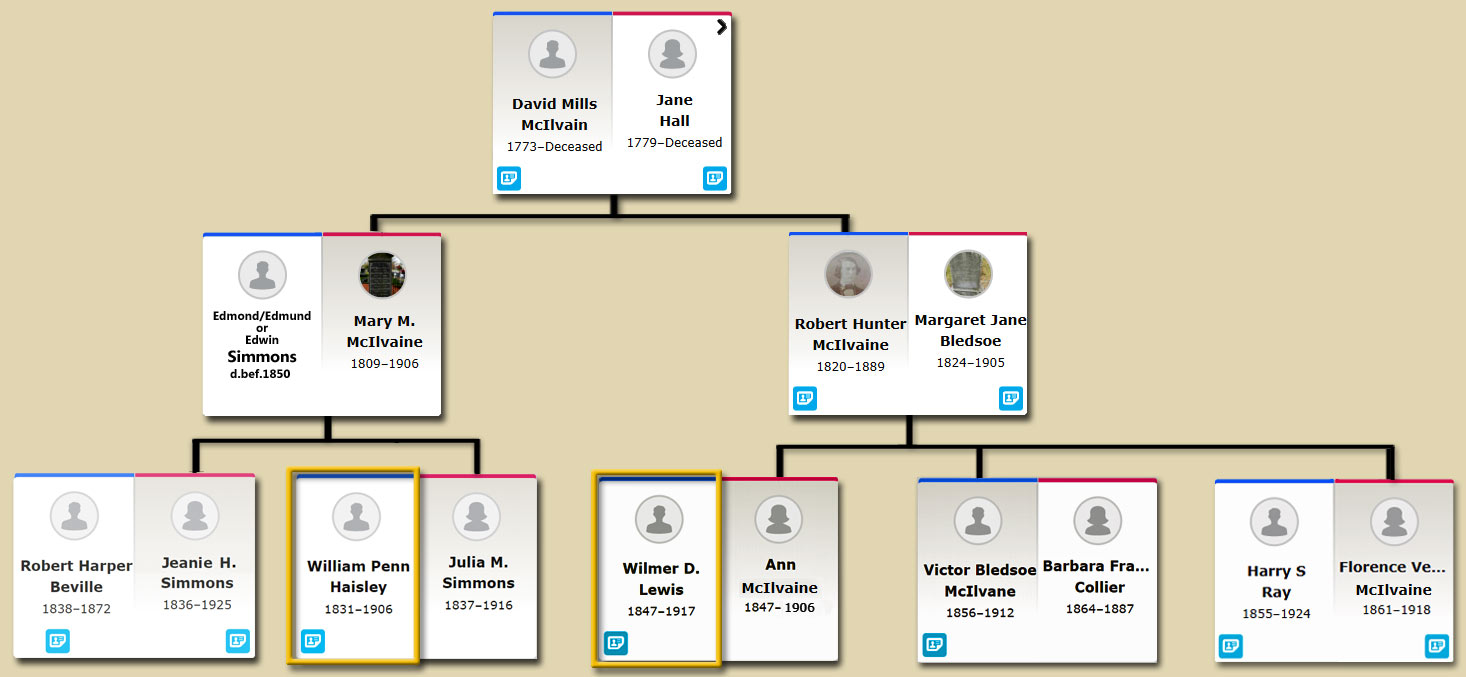
So, was W.
D. Lewis
really a
nephew of W.
P. Haisley?
No.
They were of
the same
generation
so they
would have
been
cousins, and
at that,
there was no
bloodline
tie between
them.
They were
separated by
TWO degrees
of
marriage-they
were
"cousins-in-law-in-law."
(Their wives
were
1st-cousins.)
|
|
|
|
|
|